Early Los Angeles Drive-in Restaurants
Background In the 1930’s the world went Deco-crazy, and the American drive-in reached its pinnacle. Swirling, modernistic, futurific lines and colors dominated. Drive-ins became fantastical, even outlandish: some were octagonal or cylindrical; others were imbued with silly themes (like windmills or airplanes). Women became valued workers, often clad in campy uniforms and roller skates. Menus were expanded to include fish, vegetables, and desserts. So popular were drive-ins that at one point there were over 200 in greater Los Angeles alone! ++ |
Carpenter's Drive-in (Sunset and Vine)
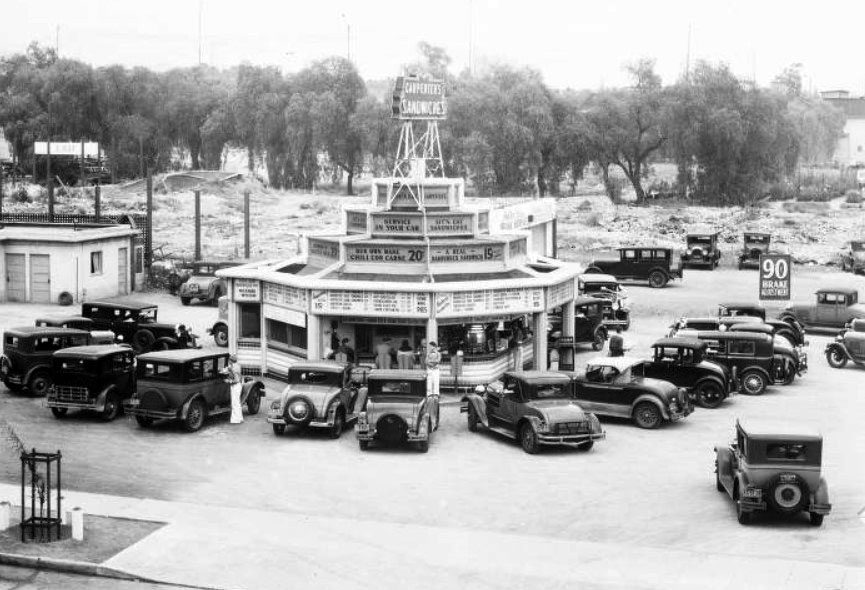 |
|
| (1932)* - Carpenter’s Drive-in Restaurant, located on Sunset Boulevard just east of Vine Street in Hollywood. Photo by ‘Dick’ Whittington |
Historical Notes The Carpenter’s Sandwiches Drive-in seen above was located at 6265 Sunset Boulevard between Vine Street and Argyle Avenue in Hollywood. For 30 cents you could enjoy a hamburger and wash it down with a cup of beer while sitting behind the wheel of your car (5 cents more for the premium beer). |
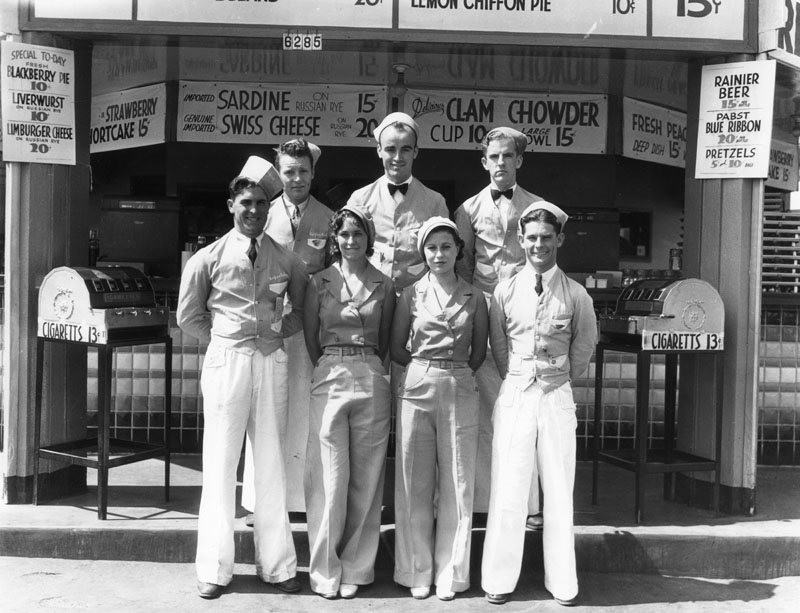 |
|
| (1933)* - Carhops pose for the camera in front of Carpenter's Sandwich Drive-in restaurant, located near the NE corner of Sunset and Vine. |
Historical Notes Harry B. Carpenter founded the Carpenter's chain with his brother Charles and operated many locations in Los Angeles including: Sunset and Vine, Wilshire and Western, Wilshire and La Cienega, Wilshire and Vine, Pico and Vermont, Silver Lake and Glendale and Sunset and Virgil.* |
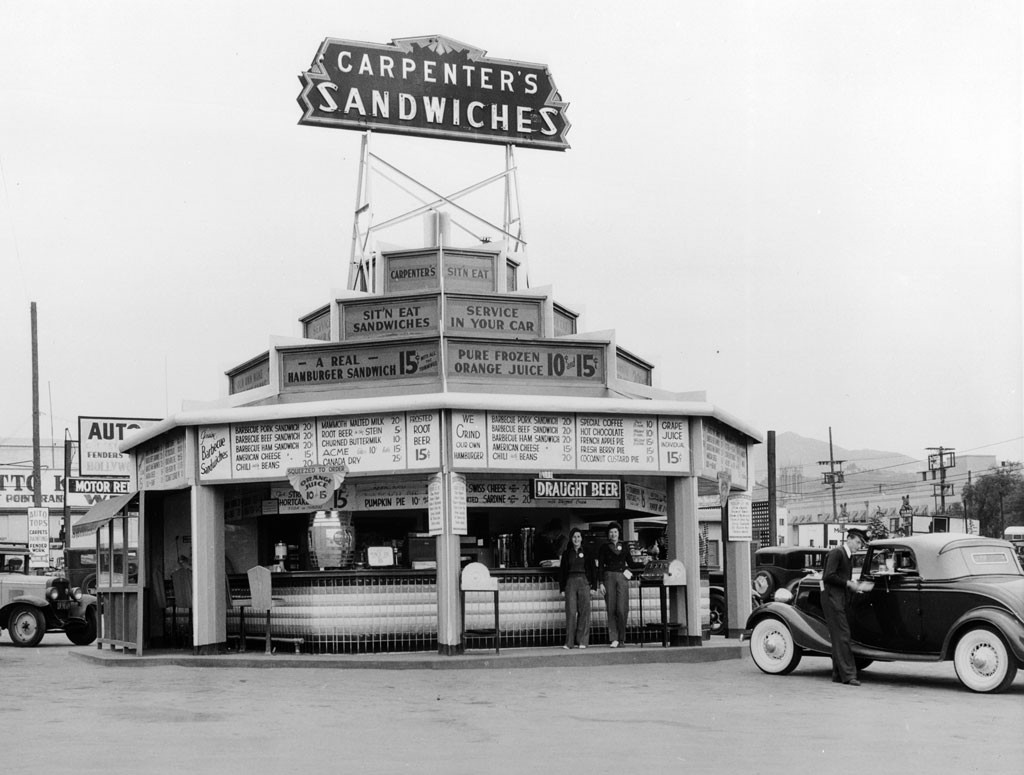 |
|
| (ca. 1930s)* - View of Carpenter's Drive-in showing two carhops standing by the counter while another to the right appears to be serving food. |
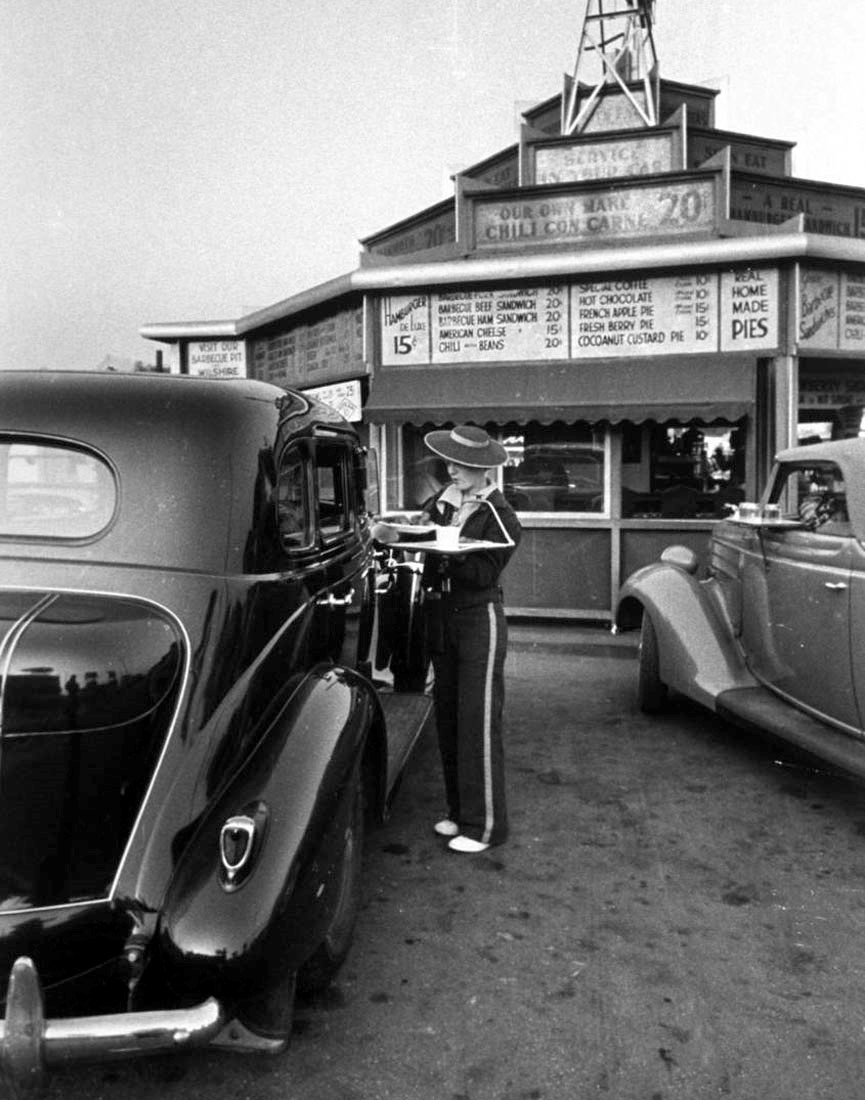 |
|
| (1936)#* - Carpenters Sandwiches, Sunset Boulevard and Vine Street. Note the change in style of carhop uniforms. |
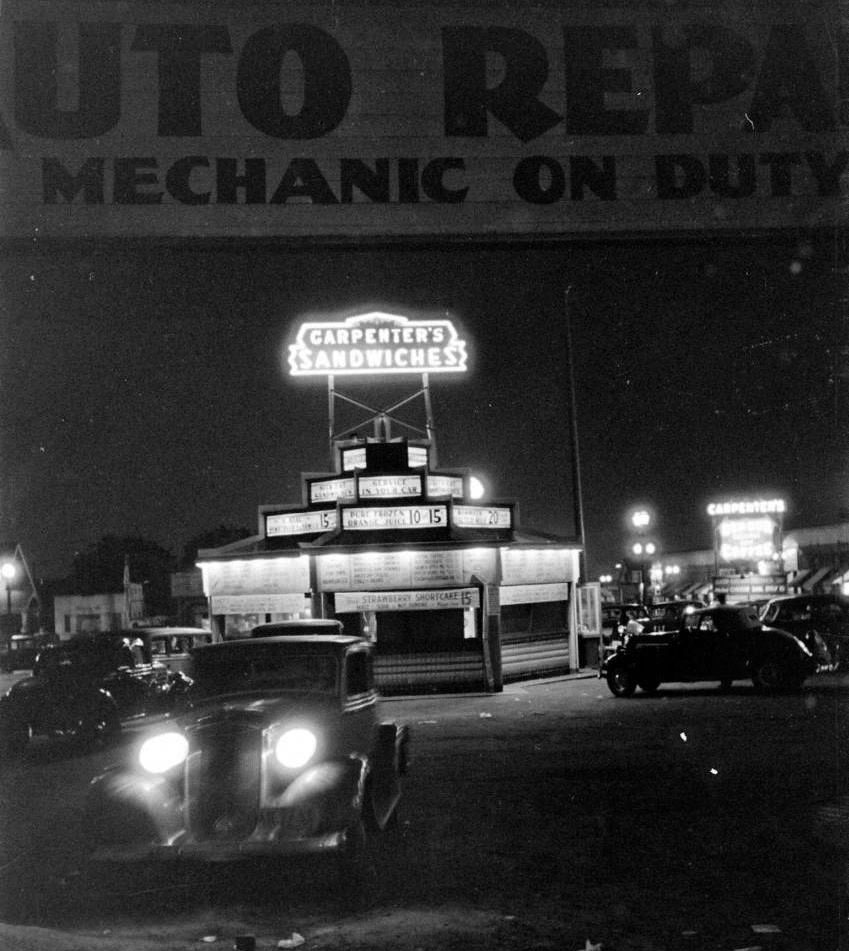 |
|
| (1930s)+#+ - Nighttime view looking south toward Sunset Boulevard showing Carpenter's Sandwich Drive-in as seen from the auto mechanic shop next door. |
 |
|
| (1930s)^ – Nighttime view of Carpenter’s Sandwich located at on the north side of Sunset between Vine and Argyle. Signs read: Ben Hur Delicious Drip Coffee, Sirloin Steak Sandwich - 25 Cents, Fried Oyster Sandwich - 20 Cents, Hot Fudge Sundae - 25 Cents, and “A Real Hamburger Sandwich” - 15 Cents. |
Historical Notes Originally located near the northeast corner of Sunset and Vine (6265 Sunset Blvd), Carpenter’s would be torn down to make room for the new NBC Radio City building, constructed in 1938. Shortly thereafter, Carpenter’s was reincarnated across the street on the southeast corner of Sunset and Vine (6290 Sunset Blvd). |
 |
|
| (1930s)+#+ – View looking north from behind a neon sign for Eastside Beer located on the SE corner of Sunset and Vine. Carpenter’s Sandwiches Drive-in can be seen across the street at a location that would become NBC Radio City. A new Carpenter's would be built right here on the SE corner, where this picture was taken from. In the distance can also be seen the neon signs for The Broadway-Hollywood and the Hollywood Plaza Hotel. |
Carpenter's Drive-in (Wilshire and Western)
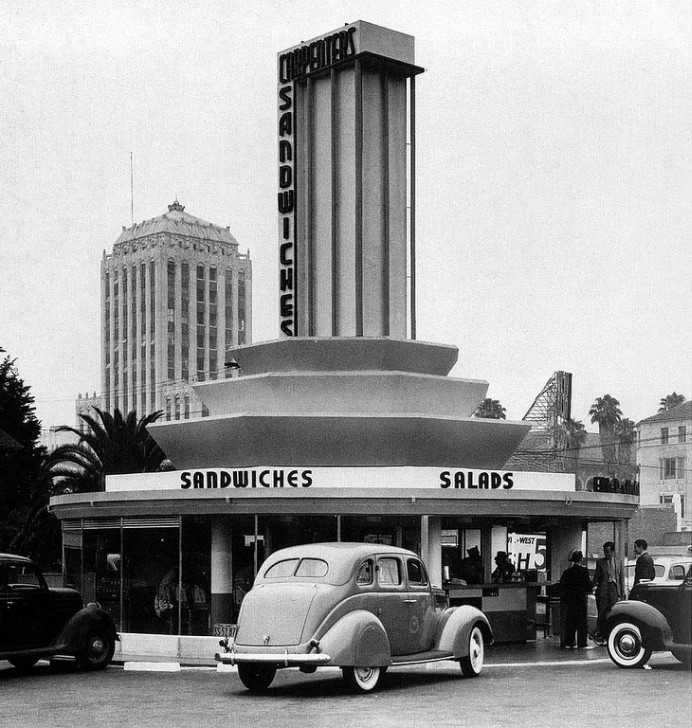 |
|
| (1938)#* - View of the stylish Carpenter's Sandwich drive-in located at Wilshire and Western. The art deco style Wilshire Professional Building stands in the background. |
Historical Notes Harry B. Carpenter founded the Carpenter's chain with his brother Charles and operated many locations in Los Angeles including: Sunset and Vine, Wilshire and Western, Wilshire and La Cienega, Wilshire and Vine, Wilshire and Vermont, Pico and Vermont, Silver Lake and Glendale and Sunset and Virgil.* |
 |
|
| (1937)^x^ – Close-up night view of Carpenter’s Drive-in at Wilshire Blvd and Western Ave, directly across the street from the Wiltern Theatre . |
Carpenter's Drive-in (Wilshire and Vermont, NW Corner)
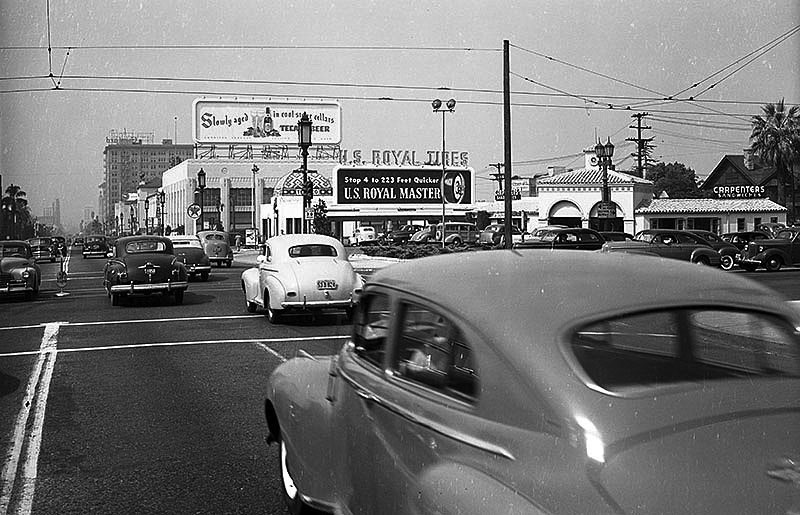 |
|
| (1947)*#* – View looking west on Wilshire Boulevard at Vermont Avenue. Carpenter’s Drive-in is seen on the northwest corner. |
Historical Notes Between 1905 and 1928, the Burkhard Residence would stand on the northwest corner of Wilshire and Vermont. The lot would sit empty for a while and then be occupied by a florist shop and billboard for a short 5 years (1928 – 1933). The building that went up on the site in 1933 was first occupied by restaurateur Harry Bogen; two years later, it became a branch of the popular Carpenter's Drive-in chain. |
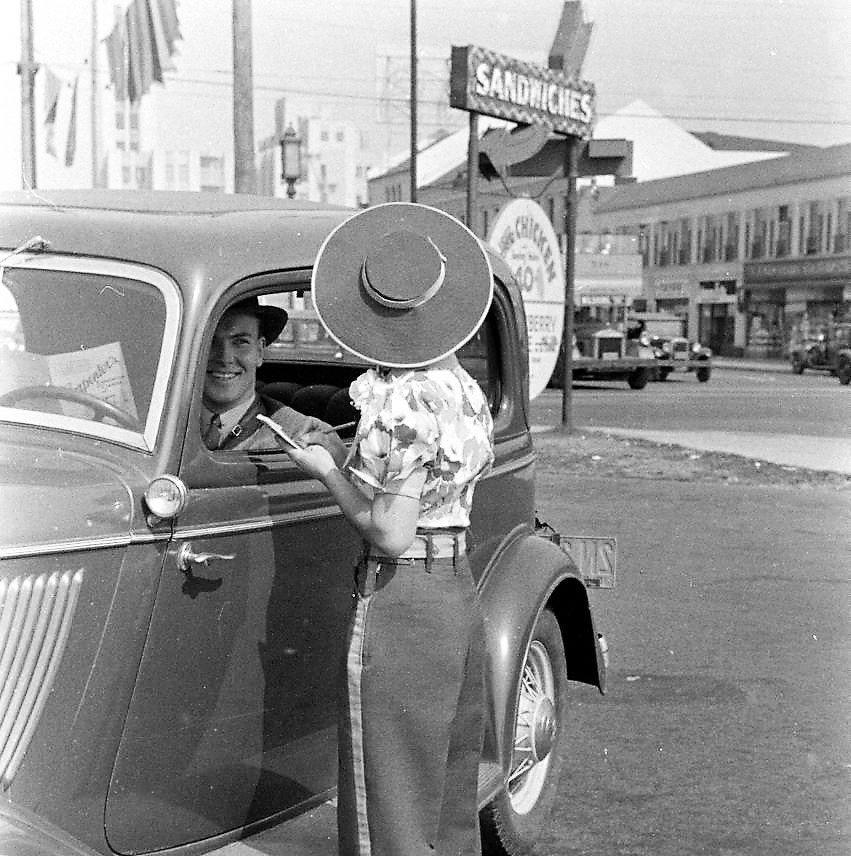 |
|
| (ca. 1935)^** – A waitress takes an order from a smiling customer sitting behind the wheel of his car at the Carpenter’s Drive-in located on the NW corner of Wilshire and Vermont. In the background, we can see the Bullock's Wilshire department store (3050 Wilshire Blvd). |
.jpg) |
|
| (ca. 1935)^** - A busy waitress serves a customer at Carpenter's Drive-In Restaurant on the corner of Wilshire Blvd and Vermont Ave. The Bullock's Wilshire is seen in the background. |
Carpenter's Drive-in (606 E. Colorado)
 |
|
| (ca. 1938)* - According to signage, this Carpenter's drive-in restaurant features fried chicken, sandwiches, year round fresh fruit pies, breakfast, hamburgers and fountain service, but no cocktails. The Rite Spot Cafe pylon is seen in the background. |
Historical Notes In 1936, after separating from his brother, Charles E. Carpenter opened three Carpenter's Cafes. A transitional project Carpenter's Village (606 E. Colorado) combined a Rite Spot Cafe and Carpenter's Drive-in. Next he opened the Rite Spot Cafe in Pasadena, located at 1500 West Colorado Street (now considered Eagle Rock) and the Santa Anitan Cafe at Huntington and Colorado.* |
* * * * * |
Harry Carpenter's Drive-in (Sunset and Vine, SE Corner)
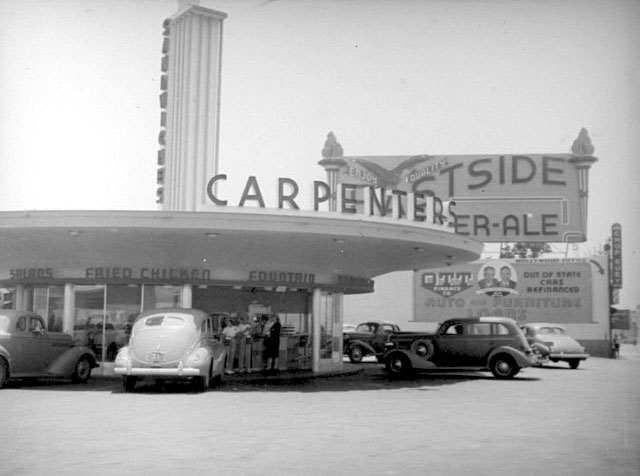 |
|
| (ca. 1938)^** – View looking south showing the newly built Carpenter’s Drive-in Restaurant located on the southeast corner of Sunset Boulevard and Vine Street in Hollywood. |
Historical Notes This Carpenter's Drive-in replaced the one located near the northeast corner of Sunset and Vine (6265 Sunset Blvd), which was torn down in 1938 to make room for the new NBC Radio City building. |
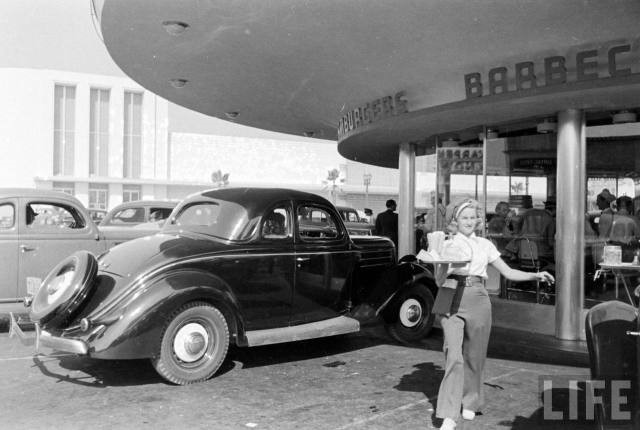 |
|
| (ca. 1938)^** – Life Magazine photo showing a carhop carrying a tray of food at Carpenter's Drive-in, with a 1936 Ford coupe seen on the left. In the distance, across Sunset Boulevard, stands the recently completed NBC Radio Studios. |
Historical Notes Carpenter’s was a chain of drive-in restaurants —there were six or seven locations—but this was probably the best known because it sat on the southeast corner of Sunset Boulevard and Vine Street in Hollywood, which put it across the street from the iconic NBC Radio Studios. |
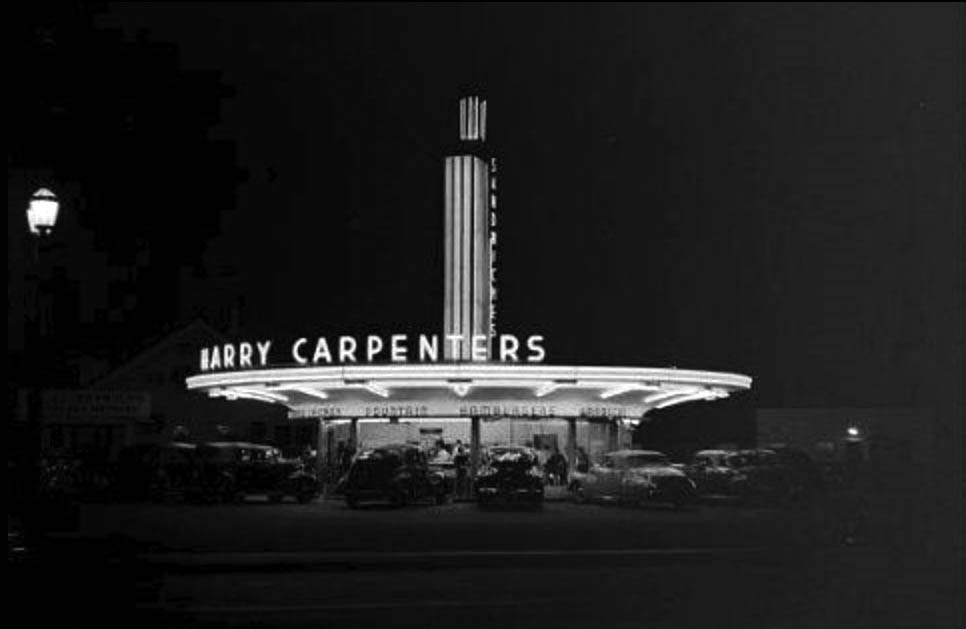 |
|
| (1940s)##^* – Night view showing cars parked at the beautiful saucer-shaped Harry Carpenter's Drive-in, on the southeast corner of Sunset and Vine, 6290 Sunset Boulevard. |
Historical Notes Between 1931 and 1961, three different drive-in restaurants occupied the southeast corner of Sunset and Vine: |
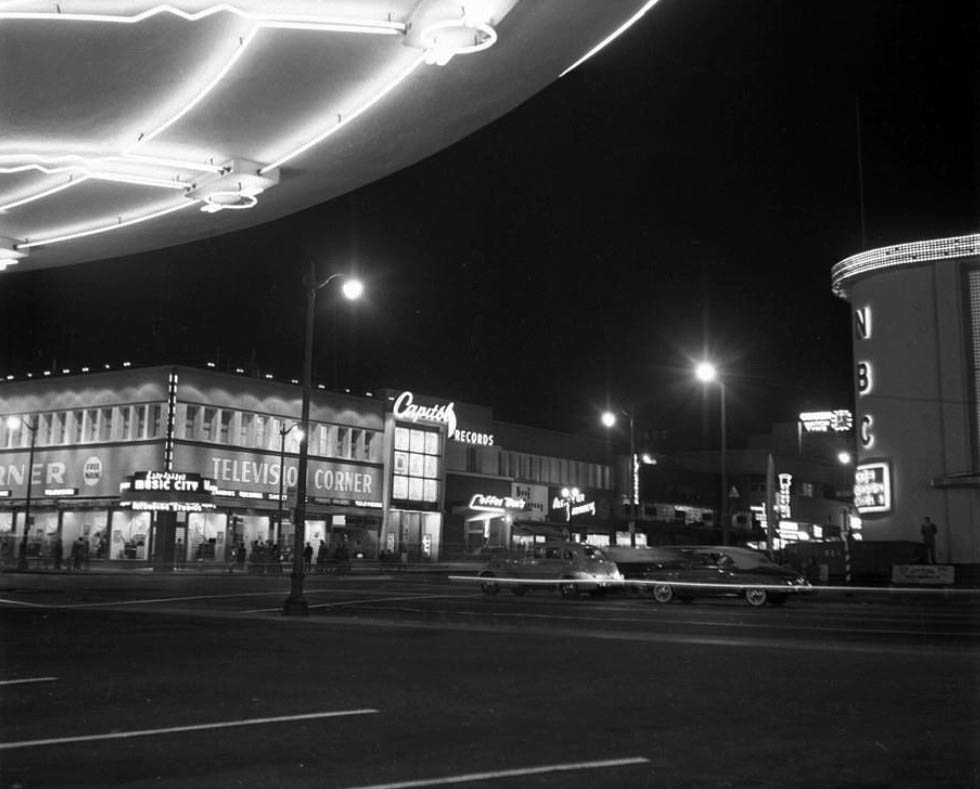 |
|
| (1940s)##^* – View looking northwest toward the intersection of Sunset and Vine from the front of Carpenter’s Drive-in Restaurant located on the SE corner. NBC Radio City is across the street to the right (NE corner) while Wallichs Music City is seen on the left (NW corner). |
* * * * * |
McDonnell's Drive-in (Sunset and La Brea)
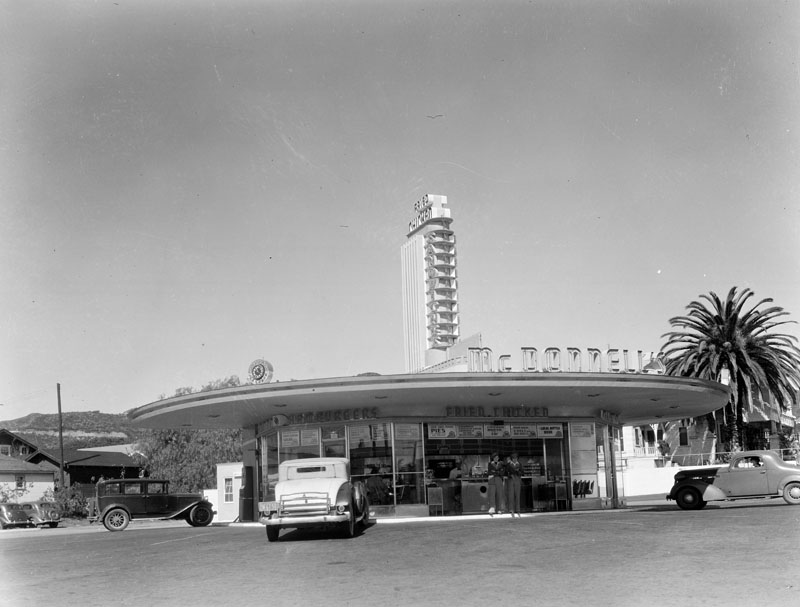 |
|
| (1930s)* - View showing McDonnell's Drive-in located on the northwest corner of Sunset and La Brea ( (Not to be confused with McDonald's fast food restaurants of today). Tiny Naylor's Dirve-in would be built on this corner in 1949. |
Historical Notes "Rusty" McDonnell operated a chain of drive-ins in the Los Angeles area during the 30s and 40s, long before the fast food behemoth McDonalds came on the scene. His restaurants, designed by the revered architect Wayne McAllister, were fabulously kitsch and garish and customers could spot their huge neon signs from miles away.++^ |
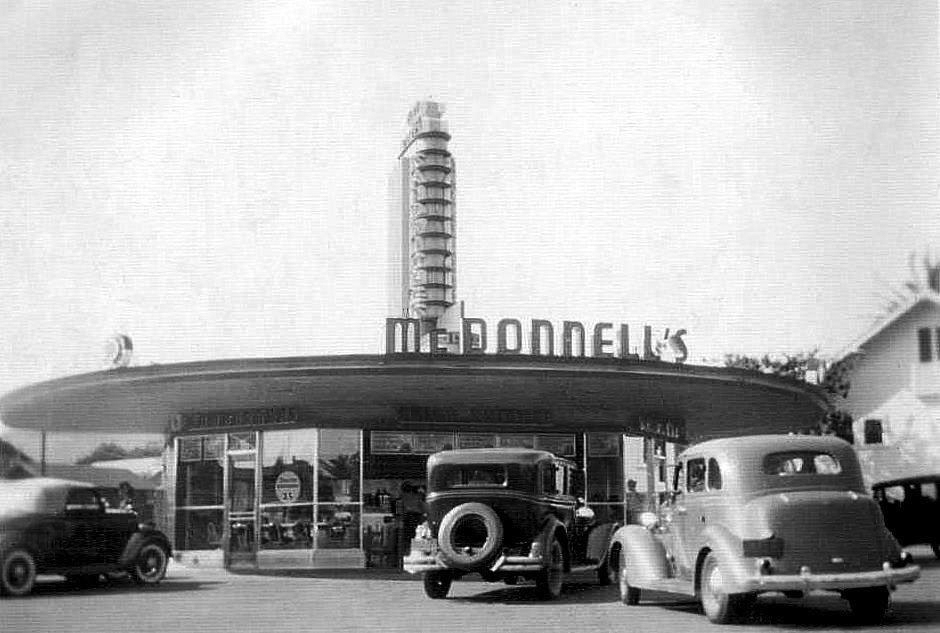 |
|
| (1930s)#**# - Close-up view showing cars parked at McDonnell's Drive-in at Sunset and La Brea, NW corner. |
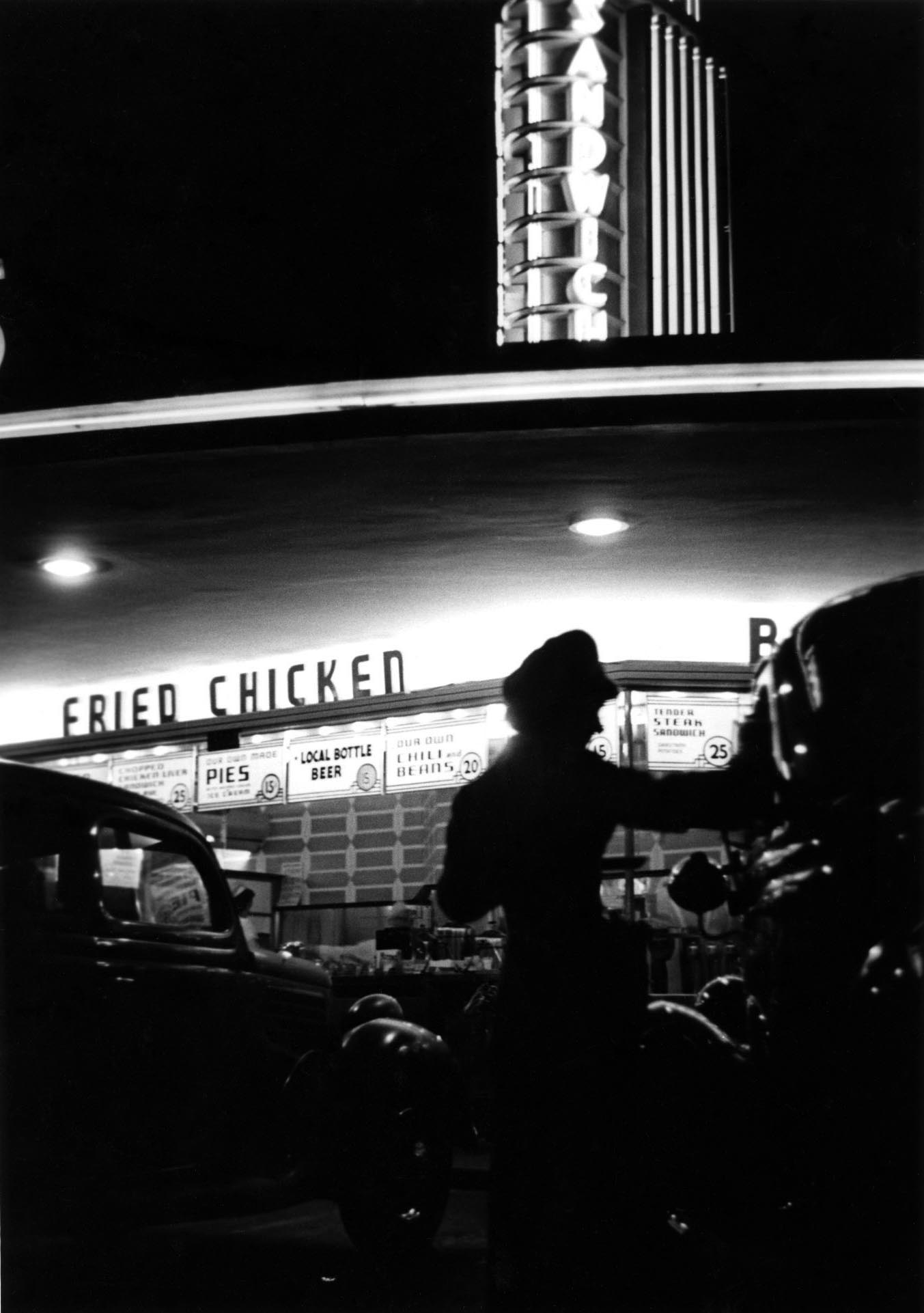 |
|
| (1930s)#*#* – Night view showing a carhop serving food at the Sunset and La Brea McDonnell's Drive-in. |
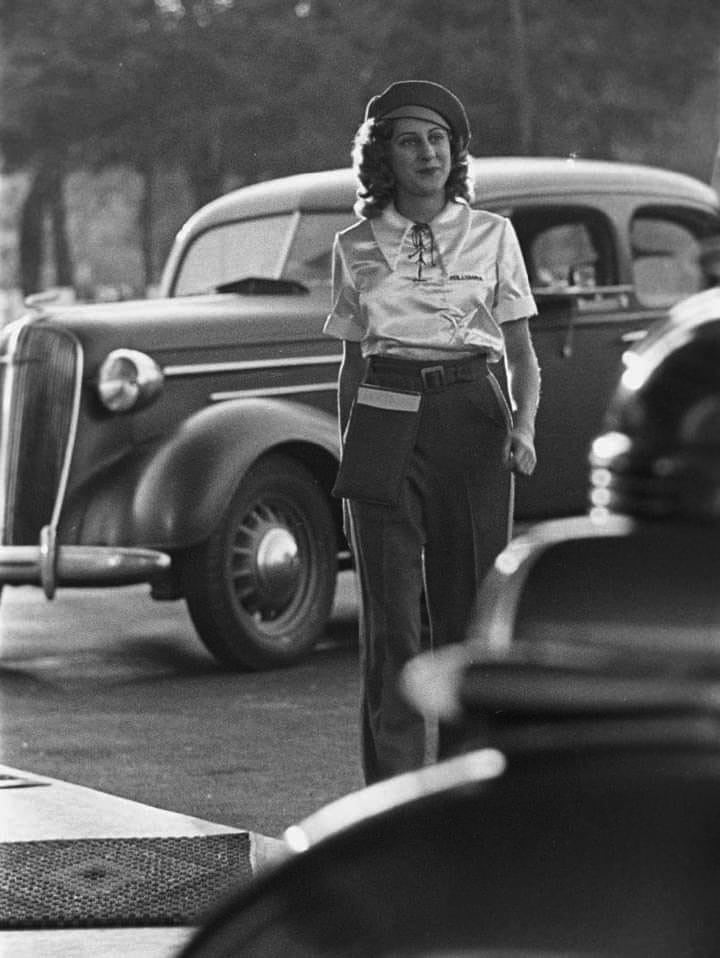 |
|
| (1930s)^.^ - Carhop looking spiffy heads back to the counter with a 1937 Chevrolet in the background. She seems to be enjoying her job. |
McDonnell's Ever Eat Drive-in (Beverly and La Brea)
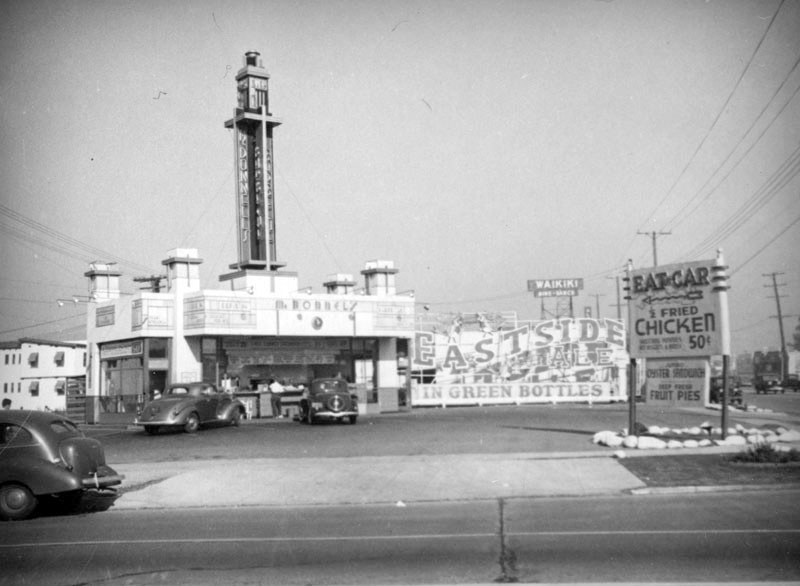 |
|
| (ca. 1937)* - Exterior view of a McDonnell's drive-in, located at Beverly Boulevard (foreground) and La Brea Avenue (right), with two cars parked directly in front. The restaurant's sign at the corner reads "Eat in Car, 1/2 fried chicken, 50 cents, Oyster sandwich, and fresh fruit pies." To the right of the drive-in is an advertisement for Eastside Ale, and in the distance, the sign for Waikiki restaurant, at 335 N. La Brea Avenue, is visible. |
Historical Notes Other McDonnell's "Drive-Inns" were located at Beverly Boulevard & Western Avenue, Wilshire and Robertson boulevards, Yucca Street and Cahuenga Boulevard, Wilshire Boulevard and Fairfax Avenue, and Sunset Boulevard and La Brea Avenue. The McDonnell's restaurants throughout Los Angeles were: McDonnell's Monterey (7312 Beverly Boulevard); McDonnell's Wilshire (Wilshire Boulevard and La Brea Avenue); McDonnell's Fairfax (Fairfax Avenue and Wilshire Boulevard); McDonnell's Gates Hotel (Sixth and Figueroa streets); McDonnell's Hillstreet (454 S. Hill Street); McDonnell's Figueroa (4012 S. Figueroa Street); McDonnell's Adams and Figueroa (2626 S. Figueroa Street); and McDonnell's Pico Street (Pico and Hope streets). * |
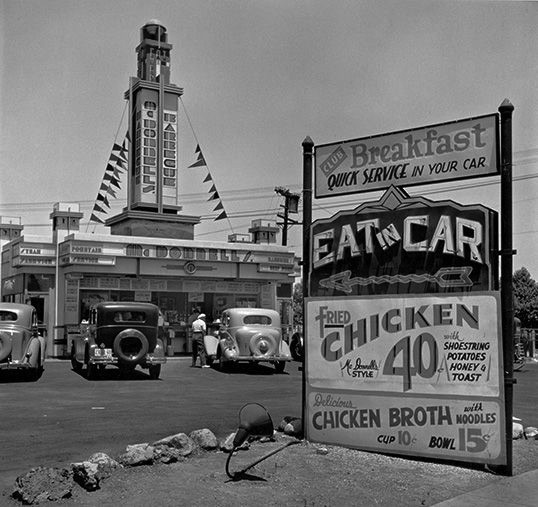 |
|
| (1935)##+ - View showing cars parked in front of McDonnell's Drive-in. Large sign reads: EAT IN CAR - Fried Chickn, Mc Donnells Style 40 cents - with Shoestring Potatoes, Honey & Toast; Chicken Broth with Noodles - Cup 10 cents, Bowl 15 cents. |
Historical Notes The restaurant served some of the best fried chicken in the state, raising its own chickens on a 200 acre ranch at Daggett, California. McDonnell's survived until the 50s before sadly closing down. ++^ |
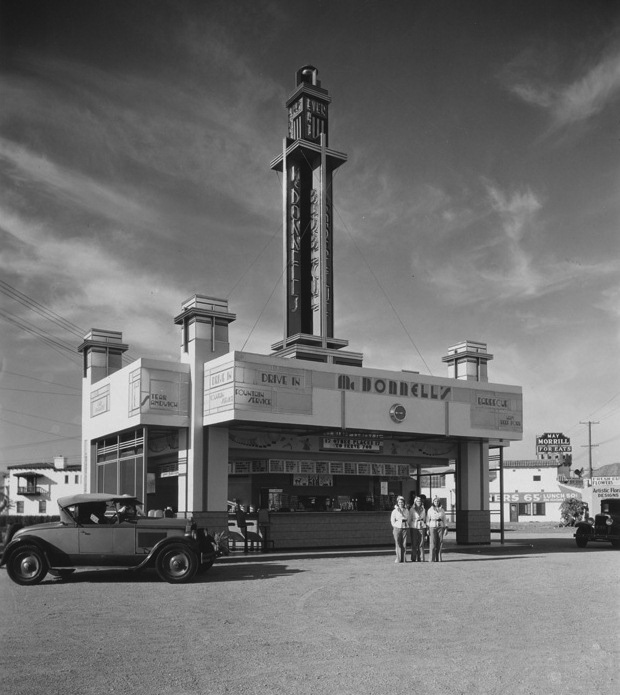 |
|
| (1931)*^^ - The staff of the McDonnell’s Ever Eat Drive-in at Beverly and La Brea stand at attention, waiting for customers. |
Historical Notes McDonnell employed a local artist to sketch whimsical interpretations of the car-hops or waiters that served cokes, hamburgers and fries to customers for its menus.++^ |
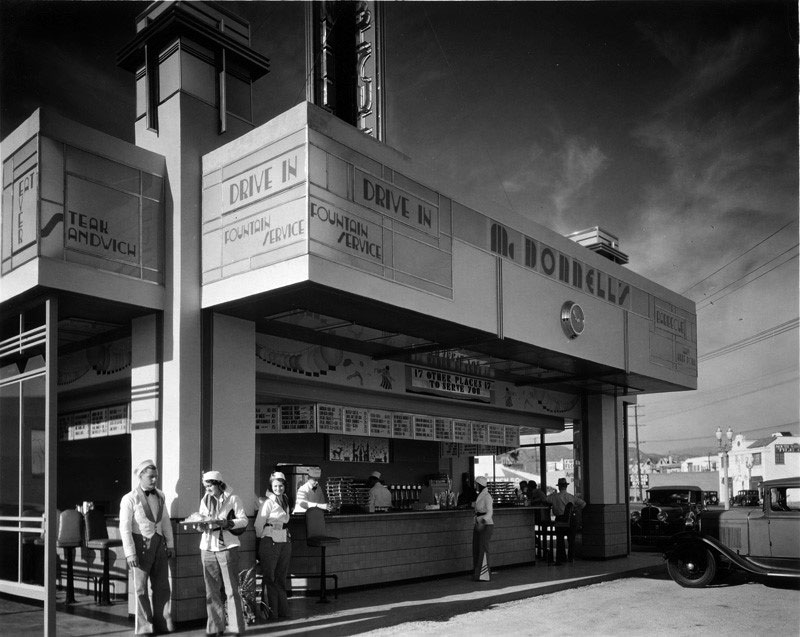 |
|
| (ca. 1931)^*# – Close-up view showing Mc Donnell’s Drive-in on the corner of Beverly and La Brea. Sign above the counter reads: “17 Other Places to Serve You”. |
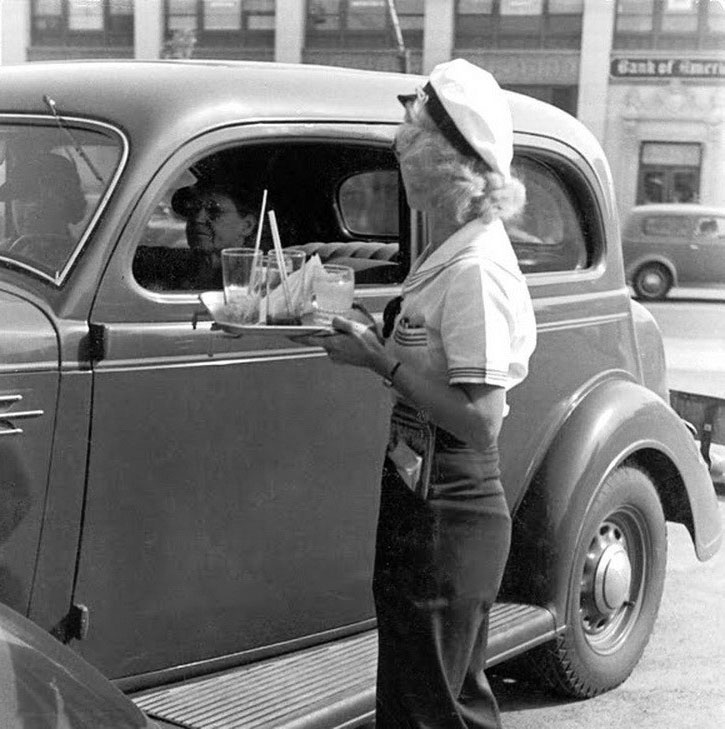 |
|
| (1936)#++ - View showing a carhop picking up tray from driver of auto. |
* * * * * |
McDonnell's Sandwiches Drive-in (Beverly and Western)
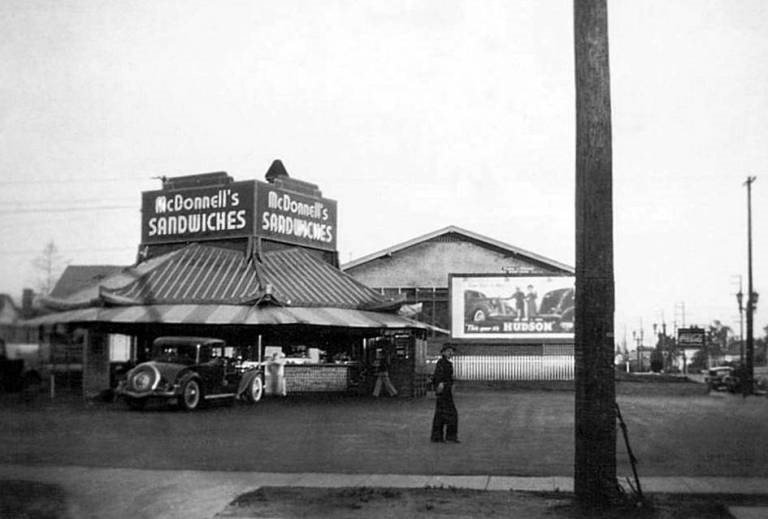 |
|
| (ca. 1935)* – View showing McDonnell’s Drive-in located on the corner of Beverly & Western, Walter Wetzel in foreground on way to work as dishwasher. (Wetzel family collection) |
* * * * * |
Simon's Drive-in (Wilshire and Fairfax, NW Corner)
 |
|
| (1939)* - View showing Simon's Drive-in Restaurant on the northwest corner of Fairfax Avenue and Wilshire Boulevard. This is an engineering notebook photoprint taken from top deck of Wilshire Boulevard Bus. |
Historical Notes Simon's Drive-In Restaurant was built in 1935 and looks very similar to many of the other drive-ins built in the 1930s. That's because so many of these futuristic looking drive-ins were designed by architect Wayne McAllister. Wayne McAllister was a Los Angeles-based architect who was a leader in the Googie style of architecture that embraced the automobile and the Space Age. Inspired by tail fins and gleaming chrome, he elevated the drive-in restaurant to futuristic works of art. He created iconic circular drive-in restaurants in Southern California, including Simon's, Herbert's, Robert's, and McDonnell's in the 1930s. |
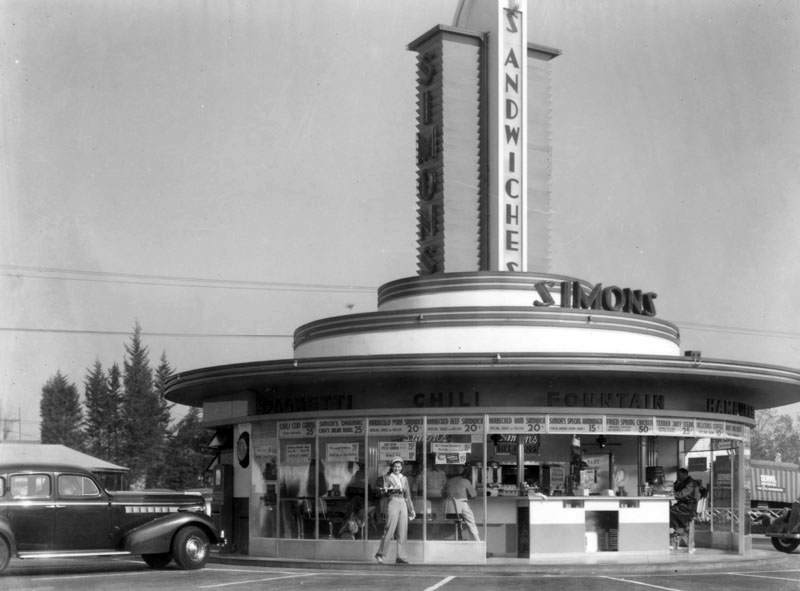 |
|
| (1939)* - A daytime view of Simon's Drive-In Restaurant located on the northwest corner of Fairfax and Wilshire. Through the glass floor-to-ceiling windows, patrons can be seen sitting at the circular counter having their meals. "Spaghetti", "Chili", "Fountain", "Hamburgers" and "Barbecue" can be seen above the windows. A carhop is standing at front, holding food in her hand. |
Historical Notes At one time Simon's Drive-Ins dominated the Southern California drive-in restaurant craze. The Simon brothers had operated a chain of successful dairy lunch counters in downtown Los Angeles, and in 1935 decided to capitalize on the growing car culture of Los Angeles by opening auto friendly locations in the emerging commercial centers of Wilshire Boulevard, Sunset and Ventura Boulevards. |
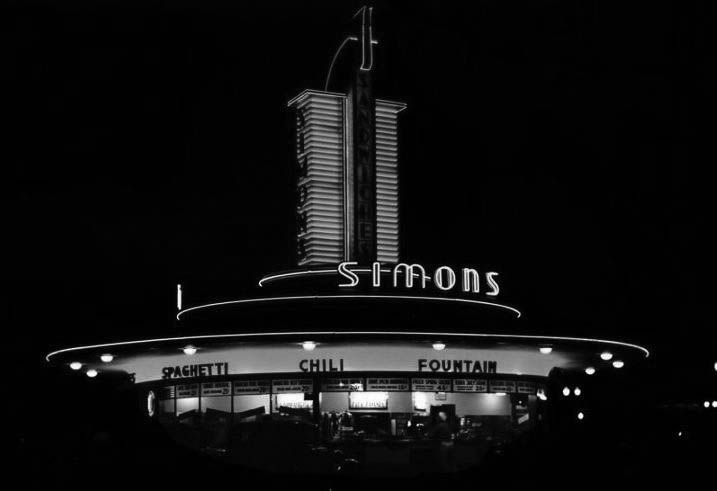 |
|
| (ca. 1940s)* - Night view of Simon's drive-in located on the northwest corner of Fairfax and Wilshire. The Streamline Moderne style ciruclar structure was designed by renowned architect Wayne McAllister. |
Historical Notes This is the same corner where the 1950s Johnie's Coffee Shop now stands. Across the street is the old May Company Building which is now a part of LACMA/the Hollywood Museum. Going back even further, the DeMille Airfield No.2 (later Rogers Airport) was located at this same Fairfax/Wilshire site in the early 1920s. |
 |
|
| (ca. 1948)* - Couple of jitter-bugs down at Simon's Drive-In wowing the waitress with their zebra-stripe upholstery. Ah, those were the days! |
* * * * * |
Simon's Drive-in Restaurant (Sunset and Highland, SE Corner)
 |
|
| (1939)*– Simon’s Drive-in Restaurant located on the SE Corner of Sunset and Highland (6760 Sunset Blvd). Customers sit at the counter as well as outside in their car. Source: Huntington Library which incorrectly locates this Simon's at Wilshire and Fairfax. Photo by Dick Whittington |
Historical Notes This Simon's became a Stan's Drive-in in 1951. Click HERE to see more. |
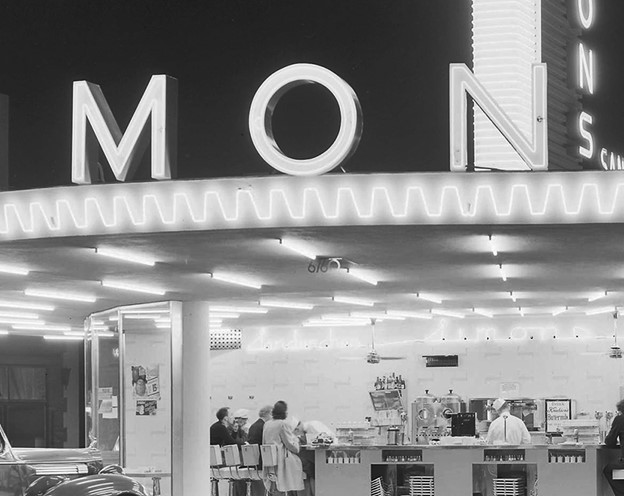 |
|
| (1939)*– Close-up look at Simon’s Drive-in Restaurant located on the SE Corner of Sunset and Highland. Note the house number hanging from the ceiling, confirming it as 6760 Sunset (at the southeast corner of Highland). |
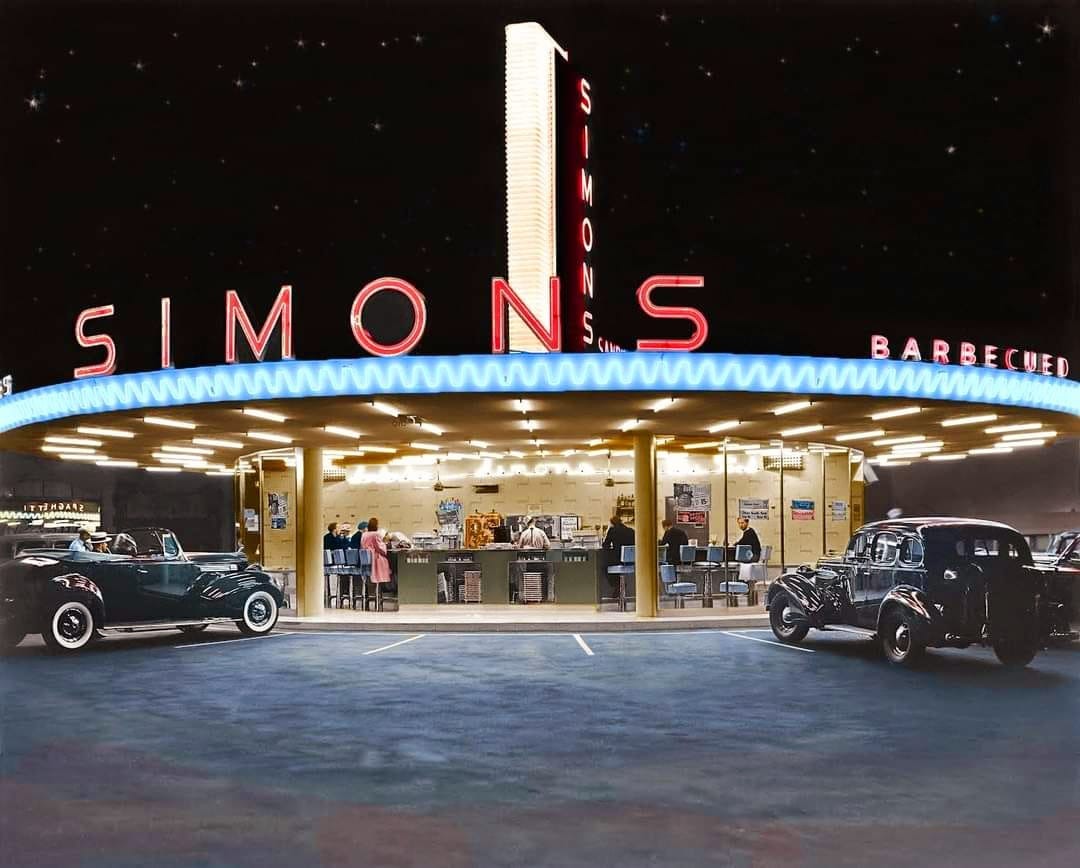 |
|
| (1939)* – Simon’s Drive-in Restaurant located on the SE Corner of Sunset and Highland (6760 Sunset Blvd). Customers sit at the counter as well as outside in their car. Source: Huntington Library which incorrectly locates this Simon's at Wilshire and Fairfax. Photo by Dick Whittington |
* * * * * |
Simon's Drive-in (El Monte)
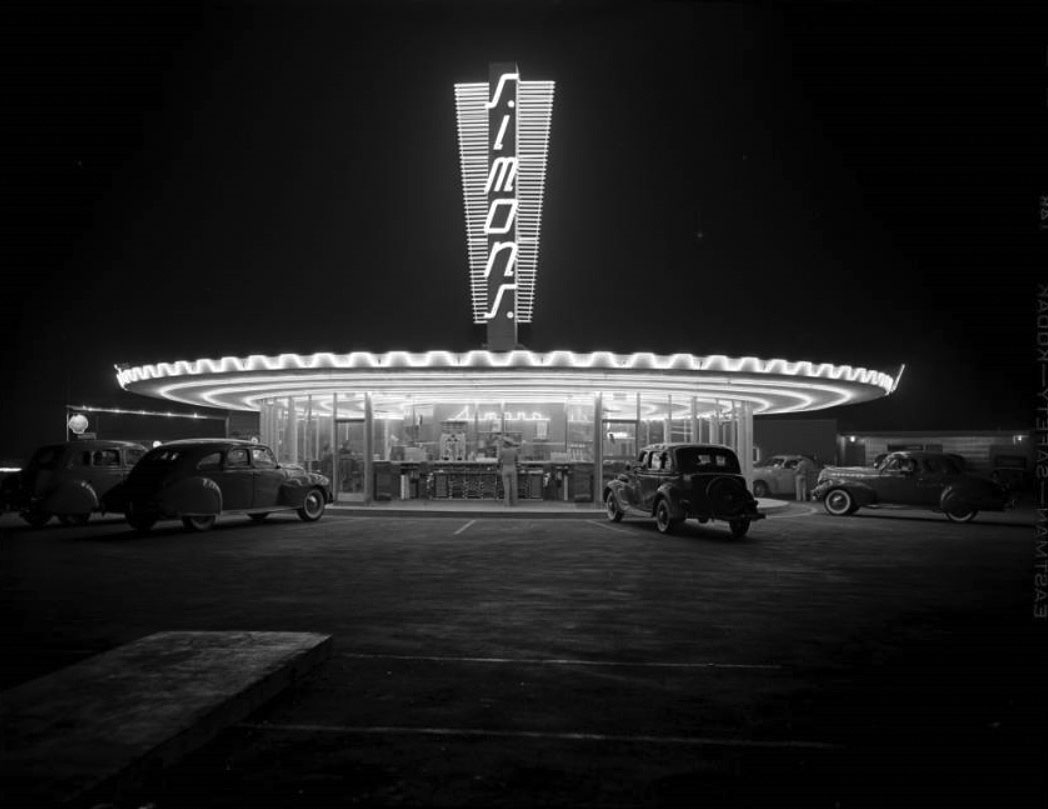 |
|
| (1940s)* – View showing the Simon’s Drive-in Restaurant in El Monte. Photo by Doug White of SCE |
Historical Notes In the 1930s, Wayne McAllister, the originator of the circular drive-in, designed circular Simon's Drive-in Restaurants in the Streamline Moderne style with a three-layer roof and neon advertising pylon; this style was copied throughout the country. |
* * * * * |
Simon's Drive-in (Wilhsire and Hoover, SW Corner)
 |
|
| (1940s)*^ - View of Wilshire Boulevard facing east as seen from the top of the Sheraton Town House. Lafayette Park is on the left. Simon's Drive-in Restaurant is across the street on the right, southwest corner of Wilshire and Hoover Street. |
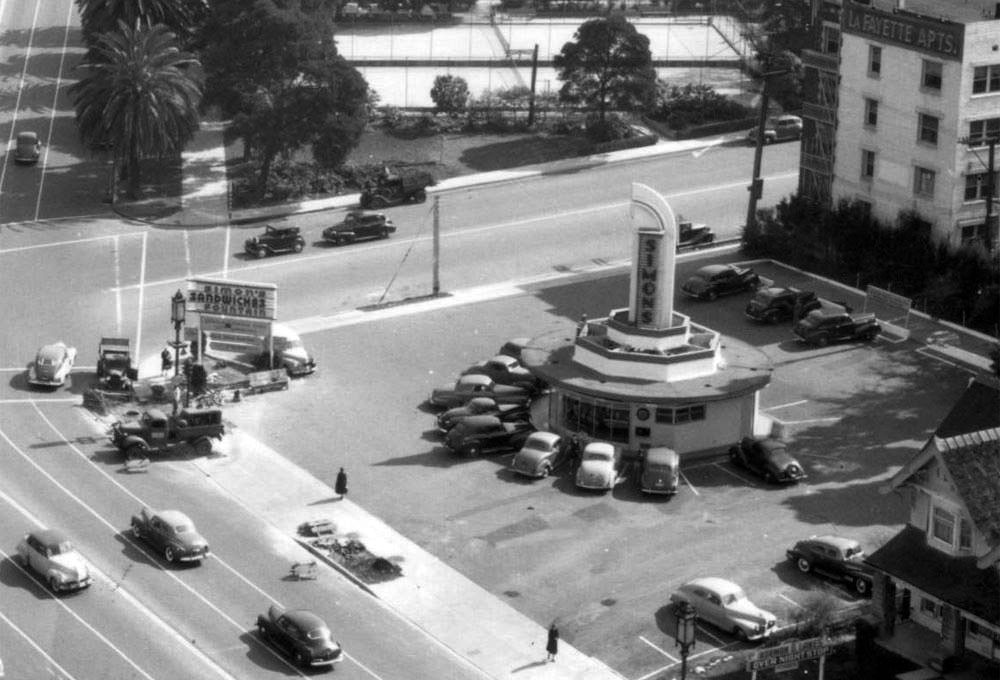 |
|
| (1940s)^.^ – Closer view of the Simons Drive-in Restaurant on the southwest corner of Wilshire Boulevard and Hoover Street as seen from the top of the Sheraton Town House. |
Historical Notes At one time Simon's Drive-Ins dominated the Southern California drive-in restaurant craze. The Simon brothers had operated a chain of successful dairy lunch counters in downtown Los Angeles, and in 1935 decided to capitalize on the growing car culture of Los Angeles by opening auto friendly locations in the emerging commercial centers of Wilshire Boulevard, Sunset and Ventura Boulevards. |
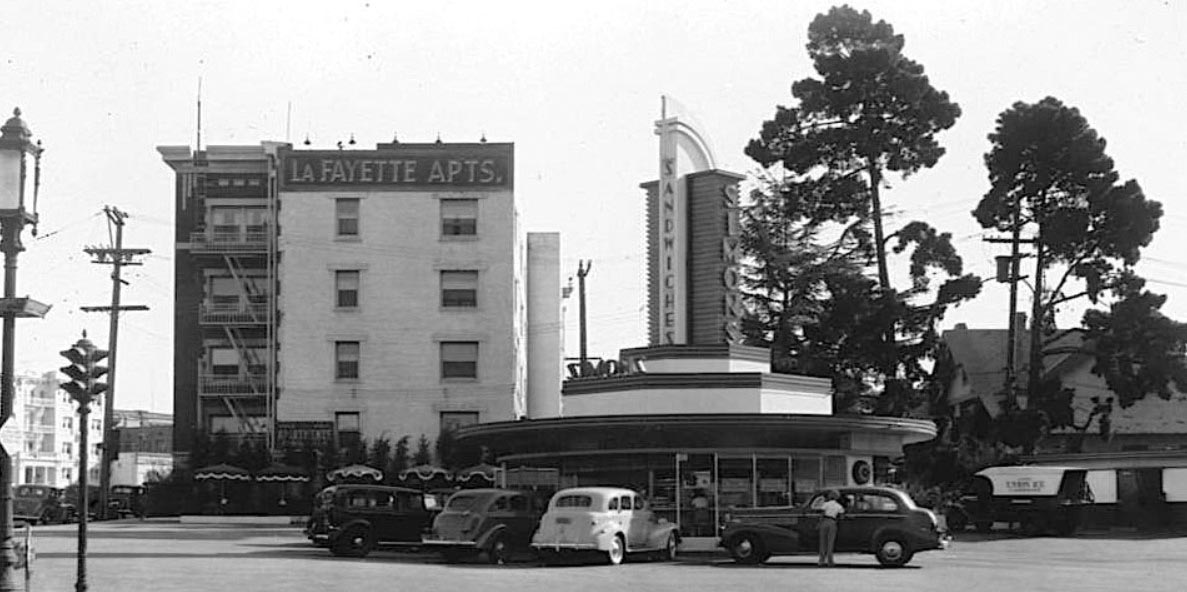 |
|
| (1939)#* – Panoramic view looking south from Wilshire Boulevard showing Simon's Drive-in Restaurant with the La Fayette Apartments behind it. Simon’s was located on the SW corner of Wilshire Boulevard and Hoover Street. In the 1950s it would become Stan's Drive-in. |
Stan's Drive-in (Wilshire and Hoover - formerly Simon's)
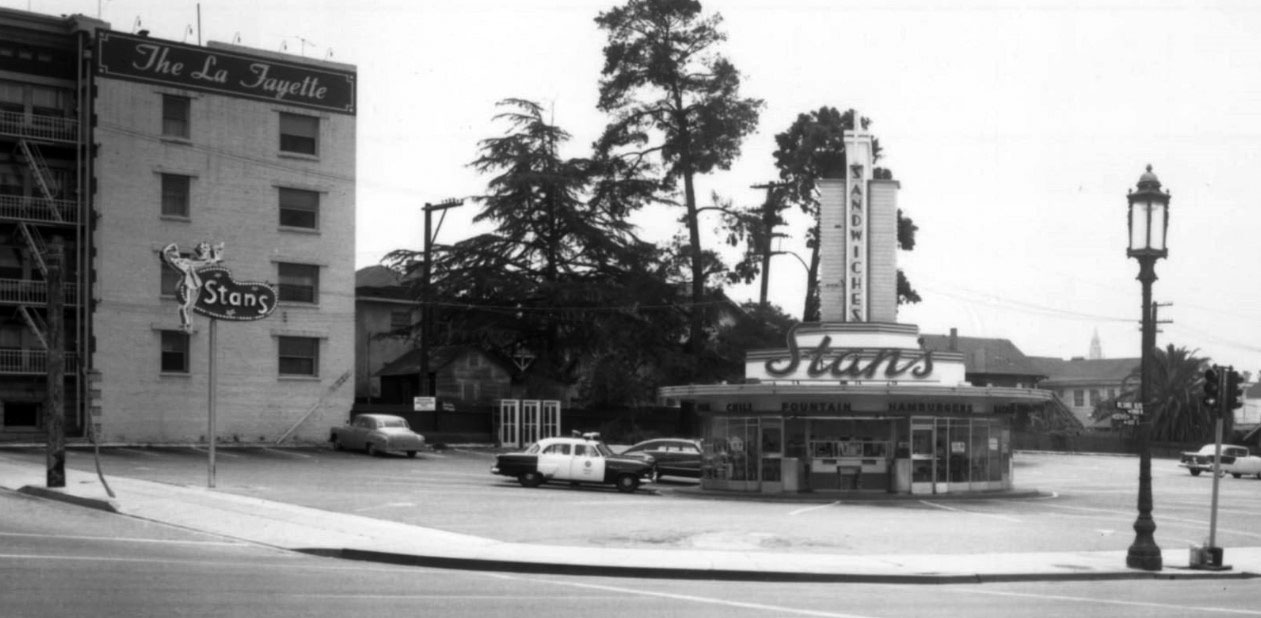 |
|
| (ca. 1956)#* - Stan's Drive-In (formerly a Simon’s), SW corner of Wilshire Boulevard and Hoover, with the La Fayette Apartments seen at left. |
Historical Notes Stan's was a chain of drive-in's with at least a dozen LA locations in the late 1950's and 60's. Many of the original Carpenter’s and Simon’s drive-ins were converted into a Stan’s. |
* * * * * |
Simon's Drive-in (Sunset Strip - later Dolores Drive-in)
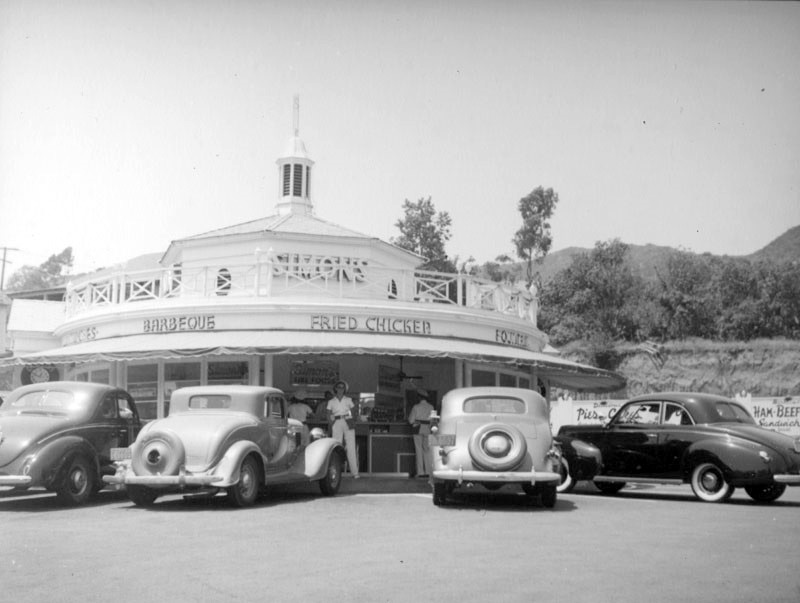 |
|
| (ca. 1938)* - Cars circle this colonial style Simon's, located at 8801 Sunset Boulevard at the corner of Horn Avenue in West Hollywood. The drive-in features fried chicken, barbecue. |
Historical Notes This was a Simon’s Drive-in from 1935 until 1945 when Dolores Drive-in took over. It became Jack’s on the Strip Drive-in sometime in the 1950s. The building stood until the mid-1960s when it was demolished to make way for a succession of music stores, Muntz Stereo and then Tower Records (1971). |
Dolores Drive-in (Sunset Strip - previously Simon's Drive-in)
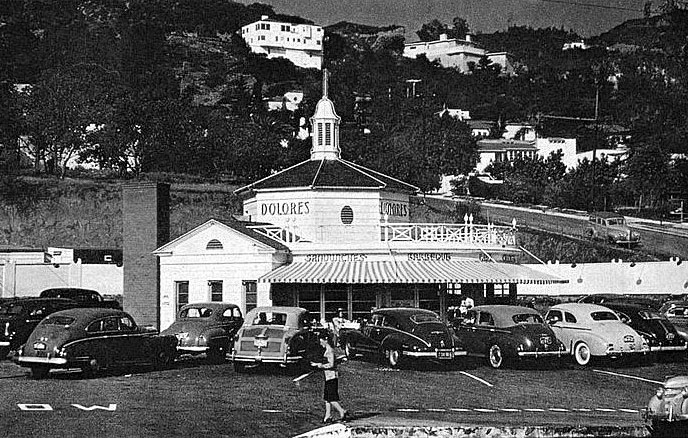 |
|
| (ca. 1945)^** – View showing Dolores Drive-in Restaurant located at 8801 Sunset Boulevard, previously a Simon's Drive-in (1935 - 1945). |
Historical Notes The Strip’s lone drive-in restaurant at the time, it was originally occupied by a branch of the Simon’s chain. The understated colonial-style building was markedly different that the orbit-shaped, neon-ringed Art Deco Simon’s further east at 6760 Sunset Blvd. near Hollywood High School. It opened as Dolores Drive-in here about 1945, its first Los Angeles location. |
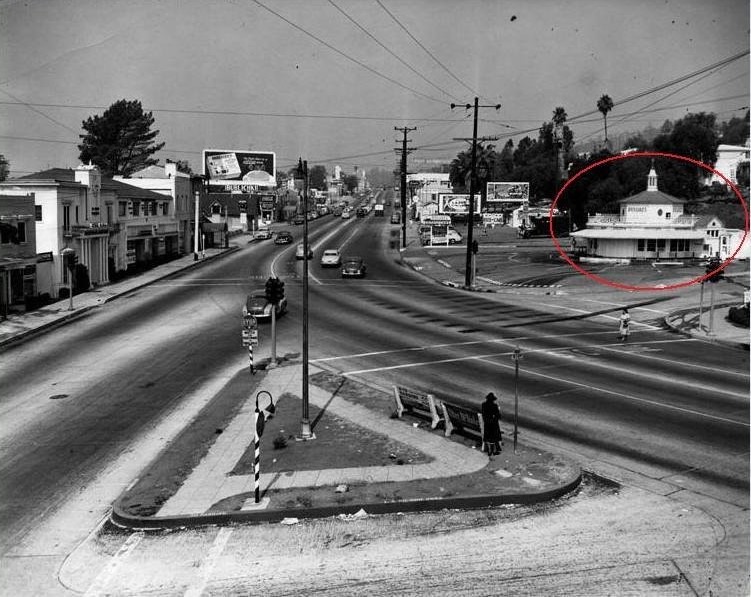 |
|
| (1940)* – Looking west on Sunset Boulevard where it forks with Holloway Drive. Dolores Drive-in is seen on the right, N/W corner of Sunset and Horn Ave. |
Historical Notes Dolores would only last until the 1950s when it became Jack’s on the Strip Drive-in. The building stood until the mid-1960s when it was demolished to make way for a succession of music stores, Muntz Stereo and then Tower Records (1971). Click HERE to see more Early Views of LA Drive-in Restaurants. |
Dolores Drive-in (Beverly Hills)
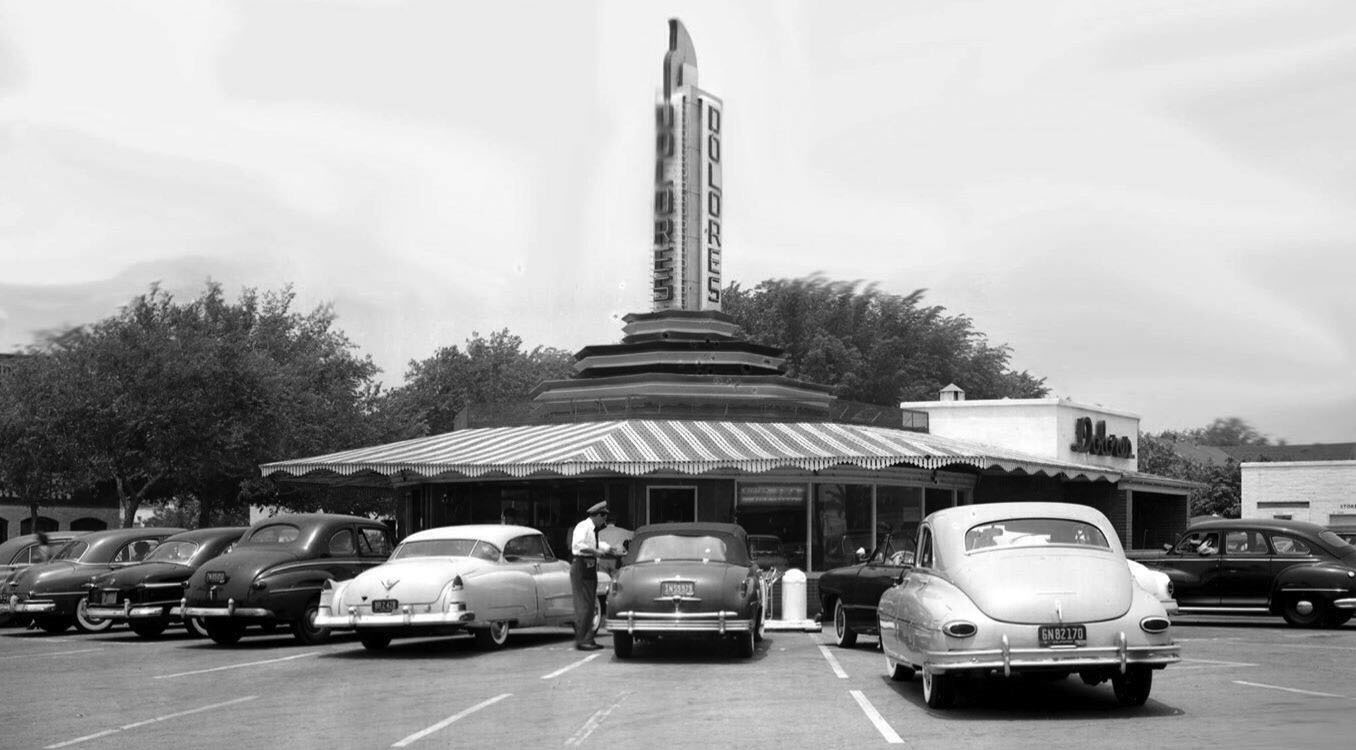 |
|
| (ca. 1949)^.^ - Dolores Drive-in located near the northwest corner of Wilshire Blvd and La Cienega Blvd. Technically, Dolores was at 8531 Wilshire, which put it on the corner of Le Doux Road. But it looks like there was a Richfield gas station right next door. |
Historical Notes Dolores was founded by Amanda and Ralph Stevens, who after owning various restaurants in different states moved to Los Angeles in 1944 and opened the Dolores drive-in restaurant in Hollywood. There were many drive-in restaurants in Los Angeles during the mid 1940's and Dolores fit right in. Then, in 1956 the Stevens' son Robert and his wife Lucille moved to Los Angeles to help manage the newly leased Dolores Restaurant on Wilshire Blvd. and La Cienega in Beverly Hills. The restaurant was a hit with the local teenagers in the 40's and 50's with its carhops, Suzie Q's and JJ Burgers became a staple in the community for the next thirty years.^ |
 |
|
| (1978)* - Looking northeast across Wilshire Boulevard towards Dolores Drive-in Restaurant. Le Doux Road is on the left and La Cienega Boulevard is out of view to the right. Compare to previous photo to see how the once prominent tower above the structure has now been cut. |
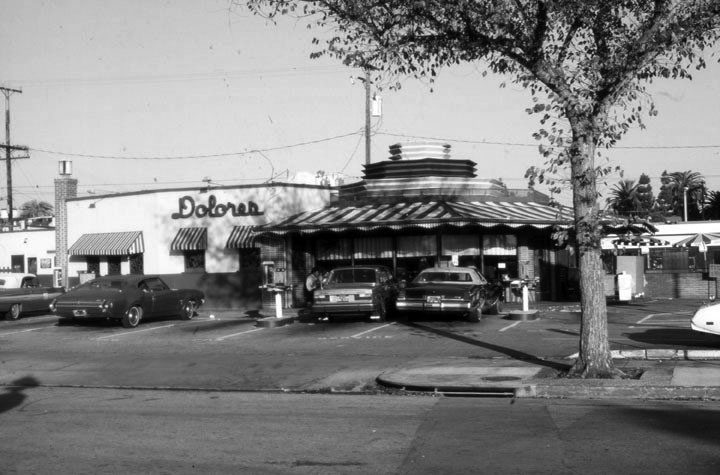 |
|
| (1978)* - Looking east across Le Doux Road towards Dolores Restaurant, a dining spot with car-hop service at 8531 Wilshire Boulevard. |
Historical Notes In 1981 Dolores Drive-in was forced to close down to make room for a high rise office building. The last of the remaining Dolores Restaurants was located at 11407 Santa Monica Blvd in West Los Angeles, which recently closed down. |
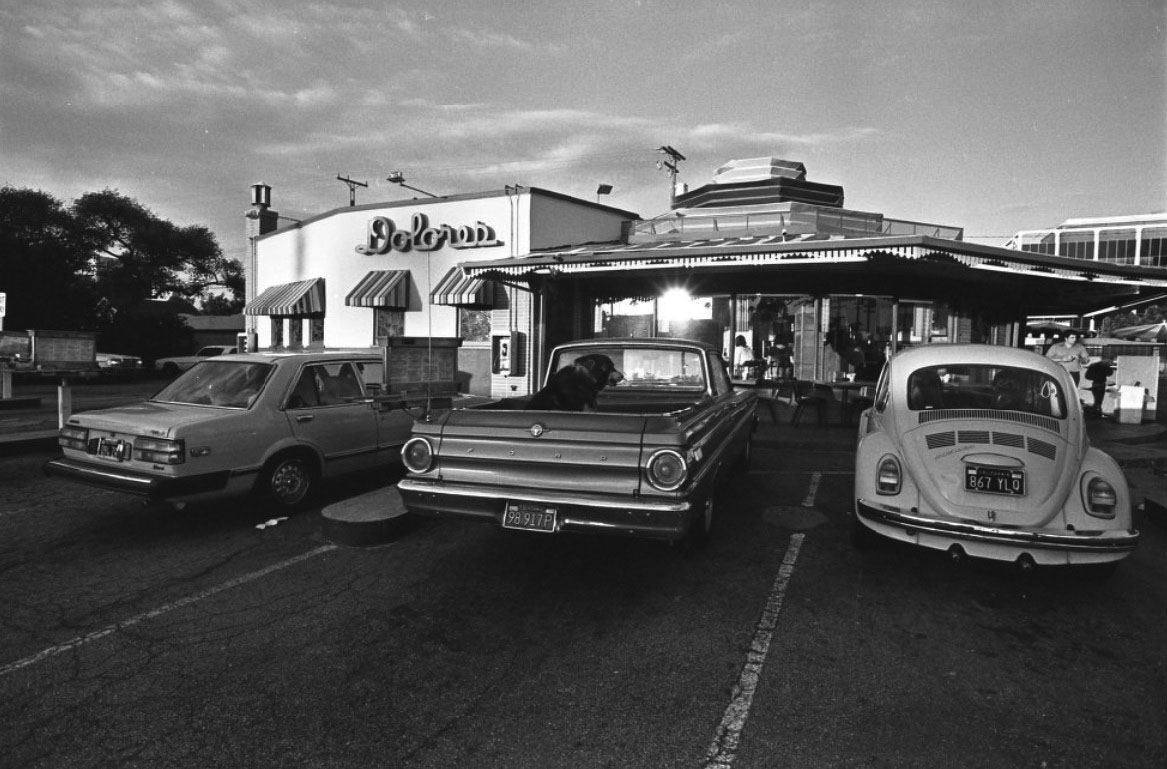 |
|
| (1980)+# - Dolores Drive-in on Wilshire Boulevard near La Cienega, Beverly Hills. LA Times Collection |
Historical Notes Built in 1946, Dolores would become the last restaurant of its kind to be seen in Beverly Hills thanks to a city ordinance prohibiting drive-ins. In 1981, KNBC TV interviewed loyal customers who flocked to Dolores's, the popular drive-in restaurant at Wilshire and La Cienega Blvd. for one last meal before it was torn down. Click HERE to see short video. Today, an office building stands where Dolores Drive-in once served hamburgers and fries. Click HERE for contemporary view. |
* * * * * |
P.K. Sandwiches (Leimart Park)
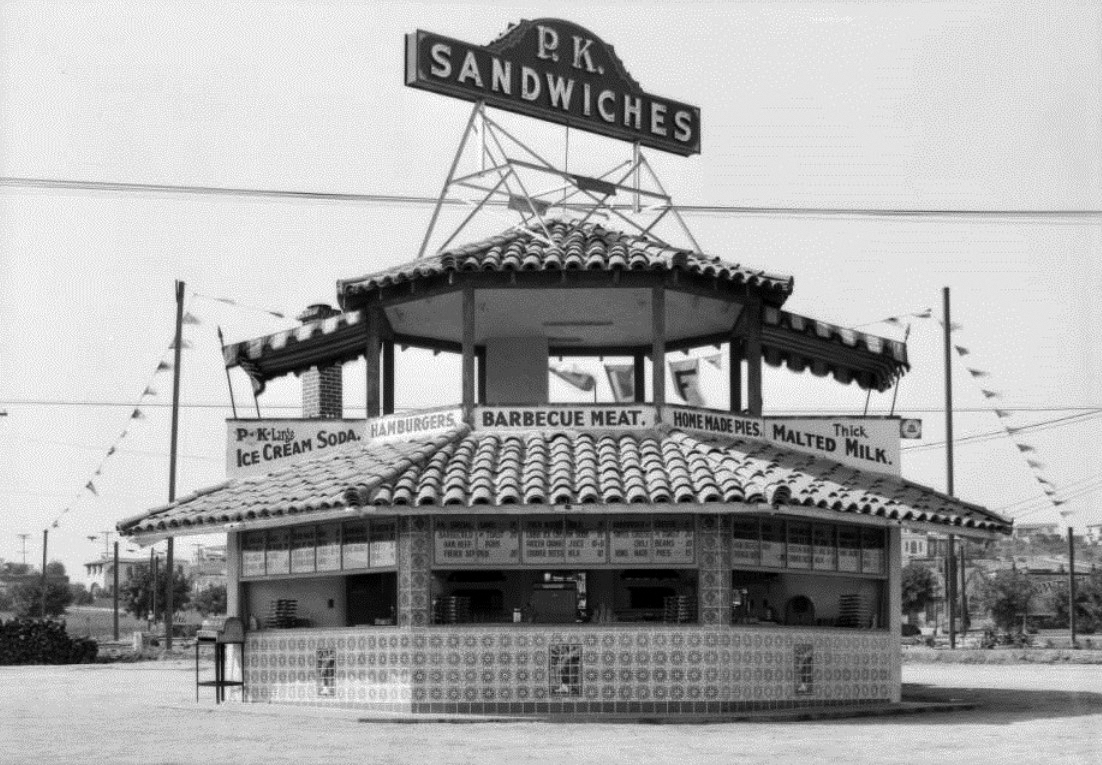 |
|
| (1930)^^ – View showing P.K. Sandwiches located at W. Vernon Ave & Crenshaw Blvd. (4406 Crenshaw Blvd), when a French dip sandwich cost 20¢. Trays are stacked up on the counter. There appears to also be an upstairs patio for eat-in service. |
* * * * * |
Patmar's Drive-in (El Segundo)
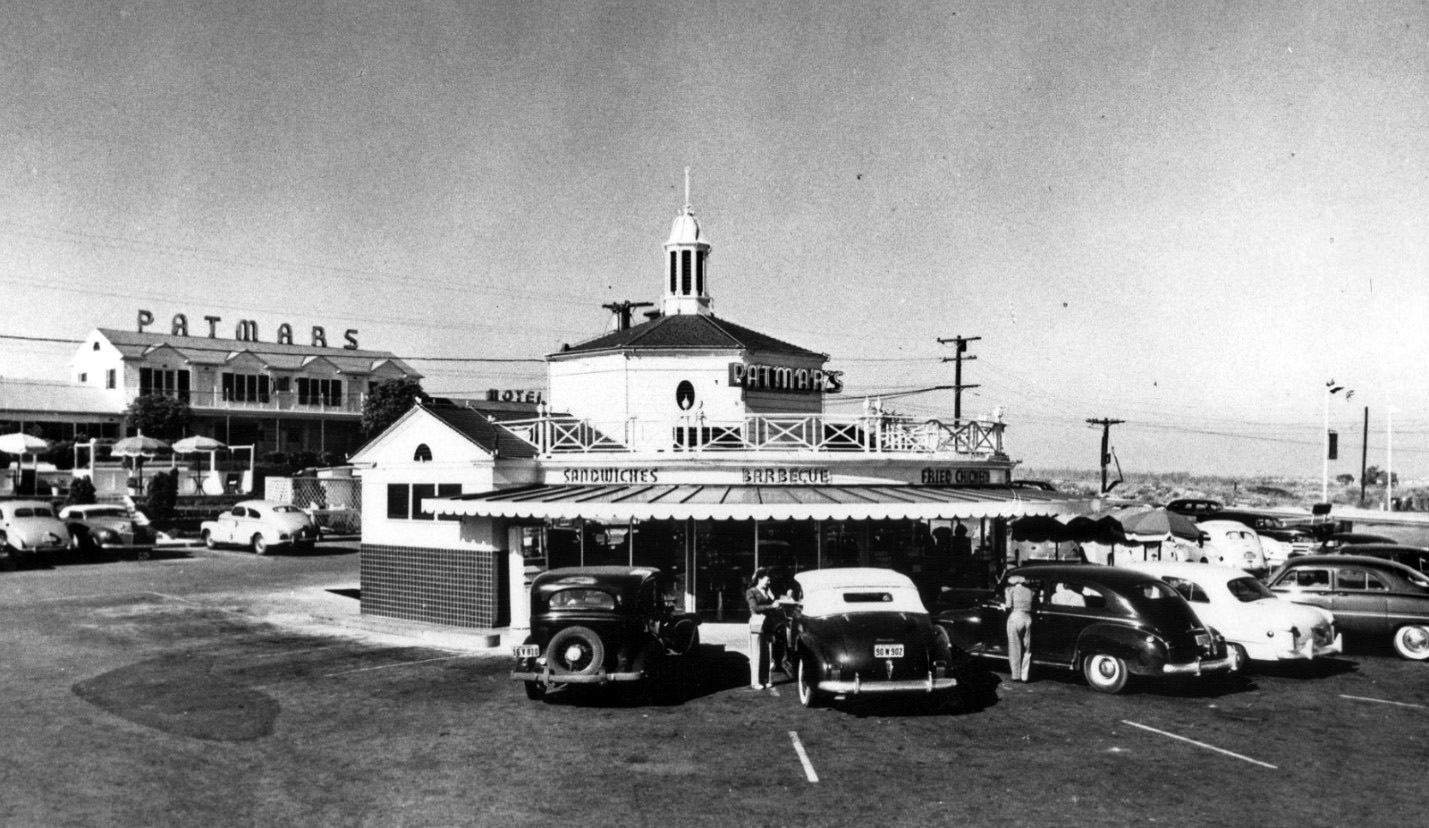 |
|
| (ca. 1950)^x^ – View showing Patmar’s Drive-in Restaurant with Patmars Motel seen in the background, located in El Segundo. Note that the design of the drive-in is almost identical to Dolores Drive-in (on the Sunset Strip). |
Historical Notes Architect Wayne McAllister designed the $35,000 split-level structure, which opened on May 8, 1941. Patmar’s proved popular throughout the 1950s as a gathering spot for teenagers. Jerry Walters of the El Segundo Historical Society described it as like “the ‘American Graffiti’ of El Segundo.” |
 |
|
| (1940s)^x^ – Postcard view showing the Patmar’s Drive-in Restaurant and Motel complex located at the corner of Imperial Highway and Sepulveda Boulevard in El Segundo. |
Historical Notes In 1939, Howard Patrick and Norman Marsh decided to go into business together and open a drive-in restaurant. They surveyed the area and settled on the southeast corner of Imperial Highway and Sepulveda Boulevard in El Segundo. Taking a syllable from each of their names, they called their new restaurant venture Patmar’s. Patmar’s held its grand opening on Memorial Day (then known as Decoration Day), May 29, 1939. The restaurant was an immediate success. In December 1940, Patrick and Marsh decided to build a state-of-the-art 14-unit motel on the hill directly behind the restaurant. In 1960, its owners closed the Patmar’s complex and sold the property. The drive-in restaurant building was relocated to the El Segundo Golf Course (now the Lakes at El Segundo). It was used as the golf pro shop, where it remained until its demolition in the late 1980s. Click HERE for contemporary view of the intersection of Imperial Highway and Sepulveda. |
Scrivner's Drive-in (Cahuenga and Sunset, NE Corner)
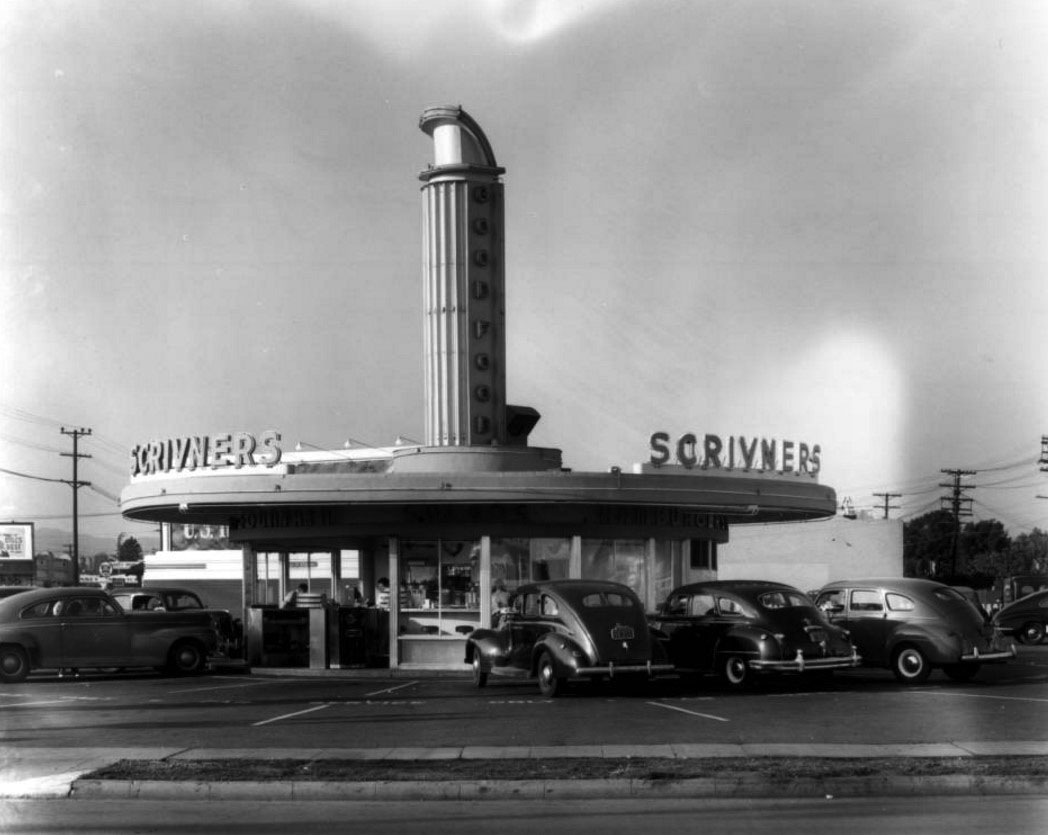 |
|
| (1940s)^^ – View looking at the northeast corner of Cahuenga and Sunset boulevards showing the circular Scrivner's Drive-in Restaurant with cars parked around it. |
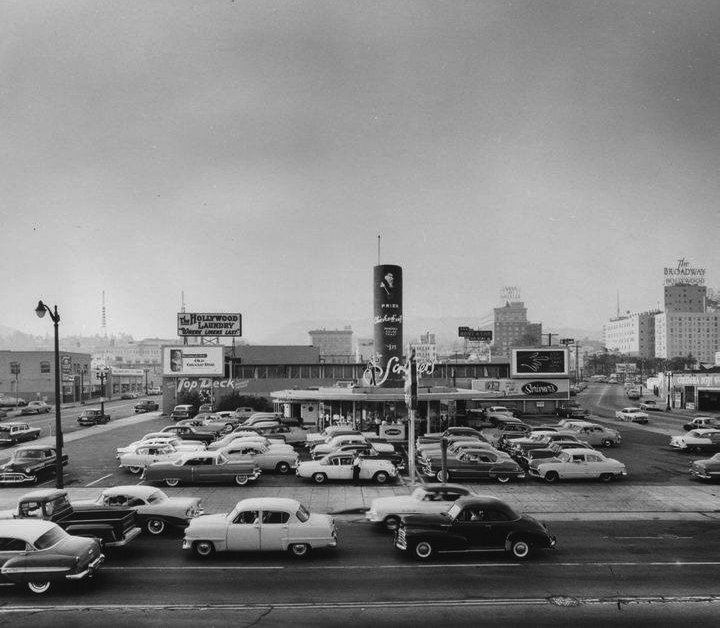 |
|
| (ca. 1956)##^* – View looking north across Sunset Boulevard showing Scrivner’s Drive-in, jammed-packed with cars. Cahuenga Boulevard is on the left and Ivar Avenue veers off on the right. The Broadway-Hollywood Building can be seen at upper-right. |
Historical Notes Art Laboe made a name for himself as a young disc jockey "by hauling his bulky radio equipment for live afternoon broadcasts" at this drive-in. He also did shows from another Scrivner's on Imperial Highway and Western. The old Scrivner's spot is now occupied by a Jack in the Box, but not for long: a hotel to replace it is in the works. Click HERE for contemporary view. #*#* |
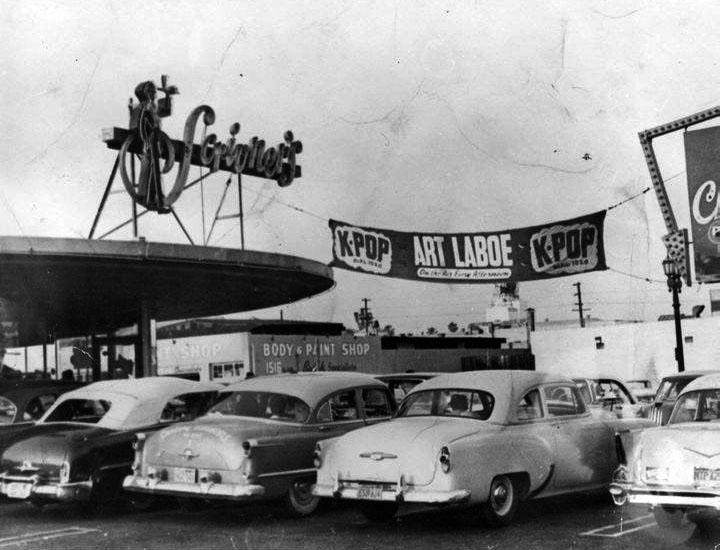 |
|
| 1950s)##^* – Scrivner’s Drive-in with large banner hanging over parking lot. Banner reads:: K-POP – ART LABOE |
Historical Notes Art Laboe’s most popular remote location, and one that he would occupy for eight years from 1951 to 1959, was in the parking lot of Scrivner’s Drive-In at the corner of Sunset and Cahuenga in Hollywood. |
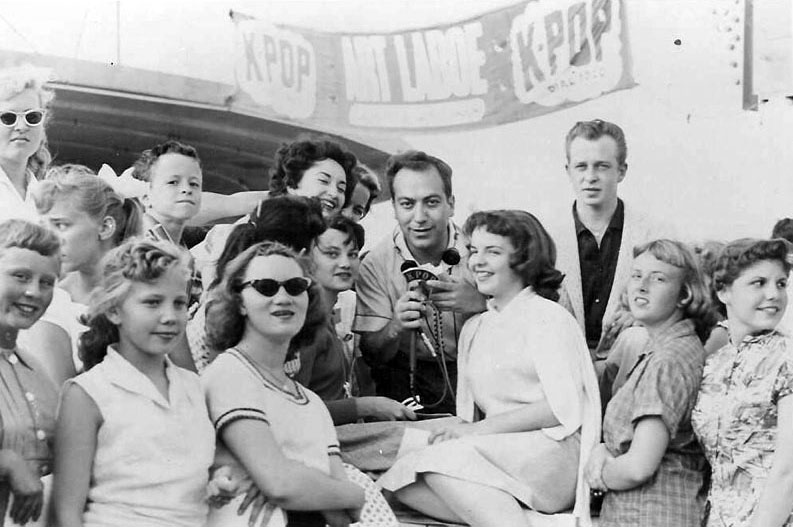 |
|
| (1950s)^^^ – View showing disc jockey Art Laboe (behind the mic) surrounded by teenage fans in the parking lot of Scrivner’s Drive-in at Sunset and Chauenga. |
Historical Notes The runaway popularity of the Scrivner’s broadcasts created traffic jams around the drive-in. |
Scrivner's Drive-in (Imperial Hwy and Western Ave)
 |
|
| (ca. 1952)#+ – Scrivner’s Drive-In, on the corner of Imperial Hwy and Western Ave. Back of Photo reads: "Scrivners, where I spent all my time from 1952 on." |
* * * * * |
Carl's at the Beach Drive-in
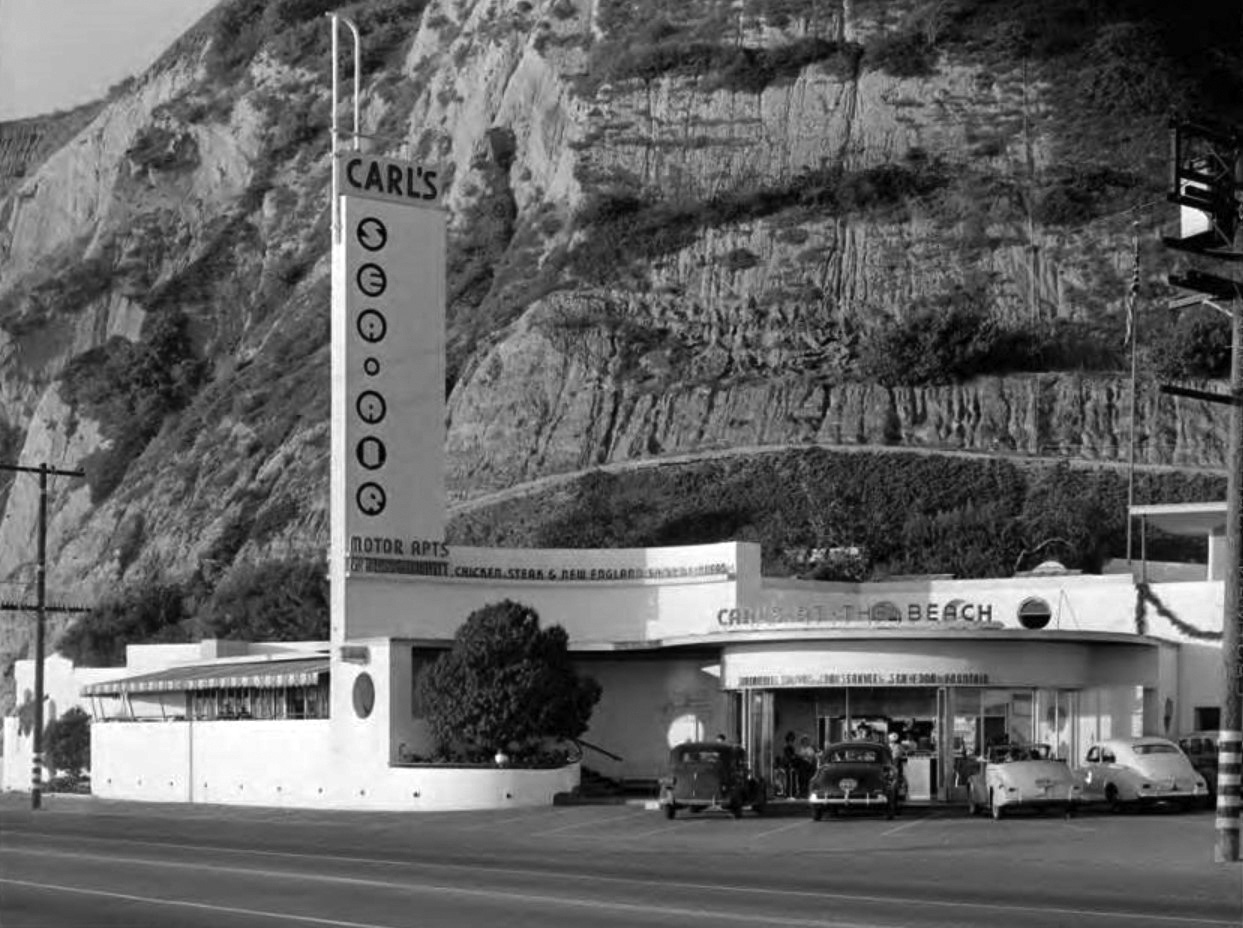 |
|
| (1940s)^^#* – View showing cars parked in front of Carl's Drive-in Restaurant located at the Sea Air Lodge complex (aka Carl's at the Beach) on the Pacific Coast Highway, Pacific Palisades. |
Historical Notes Designed in 1938 by two prominent Los Angeles architects, Burton Alexander Schutt and A. Quincy Jones, Carl’s Drive-in was part of a 12-room motel (Carl's at the Beach) that offered a full range of services--from restaurant to gas station to garage space--for Americans beginning their love affair with the car and the open road.^ It was located across the street from the landmark Pacific Palisades Lighthouse, Bathhouse, and Restaurant. |
* * * * * |
Herbert's Drive-in (Beverly and Fairfax, SE Corner)
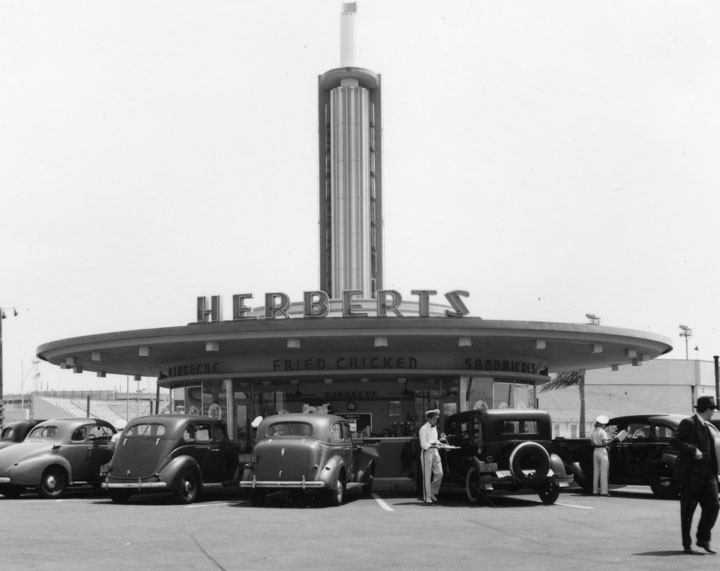 |
|
| (ca. 1940)* - The exterior of Herbert's Drive-In is built so that customers in cars can park all around it. Waiters/waitresses are seen serving food for people to eat in their cars. It was located at the southeast corner of Beverly Boulevard and Fairfax Avenue. Gilmore Stadium is in view behind the restaurant, on the left. |
Historical Notes L.A. restauranteur Sydney Hoedemaker opened Herbert's Drive-In in the early 1930s. It was designed by architect Wayne McAllister in circular Streamline Moderne style with a neon-ringed roofline and advertising pylon.* |
 |
|
| (ca. 1945)^ – View looking at the southeast corner of Fairfax and Beverly showing Herbert’s Drive-in restaurant. Three carhops are seen standing at center-left. Gilmore Stadium can be seen in the distance (on the right). |
Historical Notes Today, CBS Television City (built in 1952) stands at this site. Click HERE to see contemporary view. |
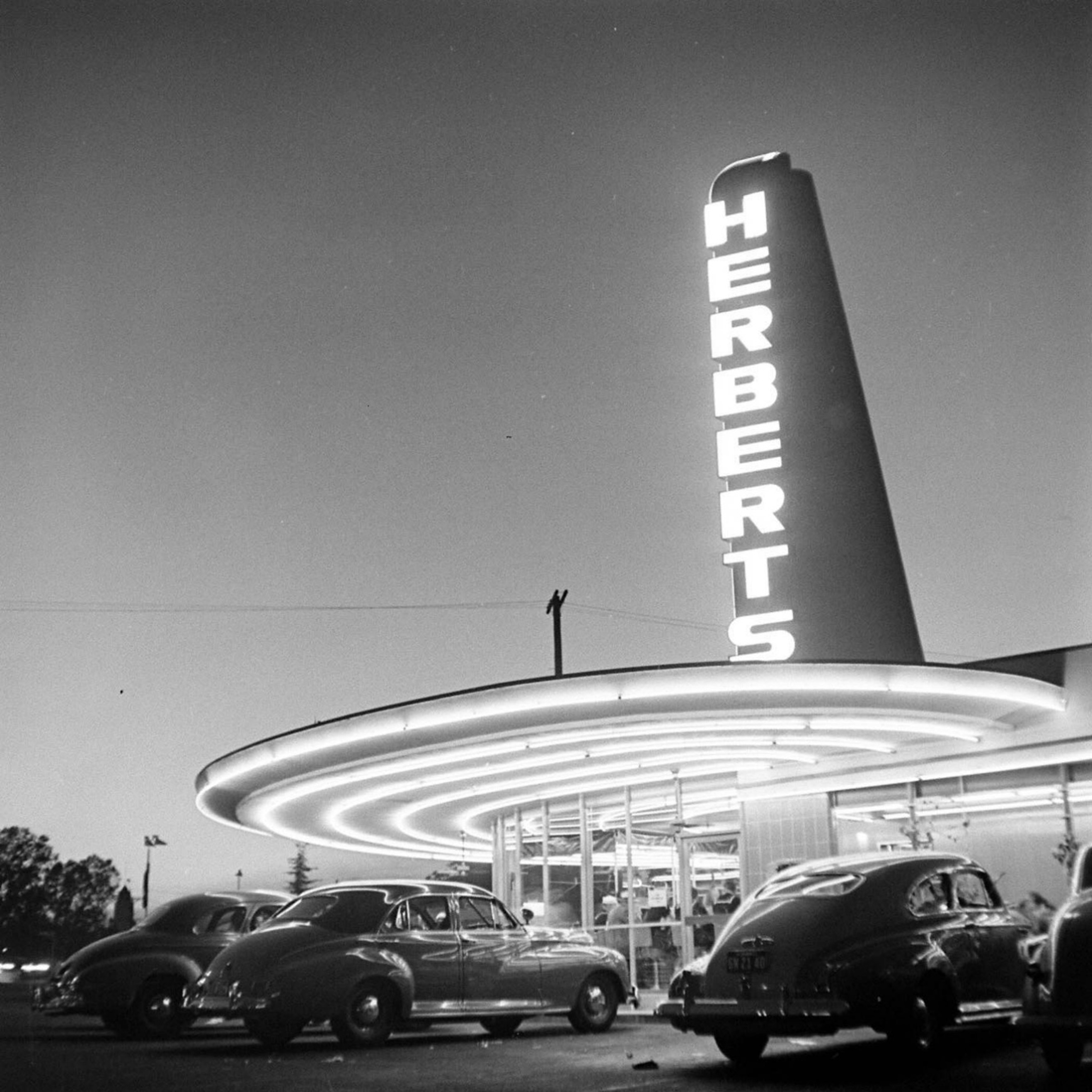 |
|
| (1945)* - Dusk view showing Herbert's Drive-in on the southeast corner of Beverly and Fairfax. Photo by Nina Leen for LIFE Magazine. |
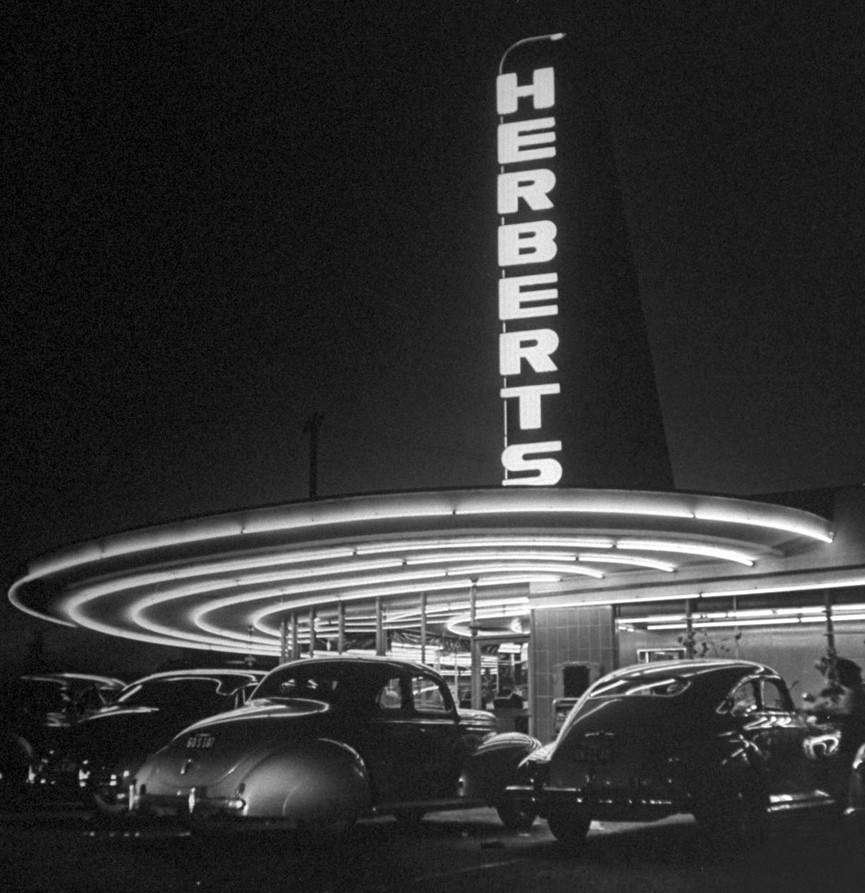 |
|
| (1945)^^ – Nighttime view of Herbert's Drive-in, located on the southeast corner of Beverly and Fairfax. Photo by Nina Leen for LIFE Magazine. |
Historical Notes Herbert’s was sold in 1950, and closed shortly thereafter, to make way for the construction of CBS Television City, which was completed in 1952. |
* * * * * |
Melody Lane Drive-in (Wilshire and Western, SW Corner)
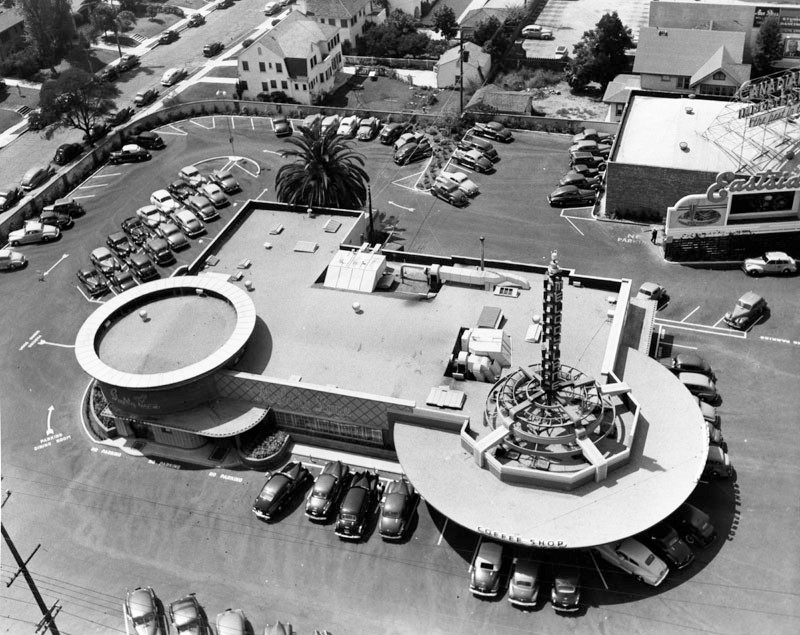 |
|
| (ca. 1940s)* - Aerial view showing Melody Lane Drive-in located on the southwest corner of Wilshire Boulevard and Western Avenue. Cars are parked around the circular coffee shop area, as well as in the large parking lot at bottom and at above left. The vertical Melody Lane sign is visible on top of building at right. |
Historical Notes Architect Wayne McAllister designed the Melody Lane, at Wilshire and Western, for restaurateur Sidney Hoedemaker for who he had designed several Herbert’s drive-ins. Besides car service and the familiar circular drive-in, Melody Lane included a dining room, coffee shop, and cocktail lounge in a complex that flowed off the drive-in. #^ |
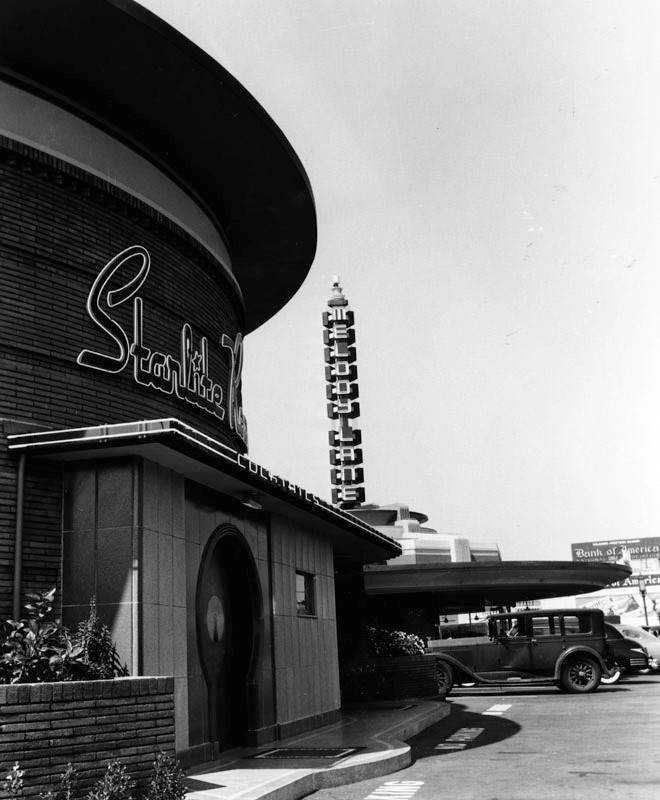 |
|
| (1940s)* – View showing the entrance to the Starlite Room cocktail lounge which is attached to the Melody Lane Drive-in seen in the background. Cars are parked under the McCallister-designed circular canopy with vertical Melody Lane sign extending up from its roof. |
Historical Notes The Starlite Room cocktail lounge revaled the the sophistication of McAllister’s dinner house designs, with a zodia-themed motif featuring clocked silk-rayon wall coverings and peach-colored mirrors. #^ |
* * * * * |
Robert's Bros. Drive-in (Wilshire and Vermont, SW conrer)
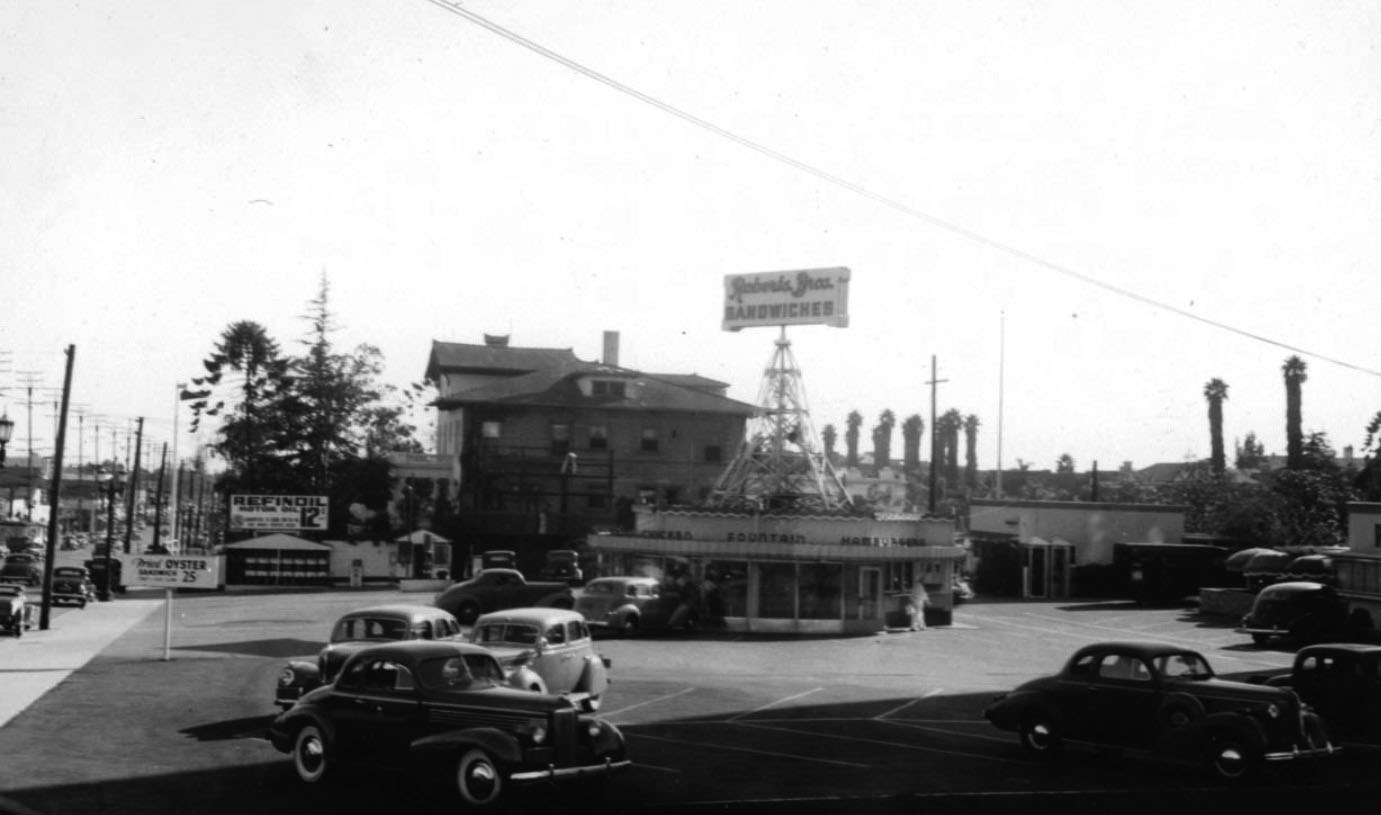 |
|
| (1939)^^ – View looking south showing the Roberts Bros. Sandwich Drive-in, located near the southwest corner of Wilshire and Vermont. Sign in front reads: Fried Oyster Sandwich 25¢. |
Roberts Drive-in (Burbank)
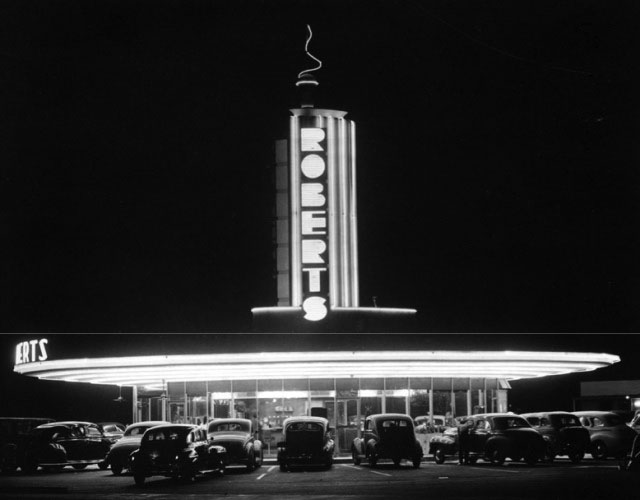 |
|
| (1940)^** – Atmospheric shot of the Roberts Drive-in diner in Burbank located on the corner of Olive Ave and Victory Blvd. |
Historical Notes Wayne McAllister was the architect of this circular, Streamline Moderne drive-in. It has a neon-trimmed roofline and advertising pylon and neon rings around the underside/overhang of the roof. A whimsical ball and neon detail are on top of the pylon. |
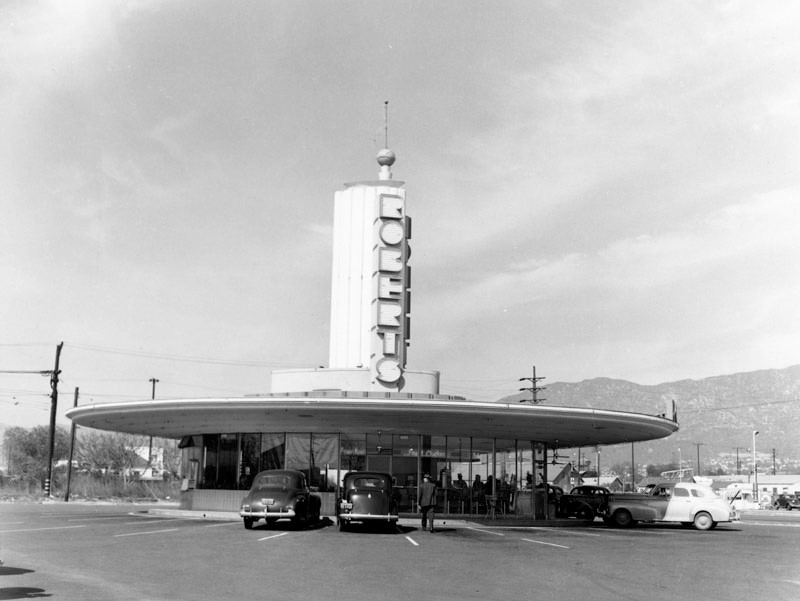 |
|
| (ca. 1948) * – View showing cars parked at Roberts Drive-in Restaurant at Olive Avenue and Victory Boulevard in Burbank |
Historical Notes Roberts Drive-in became Van De Kamps in 1968 and later Biff Naylor’s Gristmill in 1979. (Biff Naylor is the son of noted California restaurateur Tiny Naylor and purchased the Du-par’s chain in 2004.) ^** |
* * * * * |
Gwinn’s Coffee Shop and Drive-in
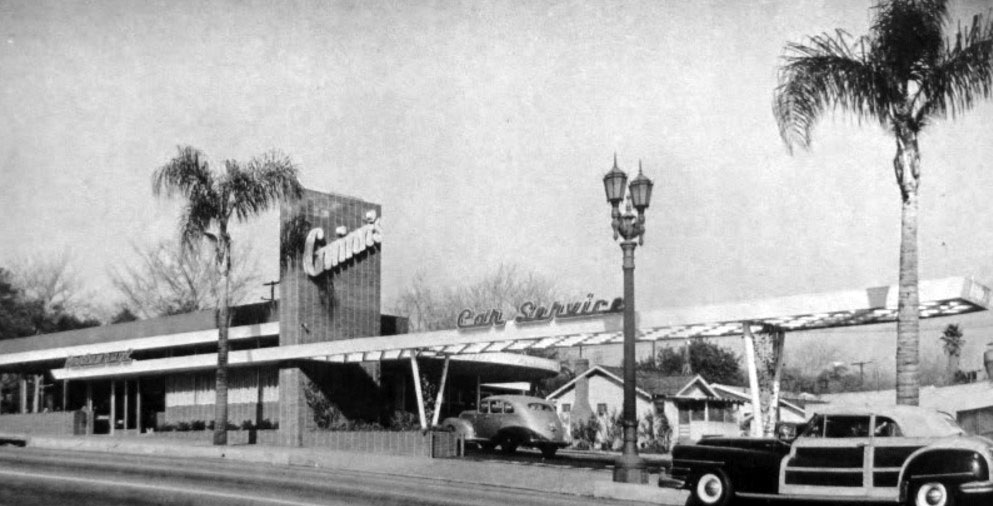 |
|
| (ca. 1947)^^* – View showing Gwinn’s Coffee Shop and Drive-in located at 2915 E. Colorado Boulevard, Pasadena. |
Historical Notes Gwinn’s Drive-in was designed by Harold J. Bissner and Harold B. Zook circa 1947. |
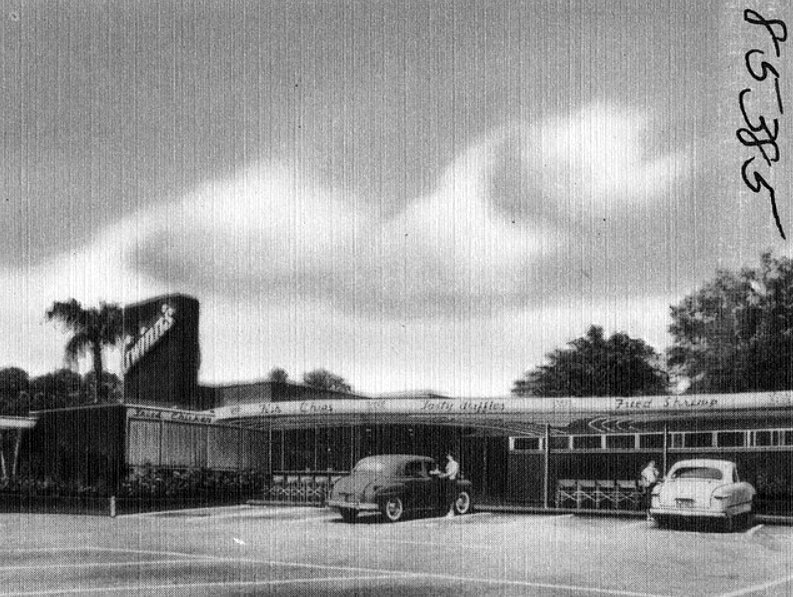 |
|
| (ca. 1947)^v^ – Postcard view showing two cars are being attended to at Gwinn’s Coffee Shop and Drive-in located in Pasadena. |
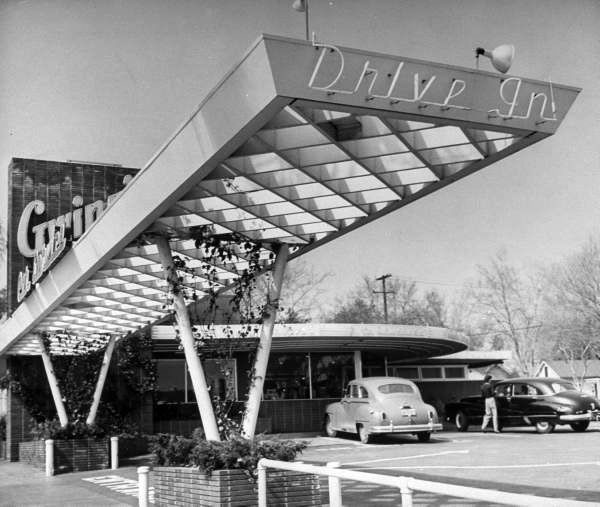 |
|
| (ca. 1947)**# – Gwinn’s Coffee Shop and Drive-in, 2915 E. Colorado Blvd. (U. S. 66) Pasadena. |
Historical Notes Gwinn's Drive-in was demolished around 1992. |
* * * * * |
Tam O' Shanter (Los Feliz and Boyce, SE Corner)
.jpg) |
|
| (1930)##^* – View looking toward the southeast corner of Los Feliz Boulevard and Boyce Avenue showing the Tam O’ Shanter, advertising Malted Milk for 15 cents. Full car service can be seen at center-left, next to the umbrella. Although it is not Art Deco, the Tam O' Shanter is historically significant since it is considered to be one of the first drive-in restaurants in LA. |
Historical Notes June 26th, 1922, Lawrence L. Frank and Water Van de Kamp opened the Tam O’Shanter Restaurant in Atwater Village with the distinctive Storybook-style architecture of Hollywood set designer Harry Oliver. The Tam O’ Shanter soon became one of the nation’s first drive-ins with special wooden trays that enabled guests to dine in their cars. They called it 'Car Service de luxe'. |
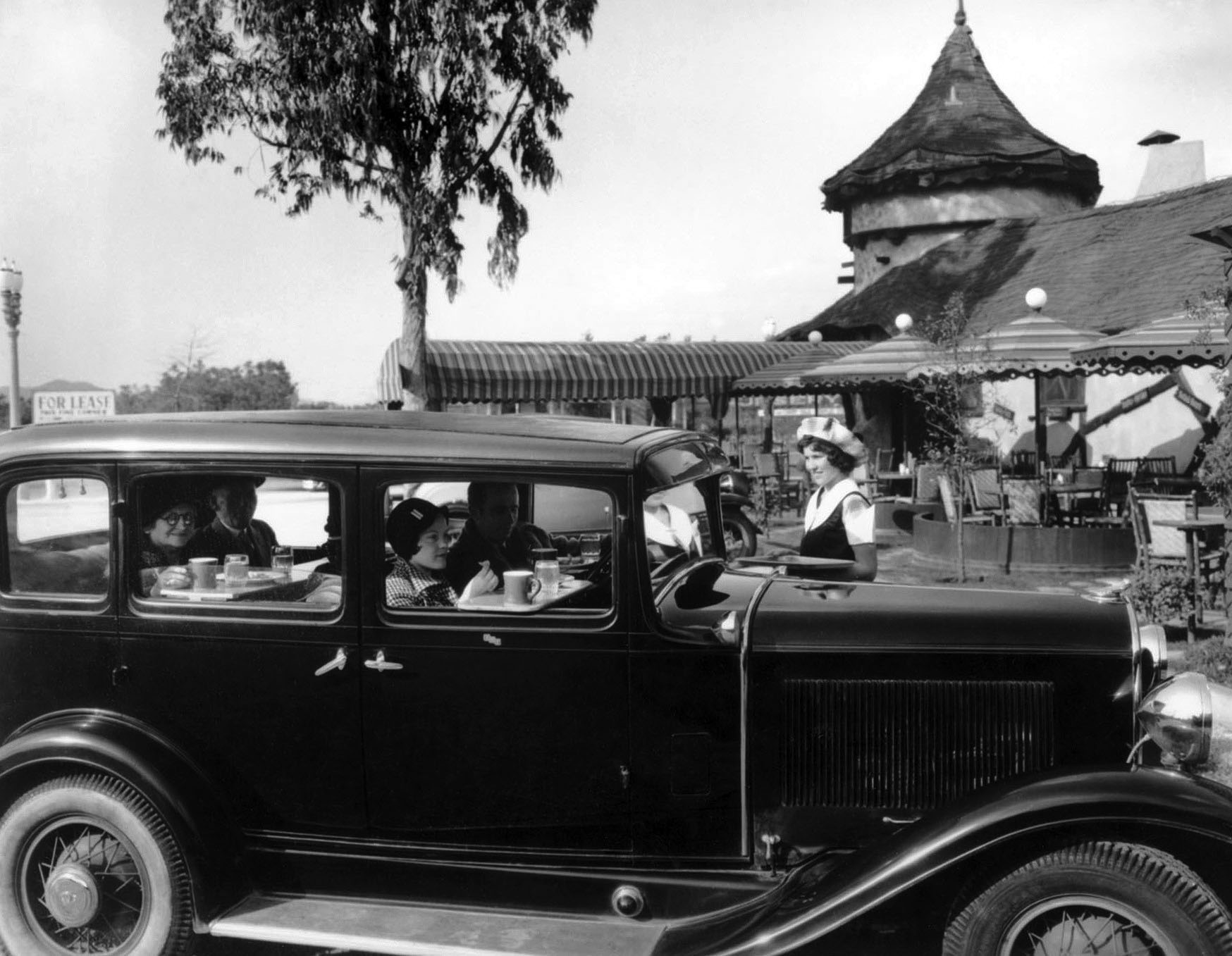 |
|
| (1930s)*## – View showing four people enjoying a tray-served meal inside their car at Tam O’ Shanter. |
Historical Notes From a 1933 advertisement of the newly remodelled Tam o’ Shanter and its drive-in service: “We are happy to welcome you to our remodeled Tam o’ Shanter Inn. Important among the changes made, is the re-establishment of Car Service de luxe – a feature which we originated eight years ago. Ingenious tables installed in your car, enable you to sit and eat in the comfort and privace of your own automobile…” Click HERE to see more Early Views of the Tam O' Shanter. |
* * * * * |
Mother Goose Pantry
.jpg) |
|
| (1927)* - Mother Goose Pantry, located on the north side of Colorado Blvd. between Berkeley and Greenwood Aves. View is to the west, providing both indoor and drive-up service. |
Historical Notes This structure graced Colorado Blvd from ca. 1927 to at least the mid-1940s. |
 |
|
| (1920s)^^ - View showing Mother Goose Pantry, located at 1951 East Colorado Boulevard. This was a 'shoe-in' for best design in the 1920s. |
Historical Notes The restaurant served hearty meals from the whimsical shoe that attracted patrons driving along Route 66 from the east coast to Los Angeles. In addition to tray service while sitting in their car, diners could also be seated on the ground floor and in a dining room upstairs. |
* * * * * |
Pig Stand Drive-in (Sunset and Vine, SE Corner)
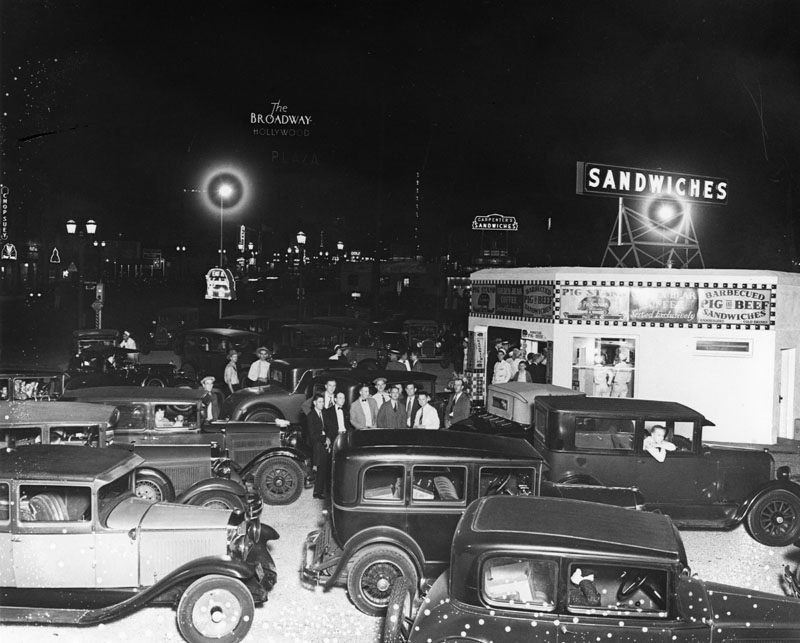 |
|
| (ca. 1931)* - Night view of Pig Stand Drive-in restaurant on the SE corner of Sunset and Vine. Across the street (NE corner of Sunset and Vine) can be seen the neon sign for Carpenter's Drive-in. Also seen in the distance is the Broadway-Hollywood sign (located on the SW corner of Hollywood and Vine). |
Historical Notes We didn't quite invent the drive-in restaurant in Los Angeles -- the Pig Stand in Dallas beat us by a year -- but we did do more than anyone to perfect the concept and ensure its spread. After all, we were living in the most car-oriented part of the country, and we did set the standard for what was cool.^^# A Dallas entrepreneur named Jessie G. Kirby built the first Pig Stand along a Dallas-Fort Worth Highway in October 1921. It was a hit with hungry drivers, and soon it became a chain. (The slogan: "America's Motor Lunch.") Kirby and his partners made one of the first franchising arrangements in restaurant history, and Pig Stands began cropping up everywhere. By 1934, there were more than 130 Pig Stands in nine states. (Most were in California and Florida.) Meanwhile, the chain kept innovating. Many people say that California's Pig Stand No. 21 became the first drive through restaurant in the world in 1931, and food historians believe that Pig Stand cooks invented deep-fried onion rings and chicken-fried steak sandwiches. Wartime gasoline and food rationing hit the Pig Stands hard, and after the war they struggled to compete with newer, flashier drive-ins. By the end of the 1950s, all of the franchises outside of Texas had closed. By 2005, even the Texas Pig Stands were struggling to survive—only six remained in the whole state—and by the next year they had all disappeared.*## |
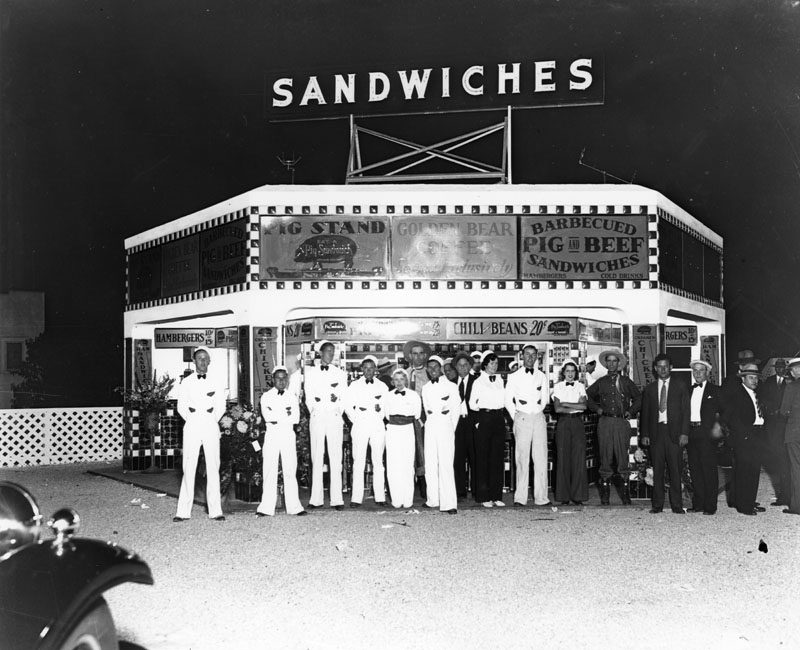 |
|
| (ca. 1931)* - View showing carhops and customers posing for the camera front of Pig Stand drive-in restaurant. The drive-in was located on the southeast corner of Sunset and Vine. By 1938, this site would become home to Harry Carpenter's Drive-in. |
Historical Notes Between 1931 and 1961, three different drive-in restaurants occupied the southeast corner of Sunset and Vine: |
* * * * * |
Brown Derby Restaurant and Car Cafe
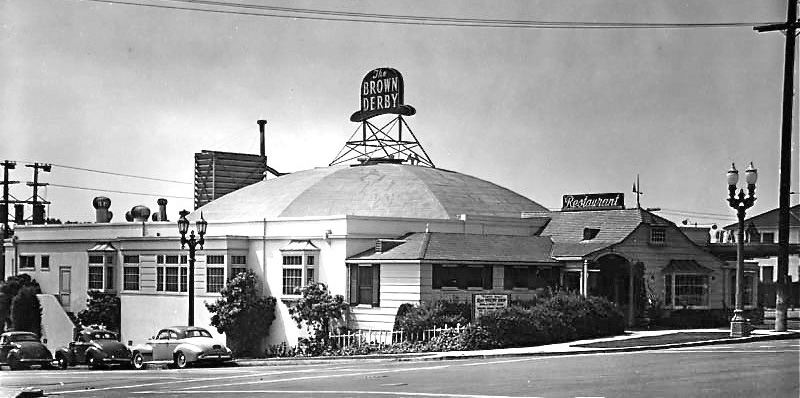 |
|
| (ca. 1940)* - View looking toward the southwest corner of Los Feliz and Hillhurst showing the The Brown Derby (previously Willard's Restaurant). |
Historical Notes In 1940, Willard's Chicken Inn Restaurant was purchased by legendary director Cecil B. DeMille who brought in the Brown Derby fine dining and 24-hour car service in keeping with the drive-in restaurant fad of the era. At the time, DeMille was also part owner of the Wilshire Brown Derby. |
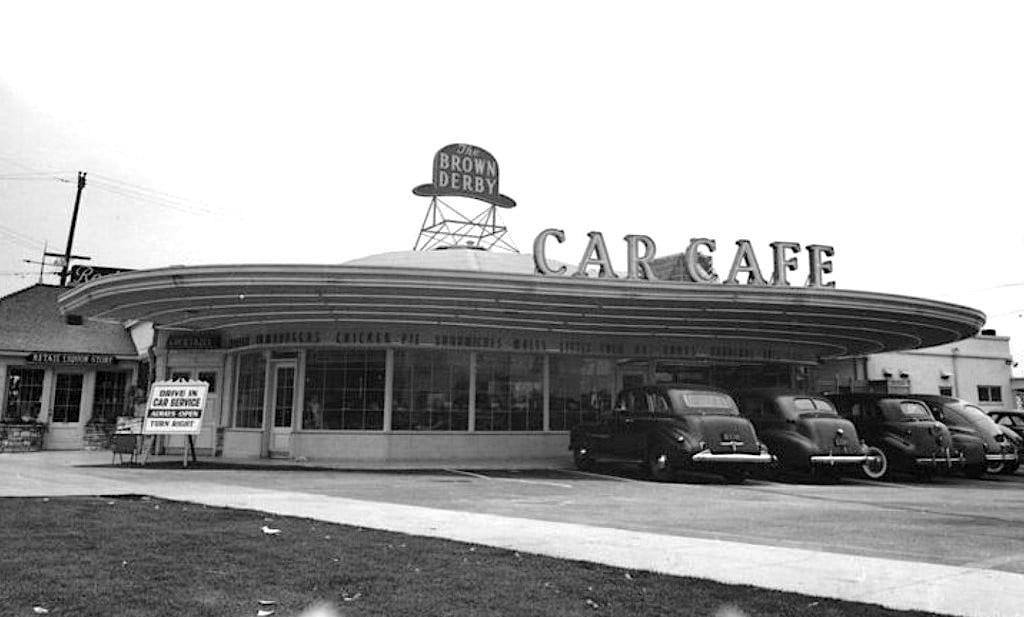 |
|
| (ca. 1941)^.^ - View showing the Car Cafe at the Brown Derby Restaurant located at 450 Los Feliz Blvd (not far from the famous Greek Theatre). Sign reads: Drive-in Car Service – Always Open |
Historical Notes This was the only Brown Derby with a "Car Cafe". |
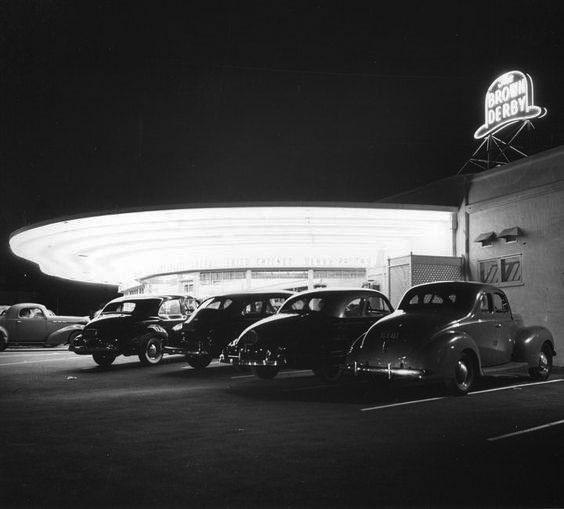 |
|
| (ca. 1947)+^^ – View looking northeast from the parking lot of the Los Feliz Brown Derby showing the circular drive-in component of the restaurant with its neon lights. This was the only drive-in of the four Brown Derby’s restaurants. The building is still there, and still a restaurant, which is more than can be said for the other Brown Derby locations. |
Historical Notes This was the last of the four Brown Derby Restaurants to open around Los Angeles; the first was located on Wilshire across from the Ambassador Hotel; the second opened in 1929 in Hollywood , the third in Beverly Hills on Wilshire Boulevard in 1931. It was the only one of the the four with a "Car Cafe". Click HERE to see more Early Views of LA Drive-in Restaurants. |
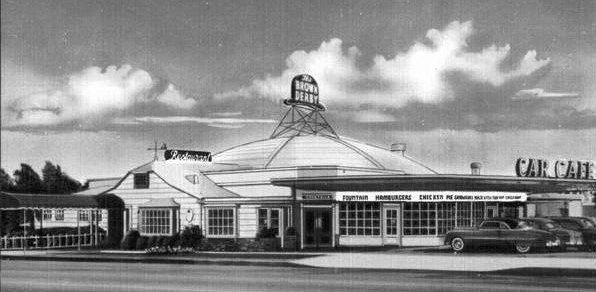 |
|
| (ca. 1950)*^ - Postcard view showing the Brown Derby Restaurant and Car Cafe located at 4500 Los Feliz Boulevard. |
Historical Notes In 1960, the Brown Derby was purchased by actor Michael St. Angel (aka Steve Flagg) and became Michaels of Los Feliz, and in 1992, it was transformed into a nightclub known as The Derby. In the late 1990s, it became one of the centers of the resurgence of swing dancing, which launched the careers of modern swing bands such as Big Bad Voodoo Daddy and Johnny Crawford. Oregon rock/swing/ska band the Cherry Poppin' Daddies recorded a song that cites the venue, titled "Brown Derby Jump", on their album Zoot Suit Riot. In June 2004, when Hillhurst/Los Feliz LLC purchased The Derby and adjacent lots with a view to demolition and replacement by a condominium complex, the planned redevelopment became a cause celebre for historic preservation activists. An independent coalition called "Save The Derby" fought to prevent the demolition, and, on May 19, 2006, the Los Angeles City Council voted unanimously to designate the entire structure an official Historic Cultural Monument of the City of Los Angeles. In January 2009, the nightclub closed its doors. The current landlord chose not to renew the lease, not long after a shooting inside the club. The Los Feliz Brown Derby space is partially occupied by the gastropub Mess Hall Kitchen and a Chase bank, dividing the dome in half between the businesses.*^ Click HERE for contemporary view. |
* * * * * |
Van de Kamp's Drive-in (Fletcher Dr. and San Fernando Rd.)
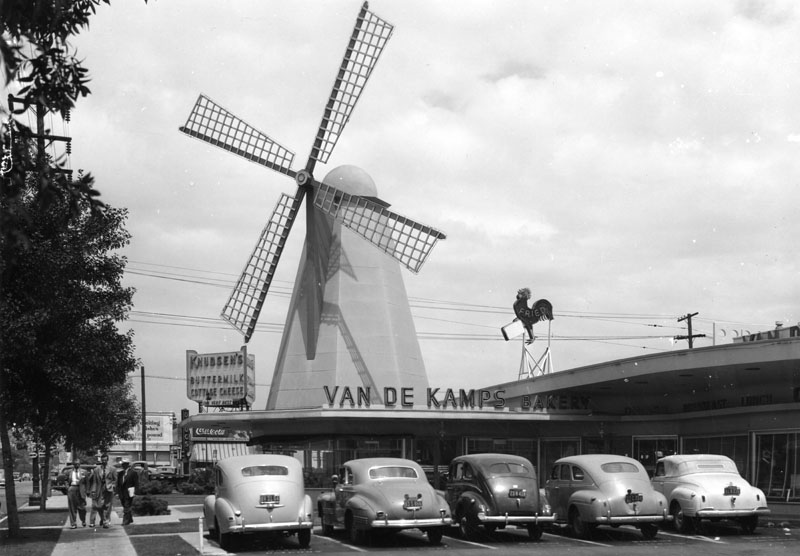 |
|
| (ca. 1945)* - Daytime view showing Van de Kamp's Bakery and Coffee Shop with Drive-in service, located on the corner of Fletcher Drive and San Fernando Road in Atwater. Numerous cars are parked at the drive-in and other business and product signs are visible in the background: Knudsen's, Coca Cola and Carnation ice cream. |
Historical Notes Van de Kamp's Holland Dutch Bakeries was a bakery founded in 1915 and headquartered in the Van de Kamp Bakery Building in Los Angeles. The company's trademark blue windmills featured on their grocery store signs and atop their chain of famous restaurants that were known throughout the region.*^ The above Van de Kamp's Drive-in stood adjacent to the Van de Kamp's Bakery Headquarters on Fletcher Drive. |
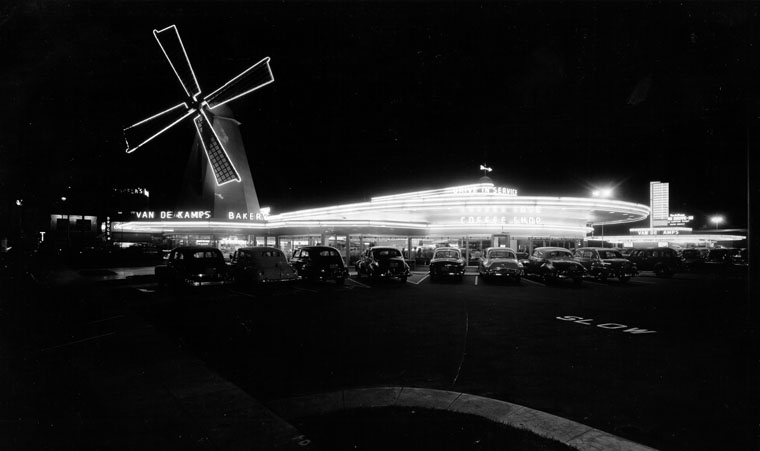 |
|
| (ca. 1954)* - Van de Kamp's Bakery and Coffee Shop with Drive-In service, seen here at night with a row of cars parked around the lighted building, located on the corner of Fletcher Drive and San Fernando Road in Atwater. Its architect was Wayne McAllister, using Streamline Moderne style with neon trimmed rooflines and pylon. Today, an El Pollo Loco is located where Van de Kamp's Drive-in once stood. Click HERE for contemporary view. |
Historical Notes Van de Kamp's Holland Dutch Bakeries was sold by the Van de Kamp family and acquired by General Baking Co. in 1956. The company was sold to private investors in 1979, and closed in bankruptcy in 1990. The Van de Kamp's brand is now owned by Ralphs supermarket chain and used for their line of private-label baked goods. |
* * * * * |
“The Track” Drive-In (8123 Beverly Blvd, Northeast Corner of Beverly & Kilkea Drive)
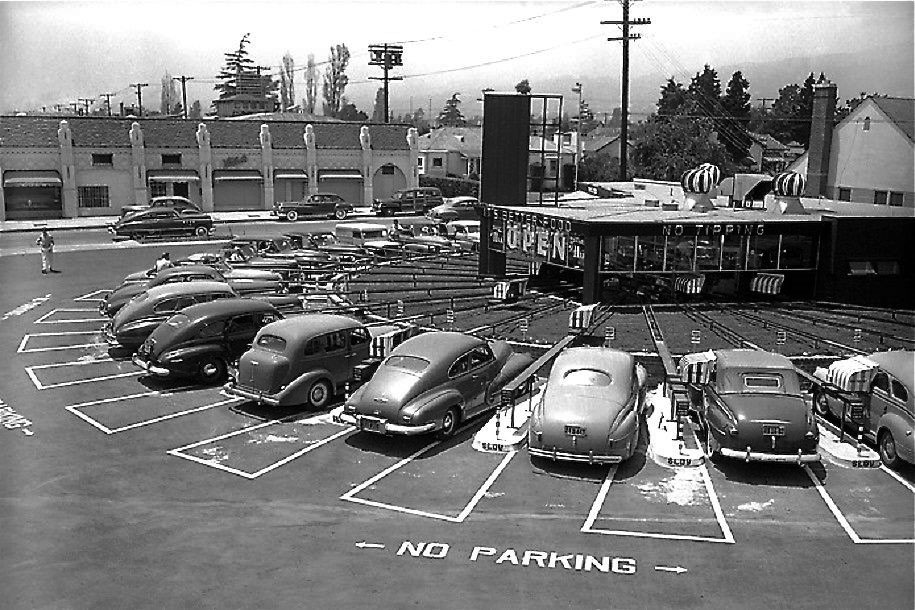 |
|
| (1949)* – View showing The Track Drive-In, which featured a futuristic “Motormat” conveyor system instead of carhops. The restaurant was located at 8123 Beverly Boulevard, on the northeast corner of Beverly and Kilkea Drive. |
Historical Notes Patented by Kenneth C. Purdy in 1948, the Motormat eliminated the need for carhops by using motorized bins on rails to take orders, deliver food, and return with payment. The Track opened in 1949 with 20 semicircular parking stalls circling a central kitchen like spokes on a wheel. Each stainless-steel bin, powered by a ½-horsepower motor, acted as waiter, busboy, and cashier all in one. |
 |
|
| (1949)* - View showing The Track with its metal rails on which carrying bins traveled directly to customers’ cars. |
Historical Notes Customers found menus, pencils, water, and an order pad inside each bin. After writing down their choices and pressing a button, the bin glided back to the kitchen where attendants prepared the order. Payment was handled the same way—no servers ever approached the car. The system cut service time by 20–25% and drew curious diners from across Los Angeles, even as far as Santa Monica, eager to try the novel “drive-in of the future.” |
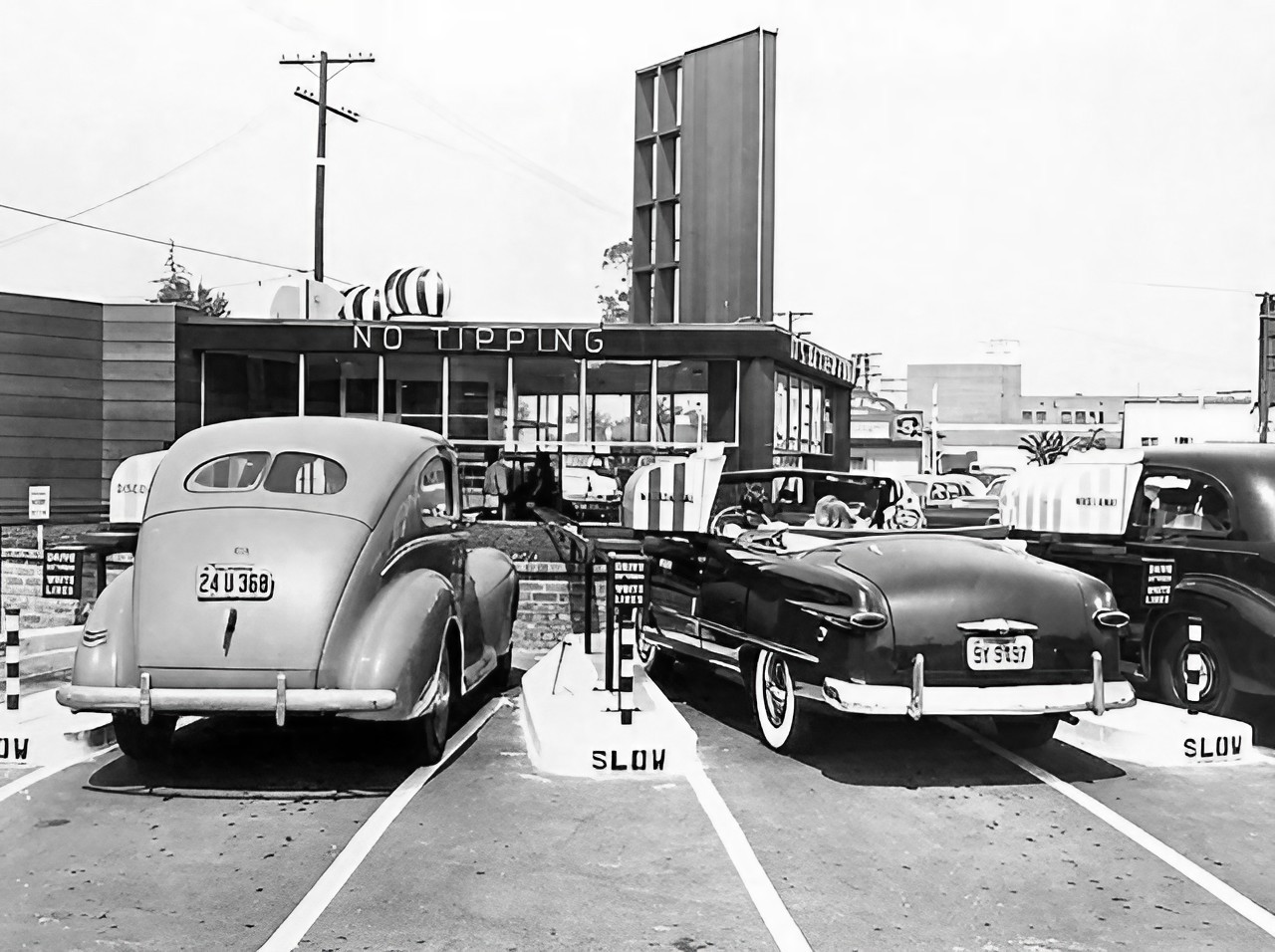 |
|
| (ca. 1949)* - Closer view of The Track Drive-In with its bold “NO TIPPING” sign above the serving window. |
Historical Notes Because there were no waitresses or carhops, tipping was unnecessary—a point proudly advertised. According to Purdy, the spoke-and-wheel layout and automated bins sped up service and reduced labor costs, though the setup was often compared to a Rube Goldberg-style invention for its complexity. Despite its quirks, it briefly captured the spirit of postwar optimism and fascination with automation. |
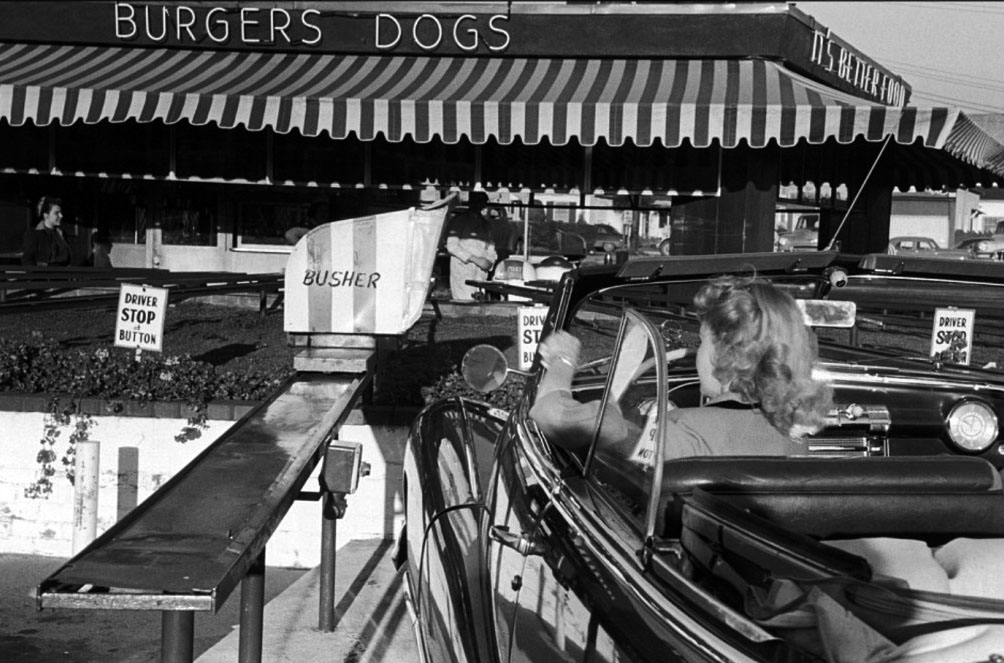 |
|
| (1951)* – A woman waits in her convertible at The Track as a bin labeled “BUSHER” approaches with her order. |
Historical Notes Each stall was positioned at window height to align with the incoming bin. The process was fully mechanical: order written on a pad, bin sent to the kitchen, bill returned, payment collected, and finally the meal delivered back—without ever leaving the car. While ingenious, the system proved costly to maintain, and by 1952 The Track had closed, its equipment sold at auction. |
* * * * * |
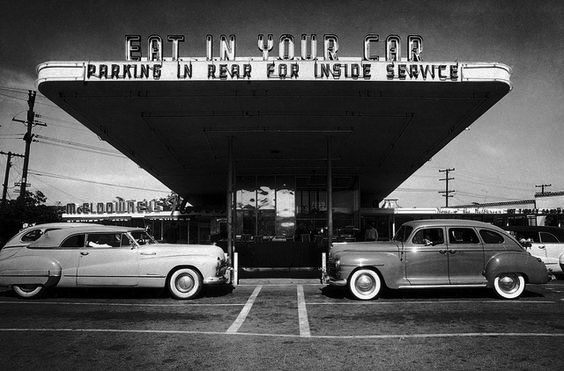 |
|
| (1949)**^ – View showing an early Los Angeles drive-in restaurant located on the 9400 block of Pico Blvd (see note below). |
Historical Notes In the back, there is a McEldowney's drive-in florist. There were two known locations of the florist at 9449 W. Pico (ne corner at Beverly Drive), and 7013 Hollywood Blvd. I’m guessing this is the Pico location mainly because of the overhead power lines, not generally found on Hollywood Blvd. |
* * * * * |
Stan's Drive-in (Beverly and La Brea, NW Corner)
 |
|
| (ca. 1952)##^* – View showing Stan’s Drive-in Restaurant located on the NW corner of Beverly Blvd. and La Brea Ave. |
Historical Notes Stan's was a chain of drive-in's with at least a dozen LA locations built in the late 1950's and 60's. |
* * * * * |
Stan's Drive-in (Sunset and Highland, SE Corner)
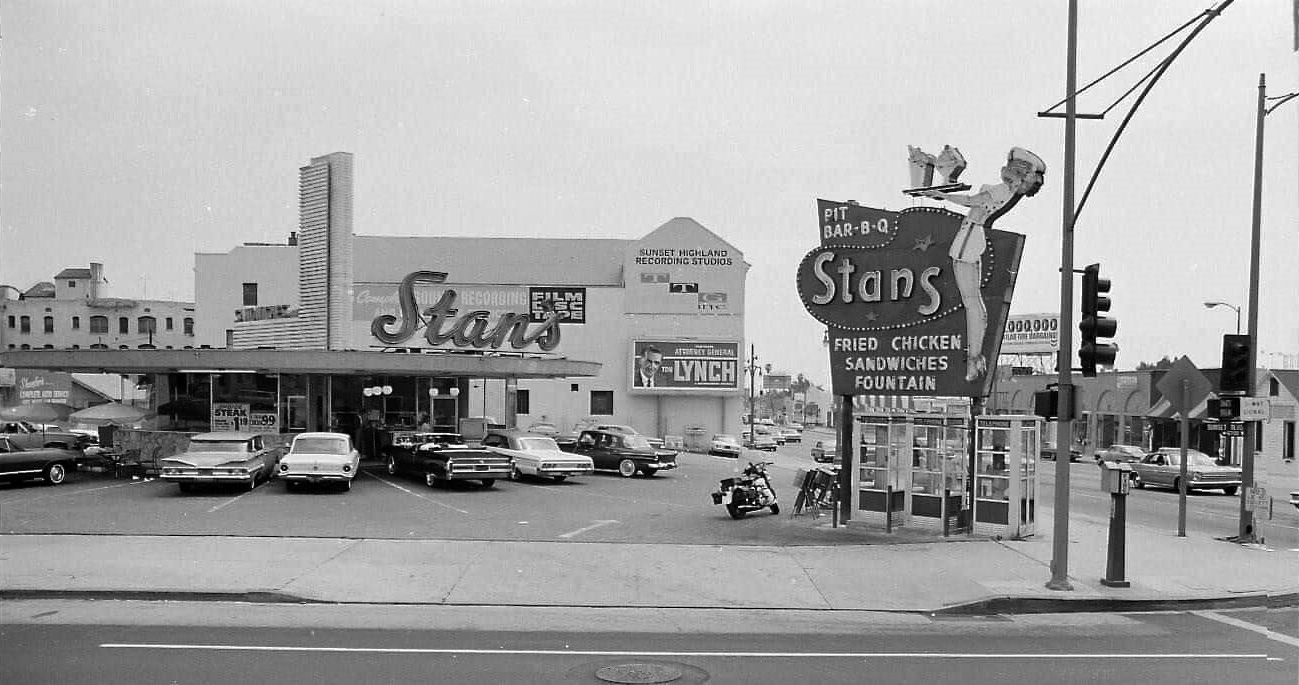 |
|
| (ca. 1966)^.^ - Stan’s Drive-in on the SE corner of Sunset & Highland, kitty-corner to Hollywood High School. Sunset-Highland Recording Studios is seen in the background. |
Historical Notes Previously, the southeast corner of Sunset and Highland was the site of Simon’s Drive-in…one of two Simon’s on Sunset for a few years (since 1938). As of December 1951, Simon’s became a Stan’s drive-in. Since Stan’s took over the Carpenter’s at Vine that same year, there were now 2 Stan’s on Sunset. Stan’s stood on the SE corner as seen above until 1971 when it was demolished. Today, a Chick-fil-A is at the corner. Click HERE to see contemporary view. |
* * * * * |
Stan's Drive-in (East Hollywood)
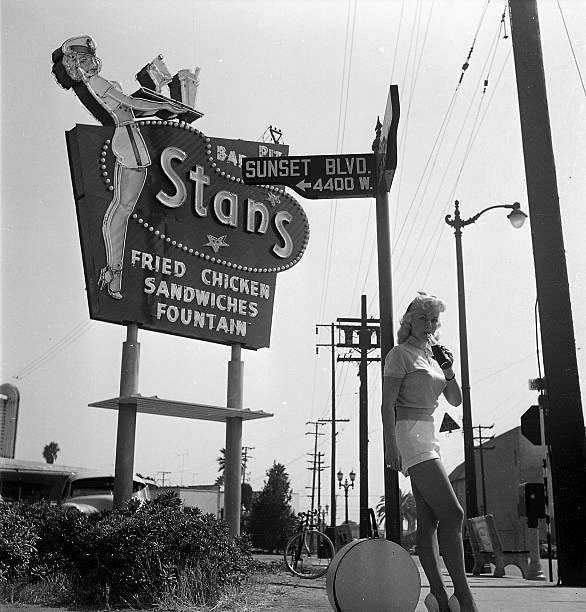 |
|
| (1950s)##^* – View showing a woman drinking a soda while leaning on a street sign post with a Stan’s Drive-in seen in the background on the 4400 block of Sunset Blvd (SE corner of Sunset and Virgil Ave, across the street from the Vista Theatre). Click HERE for contemporary view. |
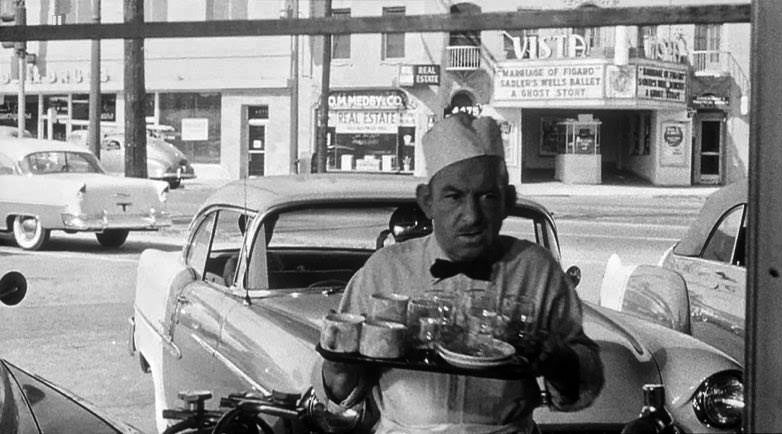 |
|
| (1955)^v^ - A shot of the Vista Theatre from inside Stan's Drive-in seen in "The Crooked Web" (Columbia, 1955). Thanks to Jonathan Raines for the screenshot. Click HERE for contemporary view. |
* * * * * |
Tiny Naylor's Restaurant and Drive-in (Sunset and La Brea, NW Corner)
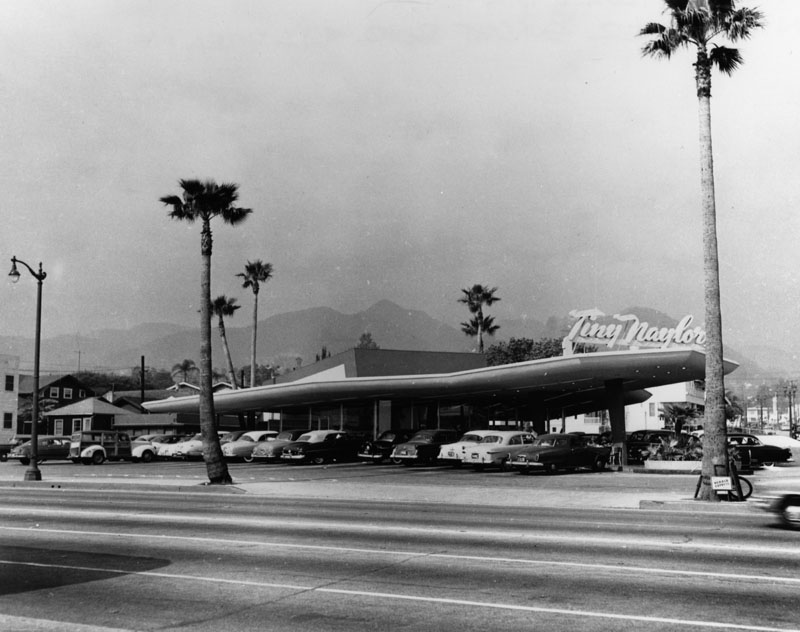 |
|
| (1949)* - View showing a full parking lot at Tiny Naylor's Restaurant and Drive-in, located on the northwest corner of Sunset and La Brea in Hollywood. |
Historical Notes This is the original location of "Tiny Naylor's" (1949-1980), one of the most popular drive in restaurants during the Golden Age of Hollywood. Many movie stars would go to this "space age" styled building to eat, because they could be served their meal in their cars and remain unnoticed. The restaurant was open 24 hours a day and was a great example of "Googie" Architecture. This is the same corner where McDonnell's Drive-in (not to be confused with McDonalds) once stood in the 1930s and early 1940s. |
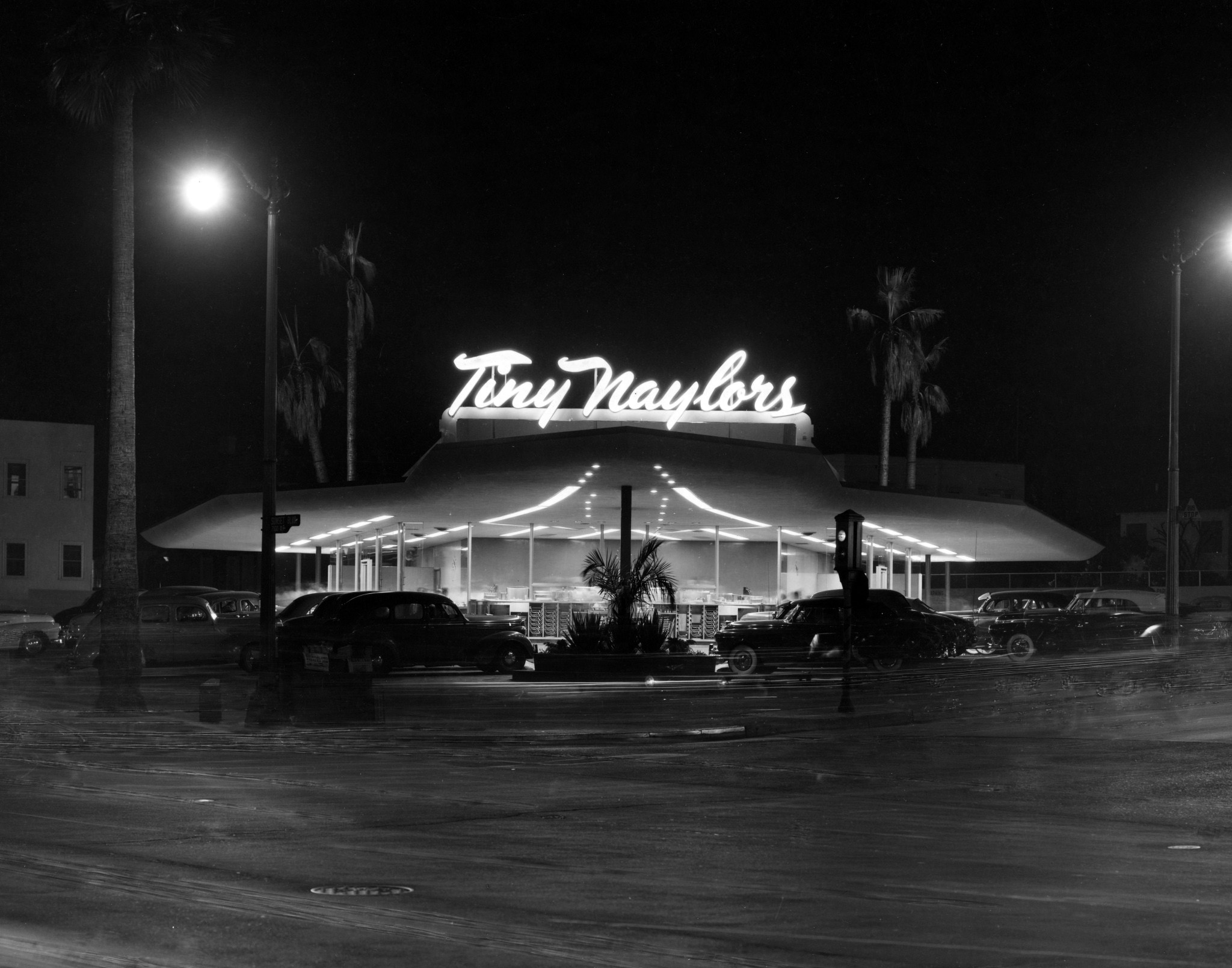 |
|
| (1949)^ – View looking toward the northwest corner of Sunset and La Brea showing Tiny Naylor’s Drive-in Restaurant. Note the old style traffic signal (semaphore traffic signal) on the corner. Photography by Marc Wanamaker–Bison Archives |
Historical Notes Tiny Naylor’s was also distinguished with its menu. Besides burgers and shakes, the menu at Tiny Naylor’s also included corn on the cob, ribs, steak, and baked potatoes—all of which were unheard of for a drive-in. Everything served at the restaurant was made from fresh ingredients, never frozen.^ |
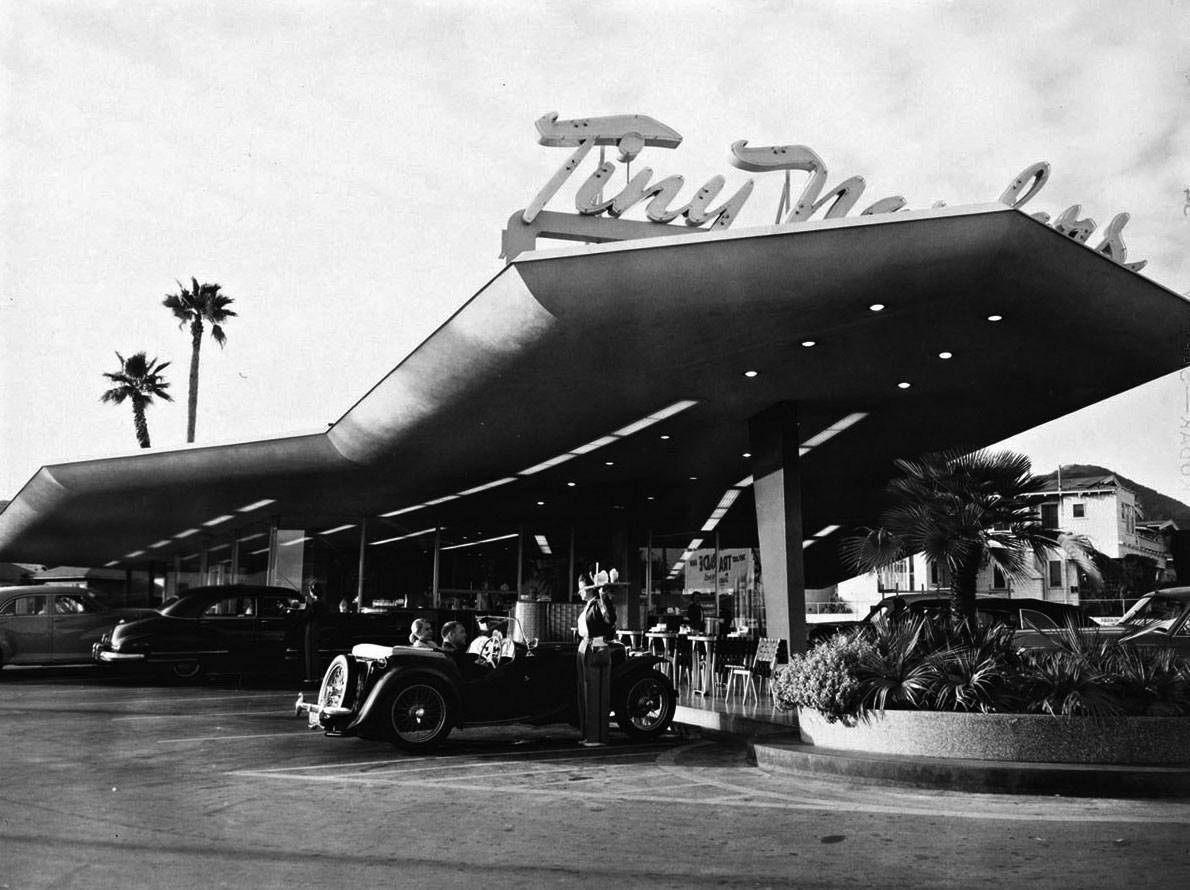 |
|
| (1952)* – View showing a couple in an MG being served by a carhop at Tiny Naylor's. Photo by Julius Shulman / Getty Research Institute |
Historical Notes The fabulous Tiny Naylor’s Drive-in Restaurant was built in 1949, from the mind of googie architect Douglas Honnold. He, along with John Lautner, also designed the Googie-style Coffee Dan’s on Wilshire Boulevard. Click HERE to see more on Googie Architecture. Douglas Honnold (1901 – 1974) was an award-winning Canadian-born American architect. He, along with John Lautner, designed the Beverly Hills Club. They also designed the Embassy Shop in Beverly Hills, which won an Honor Award from the Southern California Chapter of the American Institute of Architects in 1947. Additionally, they designed the Coffee Dan's Restaurant buildings on Vine Street in Hollywood as well as on Broadway in Downtown Los Angeles in 1946. Honnold is also known for turning down the offer to design the famous McDonald's golden arches.^ |
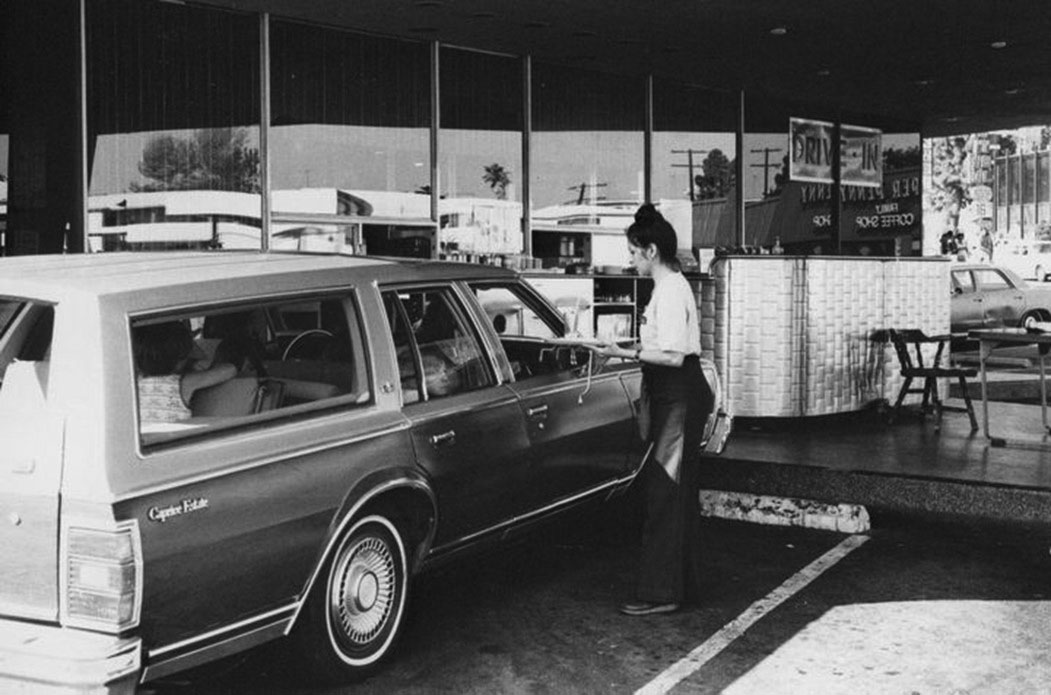 |
|
| (1970s)* - Family packed in a Chevrolet Caprice Estate station wagon being served at Tiny Naylor’s. Reflection in window shows Copper Penny Restaurant across the street. |
Historical Notes Although Tiny Naylor was best known for his Tiny Naylor's restaurant chains, his first restaurant was Biff's Coffee Shop – named after his son, in 1948. It was located on the corner of Cahuenga and Yucca in Hollywood. |
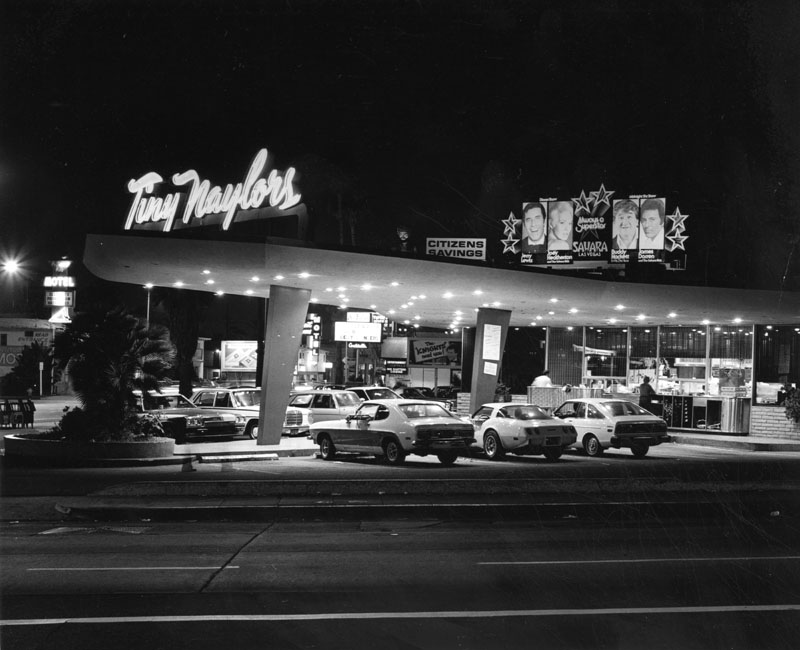 |
|
| (1980)* - Nighttime view of Tiny Naylor's Restaurant, located at Sunset Boulevard (left) and La Brea Avenue (foreground). Photo by Roy Hankey |
Historical Notes Unfortunately, Tiny Naylor’s went out of business in 1980 and the Googie-style structure was subsequently demolished to make room for a shopping center. The Naylor family is still alive and well in the restaurant business, however, with the Du-Par’s chain of restaurants. Today an El Pollo Loco stands at the corner where Tiny Naylor's once stood. Click HERE to see more Early Views of LA Drive-in Restaurants. |
* * * * * |
In-N-Out Hamburgers
 |
|
| (1948)* - In-N-Out Hamburger's 1st location, Baldwin Park, LA County. Although technically not a drive-in, In-N-Out is one of the more popular drive-thru restaurants in LA. |
Historical Notes In-N-Out Burger's first location was opened in the Los Angeles suburb of Baldwin Park, California, on October 22, 1948 by Harry Snyder and Esther Snyder at the southwest corner of what is now the intersection of Interstate 10 and Francisquito Avenue. The restaurant was the first drive-thru hamburger stand in California, allowing drivers to place orders via a two-way speaker system. This was a new and unique idea, since in post-World War II California, carhops were used to take orders and serve food. The second In-N-Out was on the corner of Azusa Canyon Road and San Bernardino Road, the third was in Pasadena and the fourth was opened west of the intersection of Grand Avenue and Arrow Highway in Covina, California, in the late 1950s. The company remained a relatively small southern California chain until the 1970s. The Snyders managed their first restaurants closely to ensure quality was maintained. The chain had 18 restaurants when Harry Snyder died in 1976, at the age of 63. In 1976, 24-year-old Rich Snyder became the company president after his father's death. Along with his brother Guy, Rich had begun working in his father's In-N-Outs at an early age. Over the next 20 years, the chain experienced a period of rapid growth under Rich's leadership, expanding to 93 restaurants. However, after opening store 93 In-N-Out in Fresno, California, on December 15, 1993, Rich Snyder and four other passengers died in a plane crash on approach to John Wayne Airport in Orange County, California. Upon Rich Snyder's death in 1993, Guy Snyder assumed the presidency and continued the company's aggressive expansion until he died from an overdose of painkillers in 1999. He was president for six years, expanding In-N-Out from 93 to 140 locations. His mother Esther subsequently took over the presidency. Esther Snyder died in 2006 at the age of 86 and passed the presidency to Mark Taylor, former vice president of operations. Taylor became the company's fifth president and first non-family member to hold the position. In 2010, Lynsi Snyder (daughter of Guy and only grandchild of Esther and Harry Snyder), assumed the presidency. Snyder does not intend to franchise nor sell and plans to pass on ownership of the company to her children. Today, there are 358 In-N-Out Burgers in California, Arizona, Idaho, Nevada, Utah, Texas, Oregon and Colorado.^ |
* * * * * |
Bob's Big Boy Drive-in (900 E. Colorado, Glendale)
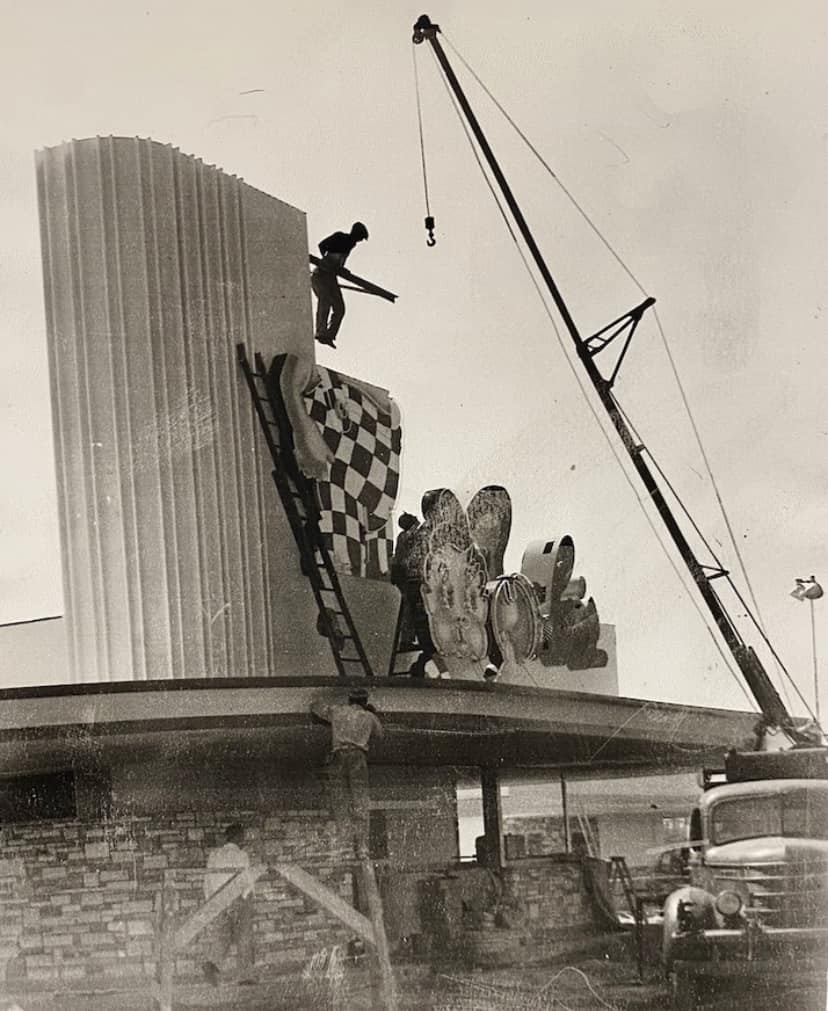 |
|
| (1940s)* - A man is dangling on a beam, waiting for the 'Big Boy' mascot sign to be raised and set at the new Bob’s Big Boy Drive-In located at 900 E. Colorado Street in Glendale. |
Historical Notes The original Bob's Big Boy, initially called Bob's Pantry, was founded by Bob Wian in 1936 at 900 E Colorado St, Glendale. This location started as a 10-stool hamburger stand and quickly grew into a full-service drive-in restaurant, becoming a local landmark with its eye-catching neon lights in the 1940s. |
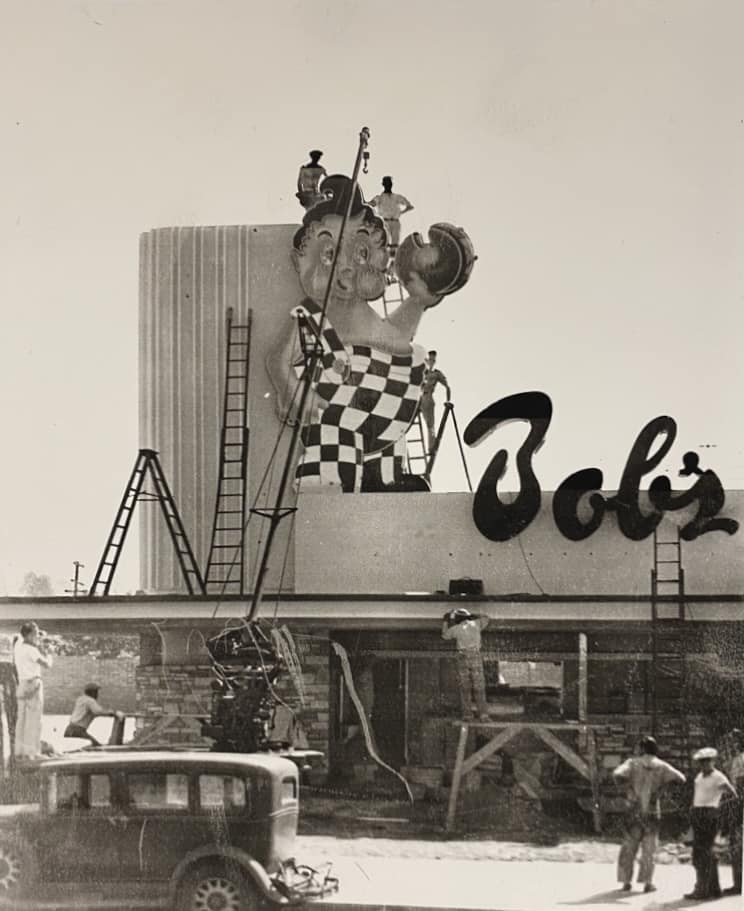 |
|
| (1940s)* - Workmen with wooden ladders and a vintage crane are pictured here, having just hoisted and secured the giant pieces of the Big Boy sign at the newly constructed Bob’s Big Boy Drive-in. |
Historical Notes The chain is best known for its trademark chubby boy in red-and-white checkered overalls holding a Big Boy sandwich (double-decker cheeseburger). The inspiration for Big Boy's name, as well as the model for its mascot, was Richard Woodruff (1936–1986), of Glendale, California. When he was six years old, he walked into the diner Bob's Pantry as Bob Wian was attempting to name his new hamburger. Wian said, "Hello, Big Boy" to Woodruff, and the name stuck. |
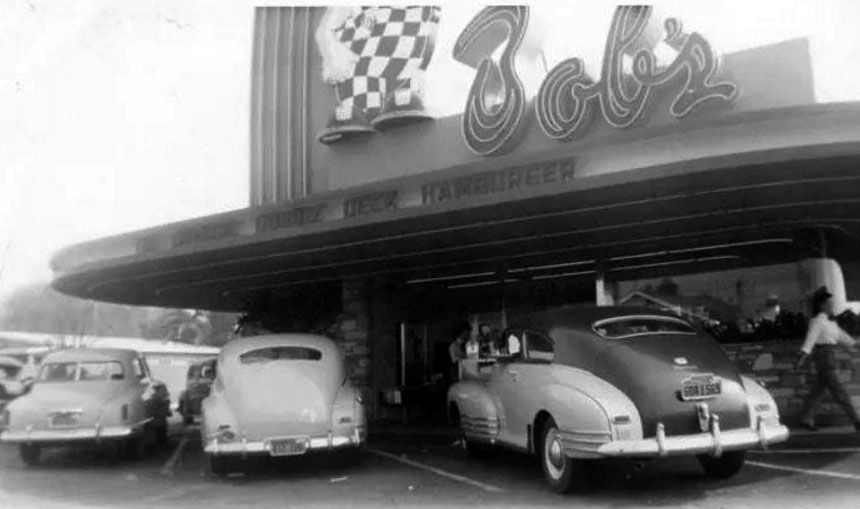 |
|
| (ca. 1949)* – View showing Bob’s Big Boy Drive-in restaurant located at 900 E. Colorado in Glendale. |
Historical Notes The Glendale location, like other Bob's Big Boy restaurants, became a cultural icon over the years. It served as a popular hangout spot for families, teenagers, and car enthusiasts, contributing to the local community's social fabric. |
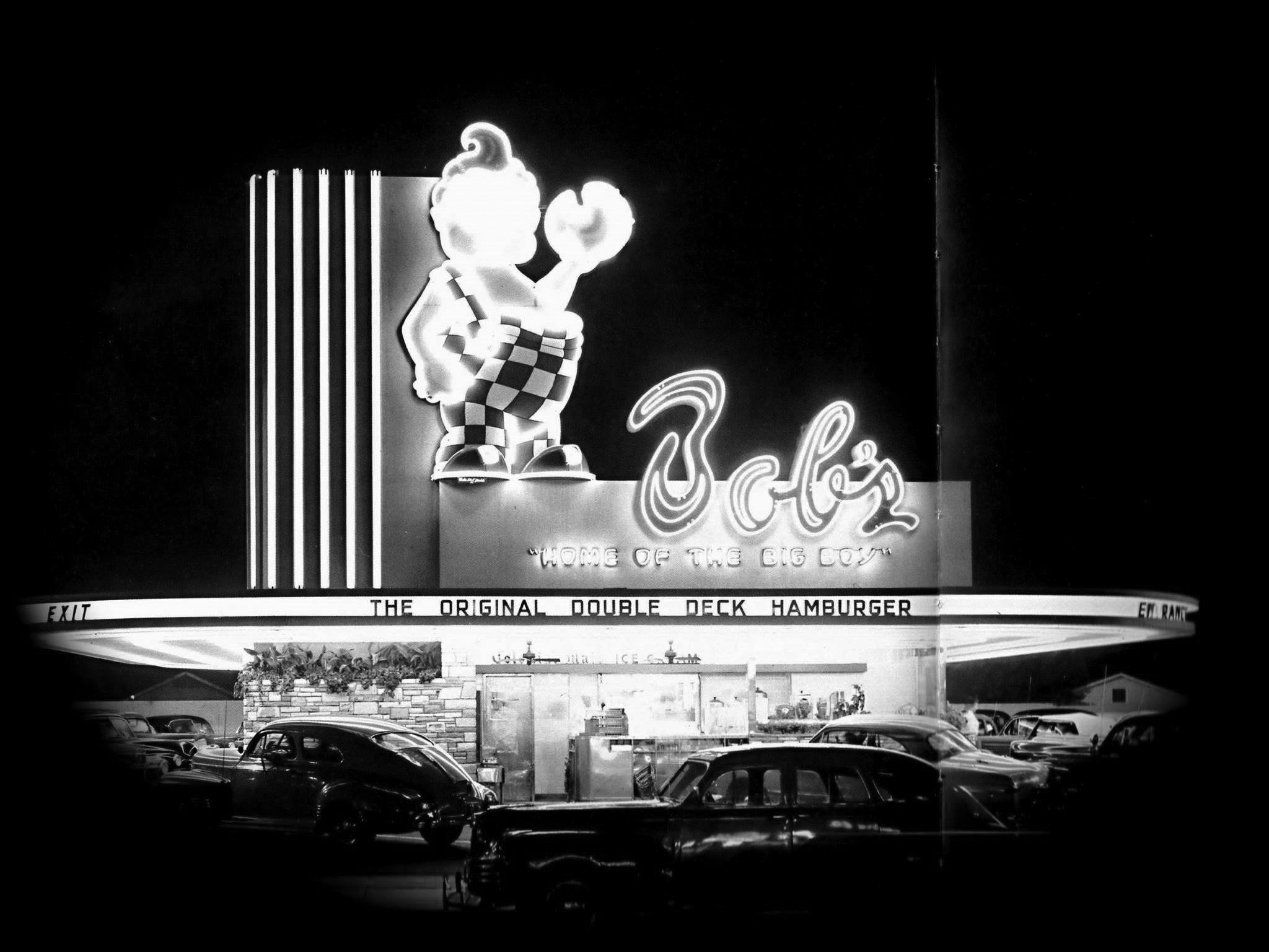 |
|
| (ca. 1949)* – Night view showing a very crowded Bob’s Big Boy Drive-in Restaurant at 900 E Colorado in Glendale. |
Historical Notes The architect behind the design of the original Bob's Big Boy was Wayne McAllister. McAllister was a renowned architect who played a significant role in shaping the iconic look of Bob's Big Boy restaurants. |
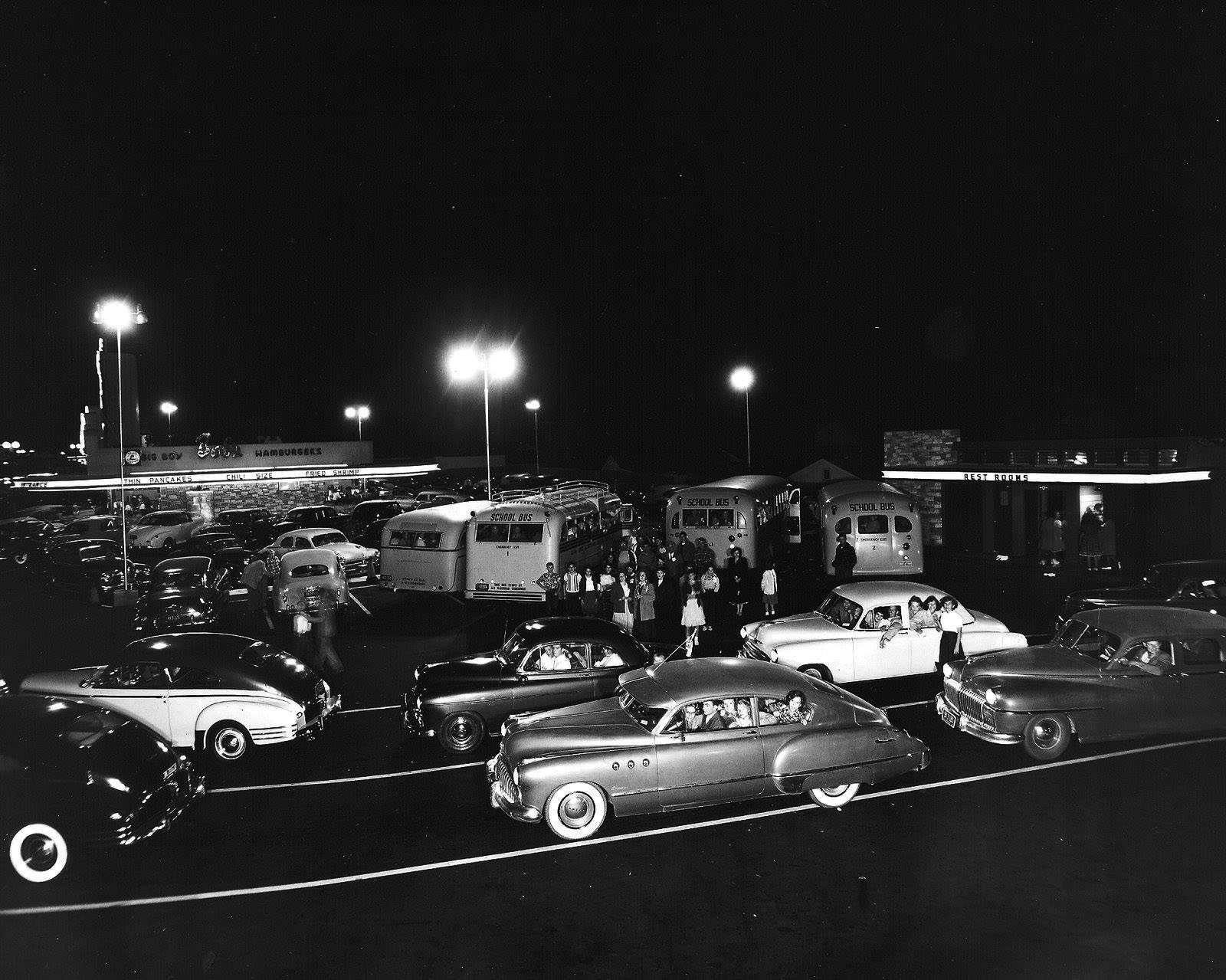 |
|
| (ca. 1950)* - Proof positive that Bob's was the place to be in the early 1950's! This picture shows the mob, and line of cars waiting to get into the "twin drive in and coffee shop" at 900 E. Colorado, Glendale. |
Historical Notes Bob’s Big Boy became a cultural icon for Glendale teenagers in the 1940s up until the 1970s. After the widely popular Glendale and Hoover High School football games, lines of cars filled with local students would eat at Bob’s Big Boy on Colorado Street. The original location at 900 E Colorado St was eventually demolished, and what stands there now is a typical Californian mini mall. Other Bob's Big Boy locations in Glendale, such as those at 3212 La Crescenta Ave and 115 W Broadway, have also been transformed and no longer serve as Bob's Big Boy restaurants. In 1967, Bob Wian sold Bob's Big Boy to Marriott Corporation for $7 million. At that time, the chain had already expanded significantly, and Marriott continued to grow it, reaching a peak of about 1,200 locations. However, by the late 1980s, Marriott sold the Big Boy trademark to Elias Brothers, who then faced financial difficulties, leading to a bankruptcy filing in 2000. Today, the Big Boy chain operates about 70 locations in the United States, with five of those in Southern California: Burbank/Toluca Lake at 4211 W. Riverside Drive, Burbank |
Bob's Big Boy Drive-in (4211 W. Riverside Drive, Burbank)
 |
|
| (ca. 1940s)^ - A carhop serving two customers sitting in an early model roadster at Bob's Big Boy at 4211 W. Riverside Drive, Burbank. |
Historical Notes This Bob's restaurant was built in 1949 by local residents Scott MacDonald and Ward Albert, and is the oldest remaining BOB'S BIG BOY in America. It was designed by renowned architect Wayne McAllister, incorporating the 1940's transitional design of streamline modern style while anticipating the free-form 50's coffee shop architecture. The towering BOB's sign is an integral part of the building design and its most prominent feature. Architect Wayne McAllister was inspired by the Space Age, World's Fair pavilions and roadside dining culture when he designed the building. Large, curving windows contrast with sharp angles, incorporating elements of Streamline Moderne and Midcentury Modernism.^ |
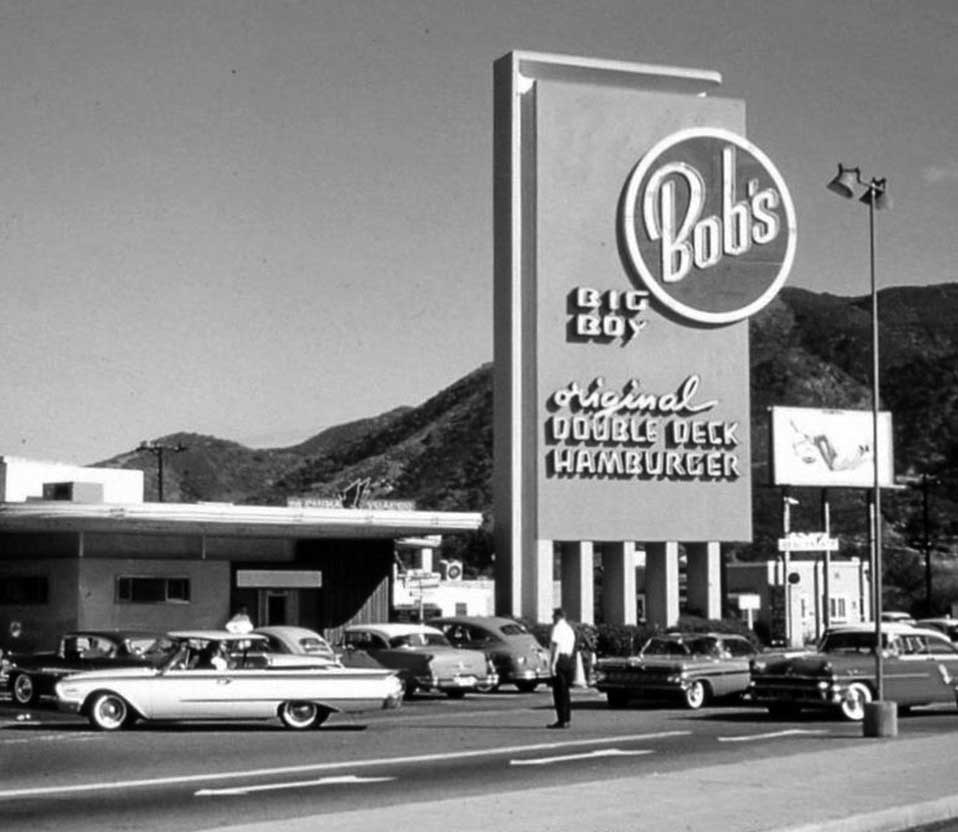 |
|
| (ca 1959)* - Bob’s Big Boy Drive-in Restaurant located at 4211 W. Riverside Drive. |
Historical Notes The restaurant was honored in 1993, receiving the designation as a "STATE POINT OF HISTORICAL INTEREST" by the State of California. The current owner (the MacDonald Family) acquired control of the restaurant in 1993 and began to restore it to its past glory. Click HERE to see contemporary view. |
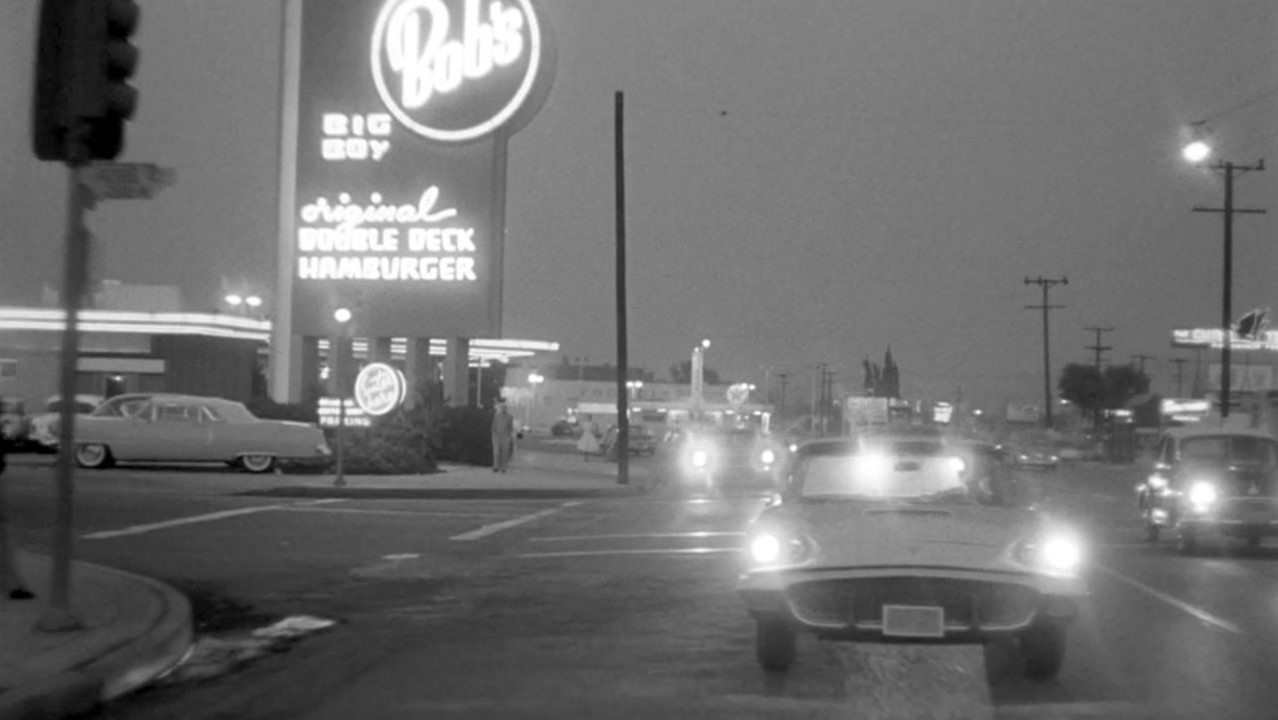 |
|
| (ca 1960)* – Cruising right by the iconic Bob’s Big Boy Drive-in Restaurant located at 4211 W. Riverside Drive. |
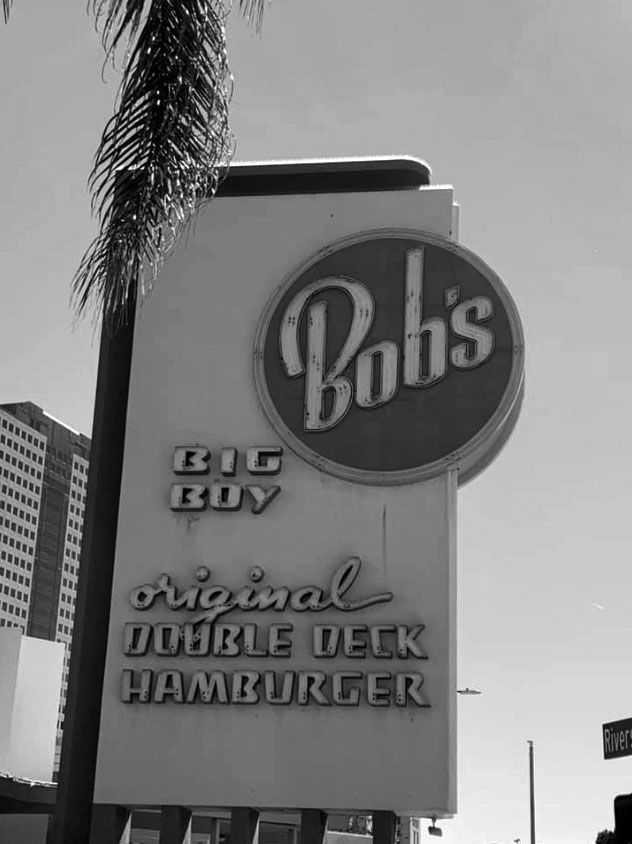 |
|
| (2019)^ - Bob's Big Boy, 4211 W Riverside Drive, Burbank. Built in 1949, it is the oldest remaining Bob’s Big Boy in America. |
Historical Notes In his design, Architect Wayne McAllister mixed the practical with the eye-popping. The 70-foot-tall neon sign, which made it easy for drivers to see the coffee shop from the road, was so distinctive it helped build the Bob's Big Boy brand. McAllister designed many popular restaurants including The Smoke House in Burbank and several circular drive-ins, all of which are now gone. He was also responsible for several early Las Vegas casinos including The Sands, The Desert Inn and The Fremont.^ |
* * * * * |
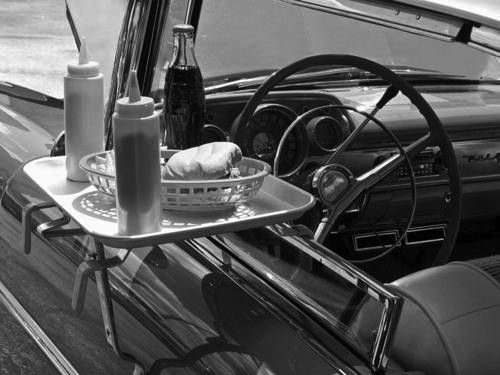 |
|
| (n.d.)^ - I'll have a hamburger, fries, and a Coke…..now that’s the way I like it! |
* * * * * |
More Historical Early Views
More Historical Early Views
Early LA Buildings and City Views
History of Water and Electricity in Los Angeles
* * * * * |
References and Credits
* LA Public Library Image Archive
** DWP - LA Public Library Image Archive
^* Oviatt Library Digital Archives
*^ Wikipedia
#* Flickr.com: Michael Ryerson
*# Skyscraperpage.com: Tiny Naylors
#^ Googie Redux: Ultramodern Roadside Architecture
++ History of Diners and Drive-ins
#+ Flickr.com: Scrivner's Drive-in
^^*Diner Hunter: Guinn's Coffee Shop and Drive-in
^^^Tropics of Metta: Art Laboe's Charmed Life on the Air
^x^South Bay Daily Breeze: Patmar's Drive-in Restaurant
^*#California State Library Image Archive
^##This Moderne Life: Simon's Drive-In
++^Coolculinaria.com: Mcdonnell's Drive-in
***Facebook.com: Bob's Big Boy
**^Pinterest.com: 1949 Drive-in Restaurant; Food Tray; Bob's Big Boy
**#Eating L.A. - Guinn's Coffee Shop and Drive-in
*#*Historic Los Angeles: Wilshire Boulevard
*^^Nuestra Señora la Reina de los Ángeles: losangelespast.com
^^#LA Times: 'Swing in, pig out, drive off'
#++Getty Images
##+Pinterest.com: Diner Style; Herbert's Drive-in
##*DailyMail.com: Glory Days of Drive-in Movies and Restaurants
*##RolandCommunications.com: Tam O'Shanter
+##LAIST: The Track Drive-in Restaurant
+#+Facebook.com: Garden of Allah Novels, Martin Turnbull
^^#*Huntington Digital Library Archive
*^^*Los Angeles: Portrait of a City
#*#*LA Curbed - Scrivner's Drive-in
#^**The Go Go's: Local Coffee Shops and Diners
^#^^Facebook.com - Vintage LA: Tiny Naylors
##**MartinTurnbull.com: Simon's Drive-in ; Willard's; Brown Derby
##^*Facebook.com: Classic Hollywood-Los Angeles-SFV
#**#Facebook.com: Garden of Allah Novels, Martin Turnbull
^^^^*Pinterest.com: Tinseltown
< Back
Menu
- Home
- Mission
- Museum
- Major Efforts
- Recent Newsletters
- Historical Op Ed Pieces
- Board Officers and Directors
- Mulholland/McCarthy Service Awards
- Positions on Owens Valley and the City of Los Angeles Issues
- Legislative Positions on
Water Issues
- Legislative Positions on
Energy Issues
- Membership
- Contact Us
- Search Index